- Philippines
- South Korea
- National Parks
- Travel Stories
- How Much Does It Actually Cost to Travel the World?
- What’s In My Backpack: The Ultimate Long-Term Travel Packing List
- My Favorite Non-Fiction Travel Books
- All Budget Travel Resources
- Writing Portfolio

Colca Canyon: Is It Worth It? (+ Tips To Hike It Independently)
This post may contain affiliate links. This just means I may receive a small commission at no extra cost to you for helping them promote their product or service. I don’t endorse any services I don’t personally use or recommend.
Peru is a punishing country. There’s just so much to do and see and ALL OF IT pushes your body to the limits. From the wildly unpredictable weather to the infuriating bugs to the sheer elevation- hiking in Peru is challenging. And Colca Canyon is all of the aggravating frustrations of Peru buttoned up in one exhausting package. Yet it’s one of the most popular hikes in Southern Peru and one of the few you can tackle independently to boot.
But should you hike the Colca Canyon?
Is the pain worth the gain?
I’ve got lots of opinions after spending 6-weeks in Peru and spending three-days hiking in the canyon myself.
What is the Colca Canyon Trek?
The Colca Canyon is the 3rd deepest canyon in the world. Arguably. There’s apparently a lot of controversy over what exactly constitutes a canyon. It sits about 3-4 hours (driving distance) outside of Peru’s white city- Arequipa. This makes the canyon an easy addition to everyone’s Peru itinerary.

The most popular way to explore the canyon is via a tour. But since the trails are simple you don’t really need one. Instead, you can take collectivos from Arequipa to the town of Cabanaconde where you’ll begin your 1, 2, or 3-day hike.
Collectivo Tip: You’ll actually get two collectivos. One from Arequipa to Chivay and the second from Chivay to Cabanaconde.
The Big Question…is Colca Canyon Worth it?
No, and I’ll tell you why.
Every step of this hike is cruel and unusual punishment. Flat does not exist in this landscape. Some real masochist carved this trail into one of the world’s deepest canyons. I get when you go down you must eventually have to go up when canyon hiking but you COULD have chiseled the trail along the river or canyon basin between the small villages. It would have made at least one of your trekking days easy. But no. Instead you’ll climb nearly out of the canyon just to descend once again.
Colca Canyon is a volatile desert sitting at 11,000 feet. You’ll battle sweltering heat, exposed trails, torrential downpours that cause landslides, painful descents, excruciating ascents, biting flies that swarm and create welts that later blister.
And there’s no “but” coming here.
You’ll endure all of this for NO REASON. Colca is most beautiful from the canyon edge in Cabanaconde. Condors soar so far out of sight you’re lucky to spot a single black dot. And the trail is rough. Straight up and then straight down.
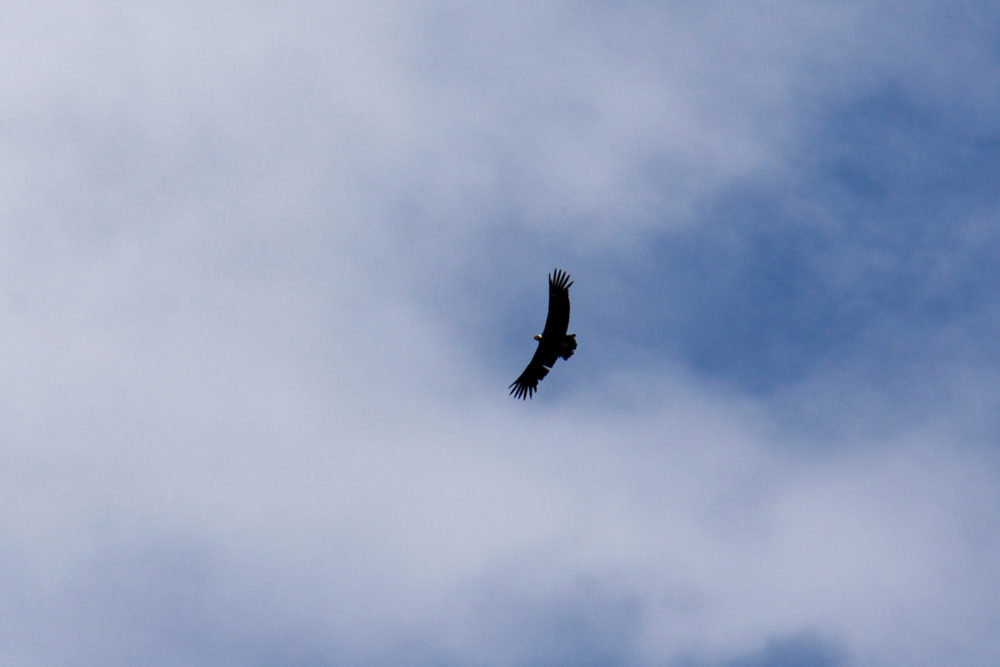
I know you’re in Peru but if your looking for similar vistas and WAY closer sightings of Condors just plan a visit to Pinnacles National Park in California.
If you’re looking for a more rewarding hike in Peru try one of these instead…

The Best Treks in Peru for Average Hikers
Peru is one of the top trekking destinations in the world. But you don’t…

Your Complete Guide to the Traditional Inca Trail (+ Best Tour)
Quite possibly one of our greatest travel adventures to date. A 4-day trek through…
But if you’re a glutton for punishment or simply not to be deterred…let me help you save your toenails (literally) .
Tips for Hiking the Colca Canyon Independently
You don’t need a tour. It’s not going to make the hike more enjoyable. In fact, you’ll often just have to either wait for others or push yourself to keep up. Going alone allows you to truly set your own pace.
But here’s what you need to know about hiking Colca Canyon on your own.
1. For the love of god leave early.
I cannot stress this enough. It gets toasty warm inside the canyon and you’ll want to finish your day’s hike before peak heat. You should leave no later than 6:30 AM each morning. If you choose to hike the ascent on the final day…some people leave as early as 3:30 AM.
2. Sunscreen and wide brim sun hat.
The canyon trails don’t offer a lick of shade. Not even a single tree. You’ll be 100% exposed to the sun’s rays at 10,000 feet your entire hike. I wouldn’t have made it without my sun hat and a strong SPF.
3. Bug spray lots of it.
I briefly mentioned the biting flies but you have to understand…these were the bane of my existence. The bites are itchier and last longer than mosquitos. Be prepared. And have a long-sleeve hiking shirt and leggings to fend them off for when the bug spray just doesn’t work.
4. Clip your toenails.
Weird suggestion, but stick with me. All this downhill hiking ravages your feet. If you don’t clip your toenails short not only will your feet be in excruciating pain by the end of the day but you might lose a toenail or two.
5. You don’t need to book accommodation ahead of time.
There are only a handful of accommodation options in each canyon town but there is rarely a shortage of rooms. Unless you’re visiting in the peak season you’ll be fine just walking up to get the best price.
6. Bring snacks and at least 1.5 liter of water per person.
There are no snack stands along the way. Not until you reach your destination for the evening that is. Start each day well-prepared. WITH AT LEAST 1.5 LITERS OF WATER PER PERSON.
7. Don’t hike alone.
Because of the nature of the terrain and the isolation of the trails (we didn’t see a single person the first 2 days), it’s not the best idea to hike alone…male or female. The concern is that you’ll run out of water or break an ankle and have no one to go get help.
If you do decide to hike alone, be sure to tell someone when you plan to be out of the canyon. Just in case.

8. Trekking poles would be a good idea.
As a backpacker, bringing trekking poles abroad seemed a little ridiculous. But in Peru, trekking poles would be an excellent idea. There’s enough hiking to warrant the extra weight. This hike in particular is all steep uphill and downhill which would be made a lot easier with poles.
New to Backpacking? Here’s my complete backpacker packing list.
9. Cash is king.
There are no ATMs in Cabanaconde. I REPEAT. THERE ARE NO ATMS IN CABANACONDE OR THE CANYON. This means you’ll need to bring enough cash from Arequipa (or Chivay) to sustain your entire trek. You’ll need cash for meals, lodging, and everything else in the canyon.
& it wouldn’t hurt to bring enough extra in case you decide you don’t want to walk out of the canyon yourself. *Spoiler* we ended up riding mules out of the canyon.
10. Pack Light. Here’s a quick example packing list for 3 days.
- 2 Pairs of Leggings.
- 1 Lightweight Long-sleeve Shirt
- Hiking Boots
- Swimsuit (NEED)
- Bug Spray, Sunscreen, Itch Cream, Ibuprophen, Band Aids, Neosporin
- Lifestraw Filter Water Bottle
- Trekking Poles
Have I Officially Scared You Away From the Canyon?
Consider joining a group tour. Bookmundi Partners with sustainable tourism operators like Alpaca Expeditions and GAdventures in Peru scoring you deals that are both good for you and the planet. Maybe, the canyon would have been more enjoyable done this way.
What Does Colca Canyon Cost?
We spent $180.13 over three days as a couple. Here’s a quick breakdown. **Not including the cost of the mules.**
Cost of 2 Collectivos & 1 taxi to collectivo station from Arequipa to Cabanaconde: $17.50
7-day Entrance Permit to the Colca Canyon: $17.29/ per person.
One night stay in Cabanaconde: $14.82
Food in Cabanaconde (beer, groceries, water): $9.88
One Night in Llahuar Hostel: $15
Food in Llahuar (+ 3 beers and gatorade): $31.43
One Night in Sangalle Accommodation: $13
Food in Sangalle + 2 beers: $26.51
Cost of 2 Collectivos & 1 taxi to collectivo station from Cabanaconde to Arequipa: $17.50
This is a good estimate of how much you might spend while in the canyon for three days. We each ate breakfast, lunch, and dinner at the lodging and drank our fair share of beer at night. In total, we spent about 730 soles. I would bring 1,000 soles just for emergencies.
Obviously, buying food and beer at the oasis is expensive. But the only other alternative is to pack food and that extra weight sucks.
The Best Way to Hike Colca Canyon
Spoiler: We didn’t hike the *best* way.
If I were to hike it again this is what I would do instead…
The Savvy Backpackers Route (Option 1)
If you have a burning desire to see this canyon I get it. We did. We wouldn’t do it again. But we did it. This is how we WISH we had done it if we had all the info.
Day 1: Collectivos from Arequipa to Cabanaconde (Sleep Here)
We loved our cozy room at Arun Qurpuwasi Hospetage .
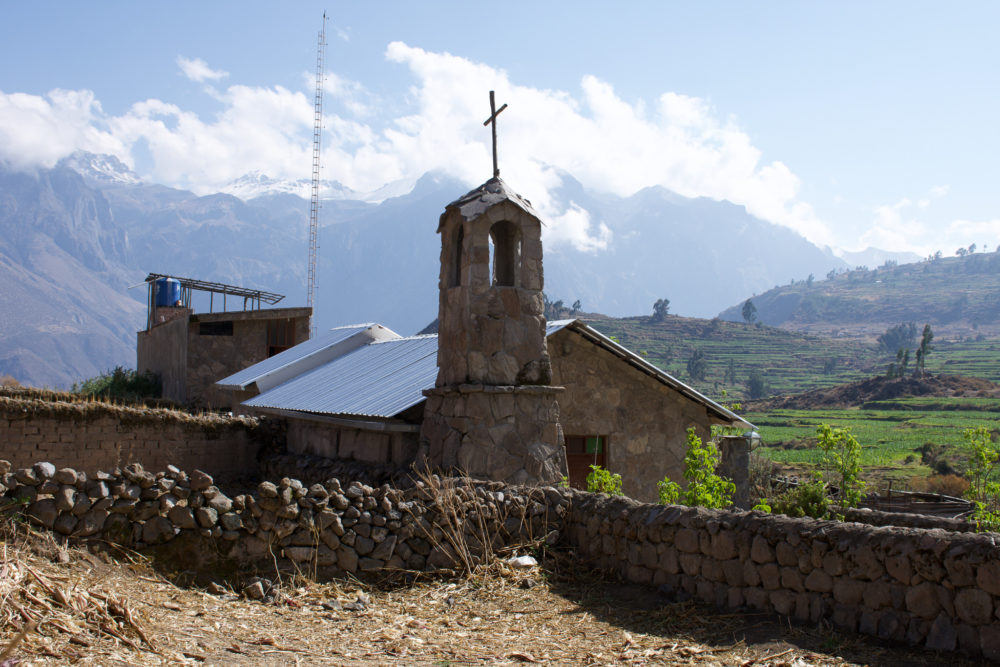
Day 2: Hike Cabanaconde to Sangalle (5k)
Sangalle is an oasis town. It’s the most popular canyon town and we can attest to its beauty. It’s lush green and on the canyon floor. You’ll have to descend a knee-breaking 4,000 feet of switchbacks on slippery shale trails to get there BUT then you can dive into the refreshing pools and recuperate all day.
Day 3: Hike Sangalle to Llahuar (10k)
Llahuar is teeny but known for one thing- hot springs. Really pretty and much-needed riverside hot springs. There are only 2 places to stay and during my visit, only the Llahuar hostel had access to the hot springs.
& then take the 3 AM bus from Llahuar back to Chivay .
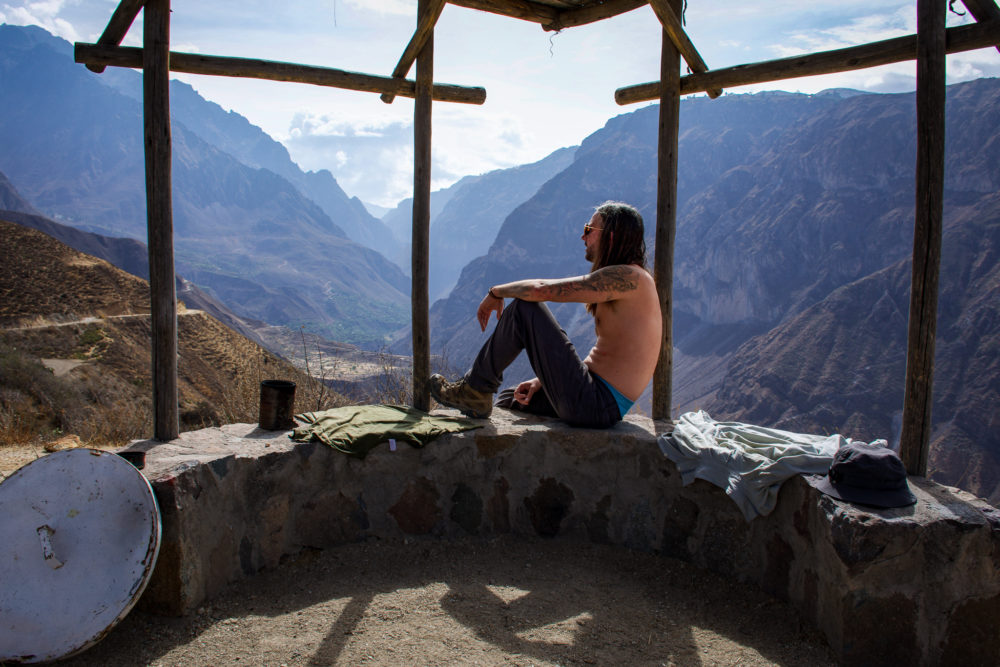
FOR THE LOVE OF GOD. DON’T HIKE OUT.
Climbing 4,000 feet (in elevation) out of the canyon is downright miserable. And from Llahuar unnecessary. Trade your 11k of exposed switchbacks for an early wake-up call instead. You can take a local bus from Llahuar to Chivay for 15 soles. Seriously, save yourself. You’re not missing any views on this part of the trail.
The Viewpoint Traveler (Option 2)
Maybe you’re not really into the “hiking” part of Colca Canyon but you still want to see the world’s 3rd largest canyon and spot a condor along the way. I’ve got the perfect 2-day plan for you.
Day 2: Hike one mile outside of Cabanaconde to the mirador and return to town.
I’m not gonna lie to you. The portion of the trail just outside Cabanaconde is the only pleasant moment we had in 3 days. You’ll be blessed with stunning views along the drive including Vicunas in the nature reserve and panoramic vistas of small mountain towns. On a sunny day, Cabanaconde is even quite nice.
& you won’t have to enter the god-forsaken canyon that makes grown-ass seasoned hikers cry.
Yes, this option involves a lot of time in collectivos and very little hiking. But I think that regardless of whether you choose to hike the Colca Canyon or not, it’s worth seeing , at the very least.
Now you know my professional opinion about the Colca Canyon in Peru. Although I wouldn’t dare do it again… in hindsight, I am happy that I got to experience Colca Canyon. Even if it was miserable almost every step of the way. There’s just so much incredible hiking to be done in Peru and although Colca is worth a mention..it’s not at the top of my list.
Feel free to drop your recommendations or thoughts on whether the Colca Canyon was worth it in the comments!
Save Now, Read Later!

Further Reading...

A Tour Of Lima’s Illegal Settlement & Local Markets

The Best Budget-Friendly Peru Itinerary (6 Weeks)
No comments, leave a reply cancel reply.
Save my name, email, and website in this browser for the next time I comment.
Notify me of new posts by email.
Sign up to our newsletter!
This site uses Akismet to reduce spam. Learn how your comment data is processed .
How To Spend 2 Days in Tayrona National Park (& Is it Worth the Hype)
Beyond_the_bucketlist.


- Colca Canyon Trek: The Best Route
Disclaimer : We may receive a small fee for any purchases made through links in this post. Learn more
Welcome to our guide to the best Colca Canyon trek. We know that sounds a bit boasty, but we honestly wouldn’t have changed a thing about the route we took around Colca Canyon Peru.
Unless you’ve literally just landed in Peru without having done any prior research at all, you’ll already know that to visit Colca Canyon is one of the top things to do in Peru in general. Especially if you’re into your hiking.

However, here’s the catch when it comes to this Colca Canyon guide, you need to allow yourself 5 or at a push 4 days. We understand everyone might not have that amount of time to dedicate, but if you can we promise it will be worth it.
Best Colca Canyon Trek
Now there’s a few guides to visiting Colca Canyon on your own online, but when we were planning our Colca Canyon trip we found them either lacking in useful information or far too convoluted that they left us feeling overwhelmed.
And so we’re going to do our best here to present our Colca Canyon information in the clearest way and give you exactly what you need to know without the waffle.
Independent Trek Vs Guided Tour
Okay, before we get into the nitty gritty the best Colca Canyon trekking route let’s just address why you should do this independently over a guided tour. But also reasons why it might be more appropriate for you to do a Colca Canyon tour with a guide.
Firstly, if you’re moderately fit there’s absolutely no reason you can’t trek Colca Canyon on your own. The trails are well marked (for the most part) and it’s not a technically difficult hike.

You have a lot more flexibility over your route, where you stop off and what time you start each day. Plus it’s also going to be ALOT cheaper.
However, if you’ve never done a multi day hike before, aren’t in the best shape, travelling solo and wanting to meet people, or would just prefer to have a guide with you as back up, a Colca Canyon tour is going to be more your style.
You can check out some options and compare prices here:
- Colca Canyon Day Trip
- Two Day Colca Canyon Trip
- Three Day Colca Canyon Trek
Just do check the exact itineraries, because some include less hiking than others.

Still trying to choose your backpack? Look no further! The Osprey Farpoint 70 Travel Backpack is perfect for big trips. It’s lightweight but durable, incredibly comfortable, super spacious and even has a detachable daypack.
Our Colca Canyon Hiking Route
In summary here’s the 5 day/4 night route for hiking the Colca Canyon Peru.
Cabanaconde – Llahuar – Fure – SanGalle Oasis – San Juan de Chuccho – Cabanaconde.
But here’s the route with more detail, including distances, times, recommendations on where to stay and details on the terrain.
Day 1: Cabanaconde – Llahuar
Distance: 11km Time: 4 hours Stay at: Casa De Virginia
The first part of the path on day one of our Colca Canyon trek was relatively smooth and there’s some glorious views straight out of the box.
Especially at Mirador Achachiwa. That’s where you get a real understanding of the Colca Canyon depth and the scale of the challenge you’re about to undertake.
And if you’re in any doubt at all starting the hike, perhaps thinking to yourself ‘is the Colca Canyon worth it?’ You’ll find your answer here with a big resounding yes.

From there the route winds downhill to a small river crossing. Then the hard work starts. Because from there it’s a long drawn out ascent for a good few kilometres. From there it’s mostly downhill, as you descend along the winding seamingling endless switchbacks.

It’s a pretty tough introduction. Not because you’ll be particularly out of breath often, just because going down on such steep trails for so long is rough on your knees. However the scenery is so stunning that’s really all you’ll be focusing on.
And it’s also broken up by another river crossing over the mighty Rio Colca and a beauty of a geyser called Geiser de Paclla.

For the last part of the day one leg of this Colca Canyon hiking route, you’ll drop down onto a larger ‘road’ and pass through a small village. Then as you get towards your last kilometre you’ll be able to spot Llahuar in the distance, crossing a final bridge over Rio Huaruro.

But with tired legs and aching knees, perhaps the best part of day one of this Colca Canyon trekking route is to come. Because waiting for you in Llahuar are the natural hot springs of Aguas Termales de Llahuar.

Unfortunately during the rainy season, as was the case for us, it’s not possible to go in the ones right next to the Rio Colca because the water is just too high. But at the place we recommend to stay at, Casa Virginia, they have their own thermal pools with epic views out over the valley.
Day 2: Llahuar – Fure
Distance: 6km Time: 3 hours Stay at: Fure Wassi Hostel
Day two of our epic route for hiking Colca Canyon without a guide gets off to a more difficult start as you’re straight onto a steep uphill climb.

The path then flattens out a bit but there’s a couple of sheer cliff faces you’ll pass where you need to look up and move quickly as falling rocks are common, especially in the rainy season.
We were slightly worried when we first heard about this but in reality they were small sections and we were able to pass quickly without incident.
From there you’ll pass by the village of Llatica and go down into the bottom of Colca Canyon to cross back over Rio Huaruro. This is one of the most beautiful parts of the Colca Canyon trek and quite possibly our favourite part of the whole 5 days.

Then you’re back on the uphill all the way to Fure, where you’ll be staying the night.
Day two is a much shorter distance than day one. But because you’re ascending for most of it, you’ll likely need to stop often to catch your breath, drink some water and rest your calfs..
When you get to Fure, your days hiking isn’t done though!
However, if you check into Furewassi Hostel first, you can leave your bags before heading up to check out Huaruro waterfall.

It’s hard to describe the scale and sheer power of Catarata Huaruro, it’s simply incredible and a must see for things to do in Colca Canyon.

It took us around 45/50 minutes to get there and 35/40 minutes on the way back. It’s an easy enough walk mainly uphill, but not too steep until you get towards the very end.
Just one thing to be aware of, because there’s so much spray coming off the tumbling water, the paths near the falls can get quite muddy. And because it’s the steepest part you should take extra care, especially on the way back.
This is the most remote part of the Colca Canyon Peru and in part is what makes this 5 day trekking route so special. The accommodation was understandably the most basic here, but the scenery around Fure in just something else.
Day 3: Fure – Sangalle Oasis
Distance: 11km Time: 5 hours Stay at: Paraíso los Palmeras Lodge
The first part of the route from Fure to Sangalle Oasis is fairly easy, it’s pretty much just a steady uphill winding path around the mountain side until you each a wider path.
From there you’ve got a good few kilometres on the flat until you reach the point where you need to descend down into the Colca Canyon Oasis.

The easiest way is to continue along the main path until you reach a village called Malata from which you’ll swing a right and come back on yourself to start your descent.
Another option, which is the one we choose, is to head off down one of the seriously steep smaller paths before you get to Malata.
These aren’t well worn paths and there are times when we just found ourselves surrounded by a sea of cacti. But what’s an adventure without getting lost one of twice. And you can clearly see the zigzag intersection that you need to get too – it’s just a case of getting there.
At the top of the steep downhill zigzag path into Sangalle Oasis you’ll find a beaut of a lunch stop with some shade and seating called Mirador Ccarecna. It’s a really pretty outlook and trust us you’ll need to fuel up for the downhill climb.

The good news about the descent into the Colca Canyon Oasis is that with every switch back your destination and the inviting swimming pools you can see get that little bit closer. Another thing you’ll notice on your way down is how humid it starts to feel.
And as you approach the bridge at the bottom crossing Rio Colca you’ll start to see just why this favourite spot in Colca Canyon Peru is called an Oasis. It looks like something out of the film Avatar, it’s just so beautiful.

Once over the bridge, you’ll head up a short incline and start passing the Sangalle Colca Canyon accommodation options.
It’s tempting once you get anywhere near the lush swimming pools to just jump straight in the first one, but we urge you to hold out until Paraíso los Palmeras Lodge which a little further along and down a short leafy decline.

We absolutely loved our stay there and could have easily stayed more than one night. It was of course off season so not as packed as it gets with tour groups during peak season.
We’ve heard people recommend giving this spot a miss when hiking Colca Canyon without a guide but it’s so gorgeous, you can see why it draws a crowd. And so what if you have to share it, it wouldn’t make the surroundings any less impressive.

And you might be hankering after some pals to chat to after the last few days in the more remote parts of Colca Canyon Peru.

Travel towels are insanely versatile, doubling up as everything from a beach rug or yoga mat to a sarong. This one’s lightweight, super absorbent, quick-drying & soft on your skin, don’t hit the road without one.
Day 4: San Galle – San Juan de Chuccho
Distance: 5km Time: 3 hours Stay at: Posada Gloria
First thing on day 4 of this Colca Canyon trekking route sees you heading out from Sangalle Oasis the same you went in. Only it doesn’t seem half as hard at the start of the day and you’re at the top of the steep switchbacks before you know it.

From that point there are two paths that you can take onto your next overnight stop in San Juan de Chuccho. There’s a slightly longer route that runs through a village called Malata and then descends down into San Juan, crossing a small river by a bridge.
Your other option, instead of heading up to the main road, is to follow a smaller path directly from the top of the Sangalle point of descent.
This is the way we went and it was an adventure alright. The path is less worn and it’s easy to get lost in a few parts, which we did. Having to climb down terraces and over walls to get back on track. Make sure you have a map downloaded if you go this way.

Then there was the river crossing. We reckon throughout the dry season it’s more of a stream and isn’t as deep or fast flowing. But we had to take off our shoes and trousers to make it across without getting soaked, clinging onto a branch so as not to get washed away.
After that we got lost a few more times, again because the route isn’t so clear and GPS doesn’t always have you in the right location. But we found San Juan de Chuccho and Posada Gloria eventually and if we did, you will too.

Just maybe take the Maleta path in the rainy season if you’d prefer a little less intensity.
Day 5: San Juan de Chuccho – Cabanaconde
Distance: 9km Time: 3.5 hours
Your last day on the Colca Canyon trek and it’s unfortunately time to head out of the Colca Canyon altogether. We’d heard that the ascent out of Colca Canyon is so hard that it makes some people cry.
But the only thing we felt like crying about was the fact that our grand adventure was over.
You’ll start the day descending down to once again cross the Rio Colca over San Juan bridge. It takes around half an hour to reach this point.

Then the climb starts and aside from a few short flatish sections, you’re on an upward switchback path for the next few hours. The thing that makes it most difficult is the altitude that you’re ascending too. You’ll notice it harder to breath even when you stop momentarily.
But looking out over the immense landscape and being able to see all the trails over the other side that you’re walked over the last few days is seriously rewarding.

Once you are at the top, you’ll pass a ticket inspector and then it’s just a short way to the main road and 15/20 minutes from there back into Cabanaconde.
We were super lucky because just as we reached the road a minivan bound for Chivay with empty seats was passing so we jumped straight on it.

There’s a section below on how to get to Colca Canyon.
Just to mention once more, if any of this doesn’t sound like something you are comfortable with, check out these guided Colca Canyon Tours.
Colca Canyon Map
You can pick up your own Colca Canyon trekking map at the tourism office in Arequipa, it’s just on the main square. But we’d also highly recommend downloading a map of Colca Canyon on Maps.Me that you can use offline with GPS in case you do get lost at all.

Alternative routes
To make the route shorter (4 days/3 nights) you could miss out staying the night in San Juan de Chuccho on the last night & head straight through there & on up to Cabanaconde.
To make the route even shorter (3 days/2 nights) you could miss out Llahuar altogether (although why would you? There’s hot springs – duh?!) and go straight to Fure. There is an alternative slightly more direct route that’s signposted.
It will be a long day though and you’ll need to start early so travelling from elsewhere the same day won’t be possible.

Other options are to just do a loop from Cabanaconde – San Juan de Chuccho – SanGille Oasis. There’s a route back up to Cabanaconde from the Oasis.
But just be aware you’ll be missing out on the best parts of the trek which are the hikes from Llahuar to Fure and to the Huachucos waterfall. And the Paclla Geyser. Oh and the Colca Canyon hot springs – we mentioned those right?
You could also do this Colca Canyon map route in reverse, however we wouldn’t recommend it. The route between Llahuar and Cabanaconde is a long one and doing it uphill wouldn’t be fun.
Better to have that as your descent and use the shorter route from San Juan de Chuccho to Cabanaconde for your ascent.

Not found the perfect travel camera yet? We have. The Olympus Tough Tg-6 is waterproof, shockproof, dust proof, crush proof & freeze proof. But best of all it takes awesome photos with very little skill required.
Colca Canyon Entrance Fee
There are three entrances into Colca Canyon from Cabanaconde and at each one you’ll find a ticket seller. The entrance fee for trekking Colca Canyon with or without a guide is the same, 70 soles per person.

The Colca Canyon permits last for 5 days – which is perfect for this Colca Canyon guide. And you need to keep them as all though you’re unlikely to get asked for them on the actual trail, you will on your way out.
They also cover you for the Mirador Cruz del Condor if you choose to stop there on your way in or out of Cabanaconde.
Condors in Colca Canyon
The two times we passed the specific Condor viewing spot on our Chivay to Colca Canyon minivans they spotted momentarily here to let passengers on or off and we didn’t see any obvious condors soaring nearby.
Now of course we might not have been there at the optimum time, however what we can you is that we saw plenty of condors on our way in and out of the canyon anyway.
The main tourist buses stop here as standard – more on those below. But if you’re taking a minivan you’ll have to jump off and then wait for the next one and hope they have space.
So if you’re travelling by minivan, unless you are desperate to stop at this Colca Canyon watching spot we wouldn’t bother.
Hotels in Colca Canyon
First and foremost, you do not need a tent. In fact there are very few places that you can safely camp. Each town has at least one Colca Canyon accomodation option.
Everywhere we stayed was basic but comfortable and surprisingly had WiFi and electricity. If only for a few hours in the evening in some places. Some Colca Canyon hostels have private bathrooms as an option, some don’t.

Food wise it’s mostly veggie, there was only meat as an option at the last place we stayed at. Evening meals are a soup starter, a main and then a tea. Served at 6:30 or 7pm. The meals we had were all pretty carb heavy which was welcomed after the exertion.
Breakfast you can have when you choose between 6-8am.

You can buy drinks (water/soft drinks) at each place and most have small shops too where you can buy extra snacks. The one in Fure even had cans of Tuna and fruit while we were there.
We recommend booking your hotels in Colca Canyon in advance. In high season so you know you have a place to stay & in low season so they know to expect you, not everywhere is fully open all year round.
Just as a quick reminder here’s the places we stayed at which we recommend:
- Llahuar: Casa De Virginia
- Fure: Fure Wassi Hostel
- San Galle: Paraíso los Palmeras Lodge
- San Juan de Chuccho: Posada Gloria
Colca Canyon Cost
In total our independent 5 day Colca Canyon trek, for 2 people, minus beers (which are of course optional) cost us 556 soles (or 278 soles per person). That’s about $80 USD or £63 each.
Here’s a complete Colca Canyon cost breakdown:
- Colca Canyon hiking permit which lasts 5 days = 70 soles each.
- Colca Canyon accommodation for 4 nights = 130 soles for double private rooms.
- 3 x breakfasts that weren’t included in accommodation cost = 30 soles each.
- 1 x lunch on 4th day = 20 soles each.
- 4 x evening meals = 58 soles each.
Aside from that our only other cost was our lunches and snacks that we bought at the market in Arequipa before the trek. We spent 70 soles on that. Details of exactly what we took are down below.

If you do fancy a beer or two of an evening, all the places we stayed at in the Colca Canyon had them available. Of course they’re more expensive than outside the canyon because a donkey has had to yank them in, but they’re not ridiculous.
Prices ranged from 9-12 soles for a large bottle of Arequipeña.
Colca Canyon Packing List
- Portable powerbank
- Cash – there’s no ATM’s
- Water filter bottle
- Plus 1-2 litre flask for extra
- Warm clothes for evenings
- Quick-dry towel
- Raincoat [ Women | Men ]
- Waterproof bag cover
- Antibacterial hand gel
- First aid kit
- Toilet roll – most hostels don’t provide this.
- Multi-plug adaptor
- Maps.Me downloaded

Aside from that you’re going to want what you’ll be wearing during the day. We each took 2 pairs of bottoms, 3 T-shirt’s, 5 x underwear and good socks [Women | Men ].
And then obviously soap, toothbrush, toothpaste, hairbrush & all that jazz.
For the evenings don’t forget something to do either, especially in low season when there’s not many other tourists around to chat too. We took our kindles and a pack of cards.
Footwear wise we always hike in trainers, they’ve never let us down so far and they didn’t on the Colca Canyon trek. If you do have and prefer to wear hiking boots obviously do. This is just a note to stay they’re not necessary.
Lunch and snack wise we went with the following and it was the perfect amount:
- 3 x cans of tuna, bread and a small packet of mayonnaise for the first 3 days.
- Roasted corn, plantain chips, raisins, almonds and cashews.
- Box of granola bars.
- 2 x oranges and 2 x small mangos.
Our backpacks weighed 12 kilo and 6 kilo. Obviously they got less throughout hiking Colca Canyon as we ate our lunches and snacks up.

We always travel with a filter water bottle. Not only does it stop us getting ill, but it means we’re not killing the planet or wasting money on plastic bottles. The GRAYL Geopress is hands down the best on the market & makes water from virtually any source safe to drink.
Colca Canyon Weather
Hands down you’ll have better weather in Colca Canyon during the dry season (May-October). But by better weather we also mean hot weather, because there will be little cloud coverage and pretty much all the paths are completely exposed.
Also because you’re hiking at altitude you’re also closer to the sun so even the Colca Canyon temperature doesn’t feel so hot, it is.
You won’t have the scorching sun during the rainy season (November- April) but what you will have is rain and lots of it. While we were hiking the Colca Canyon during February the rain started each day around 2pm and then just kept going until about 5am the next morning.

Which although sounds pretty dismal was completely fine because by setting off early on the Colca Canyon route we did, we were pretty much done each day by the time the rain started rolling in.
Another perk of doing the Colca Canyon hike during off season is that it is way less busy. We didn’t see anyone except the odd local farmer for hours on end on the trails. And the places to stay in Colca Canyon are not only cheaper but also quieter.

Especially SanGalle Oasis, which is the most popular place that tour groups visit.
But what you do have to be careful of during Colca Canyon rainy season, particularly along the route from Llahuar to Fure and the ascent from San Juan de Chuccho is falling rocks. You need to look up & go quick in a few sections.
So in either season there’s pros and cons, but you can definitely hike Colca Canyon all year round.
Colca Canyon Altitude
If you’ve just arrived in this part of Peru of haven’t spent much time at altitude directly before it’s a good idea to take a couple of days to acclimatise. Because even though at its deepest point the Colca Canyon depth is 3,270m/10,730ft, the altitude there is still 1,066m/3,497ft.

And actually on this route, the lowest altitude you’ll be at is 1,900m/6,232ft in Sangalle Oasis. Llahuar is at 2,020m/6,627ft, Fure at 2,900m/9,514ft and San Juan de Chuccho 2,439m/8,002ft.
Yep, the altitude in Colca Canyon is serious.
And Cabanaconde, where you’ll be starting and ending is at a whopping 3,287m/10,784ft.
The only real cure for Colca Canyon altitude sickness is to get to a lower altitude, but coca leaves either chewed or in tea will help. As well as staying well hydrated, avoiding alcohol and getting enough sleep.
Colca Canyon Trek Difficulty
If you’re moderately fit, the only real difficulty you should experience is the altitude in Colca Canyon. That is if you haven’t taken time to get used to it.
Sure there are a few really steep sections and a few sections that seem to go on forever when you’re in them, but with a positive attitude, some grit and determination you won’t struggle.
We didn’t hike the Colca Canyon with walking poles but that’s not to stay they wouldn’t help and that you shouldn’t use them if you have them. I don’t have the strongest knees so I normally use KT tape which personally helps me.
But yeah, especially following our 5/4 day Colca Canyon trek, we’d say overall you’re looking at a 7/10 Colca Canyon trek difficulty.

If you do get injured there is a bus that runs along the road through Malata and near Llahuar to and from Cabanaconde. And you can also rent mules from any of the villages.
How to get to Colca Canyon Peru
Arequipa to colca canyon.
So the big buses that you can take, which go directly from Arequipa to Colca Canyon, Cabanaconde and stop at Mirador Cruz del Condor only leave at 3am.
Don’t ask us why there’s no other times, it doesn’t make sense to us either. But don’t worry there is another way, if you’re not a fan of 3am alarms and have seen condors before like us.
Outside the main bus terminal in Arequipa, Terminal Terrestre, there are private minivans that run to Chivay, a town on route to Cabanaconde.

They start at 4am, run every 50 minutes or as soon as they are full and cost 15 soles each. So get there so early in the morning, the best thing to do is jump in a cab, they’ll know where to drop you if you ask for the minivans to Chivay.
We got an Uber at 5:45am, it cost 8 soles and took 15 minutes. There were also plenty of normal cabs knocking about also.
It’s a busy route, Arequipa to Chivay and the minivans fill up quickly so don’t get there 10 mins before & expect to get a space – you’ll likely be waiting for the next one.
We arrived at 6am, got spaces on the 6:50am departure and got breakfast outside at one of the food stalls. There’s also a few shops of you’ve forgotten to pick anything up food wise.

You’ll need your passport so don’t forget that.
It’s exactly a 3 hour journey from Arequipa to Chivay, we arrived at Chivay bus station at 9:50am. You need to then go out of the bus station and across the road to another private minivan place to get a ride from Chivay to Cabanaconde.

We thought we were going to be waiting a while when they told us the next departure was 11am but the spaces filled up real quick and we left at 10:20am.
The cost is 10 soles each and the journey time is an hour and 15/20 minutes. If you can try and sit on the right hand side because the scenery from Chivay to Cabanaconde is stunning.
We arrived in Cabanaconde at 11:40am, just in time for an early lunch. But because we’d packed our lunches for our days hiking we chose to head off straight away. Which we recommend so that you allow yourself more time to get to your first stop.
We think this is absolutely the best way to the Colca Canyon from Arequipa.
To get from Colca Canyon to Arequipa it’s a similar ridiculous situation with the big buses because they all leave at 11am which doesn’t give you much time to get out of the Colca Canyon on your last day. If you don’t want a very early start that is. Again, not for us.

So we just did the same route via Chivay in reverse. The minivans run all day so it’s a much more flexible option. You’ll buy your ticket from Chivay to Arequipa inside the bus terminal, there’s a few different minivan companies with varying times.
Puno to Colca Canyon
As far as we are aware (please correct us in the comments if we are wrong) there isn’t a direct bus from Puno to Colca Canyon, Cabanaconde. You will need to first travel to Chivay and then onto Cabanaconde from there.

There’s a tourist bus company running the route from Puno to Chivay called 4M Express. Although this is considerably more expensive than local minivans and we believe only one departure per day at around 6am.
So your best option will be to check this out locally in Puno. Please do let us know in the comments if you find a minivan option from Puno to Chivay so we can update this Colca Canyon information for other travellers.
Cabanaconde Accommodation
You’re going to want to leave what you need for your Colca Canyon hike at a hostel/hotel. So if you’re not returning to either Arequipa or Puno you’ll need to pop it on a hostel in Cabanaconde.
We didn’t do this as we were heading back to Arequipa so had left our stuff there but we heard good things about Homestay Pachamama and Hotel Kuntur Wassi . Although if you aren’t staying over there you’ll need to pay a small storage fee.
Travel Insurance For Hiking
As with any trip abroad, especially when it includes an adventure such as the Colca Canyon trek you need to have solid travel insurance. Our go to is World Nomads for their no bullshit policy and standard cover of lots of activities, such as hiking.
And what’s more they’ll give you cover even if you forgot before you left home and are already travelling.
You can get a quick no obligation quote right here:
We hope if you weren’t aware that trekking Colca Canyon by yourself was an option that you’re now at least considering it. Or that if you were just researching the best route that we’ve now convinced you that the best way to see Colca Canyon is on a 4 or 5 day independent hike.
And guys if you have any unanswered questions about planning your Colca Canyon trip please drop us a note in the comments and we’ll do our very best to help.
Looking for more Peru travel inspiration?
A journey to machu picchu, 21 tips for surviving the inca trail, pin me for later.

Yorkshire born & bred, Sarah is a professional blogger who loves to travel. Pushing her boundaries with new adventures is her jam, so you likely won’t find her in one place for too long. Also a serious Marmite addict.

Six months ago when we booked the Inca trail to Machu Picchu we didn’t have a clue what we were letting ourselves in for.

Trekking the Inca trail is not to be underestimated! You’ll be battling with steep climbs, high altitude and long days that start before sunrise. Here’s our top tips on how to survive the Inca trail hike:
Submit a Comment Cancel reply
Your email address will not be published. Required fields are marked *
Hi, we’re James & Sarah

Full time backpackers turned vanlifers.
We’re here to provide you with valuable travel tips, kickass destination guides & serious vanlife inspiration to help you get your travel adventures off the ground!

Hiking the Colca Canyon, Peru: The Complete Travel Guide
By Author Arakita Rimbayana
Posted on Last updated: 22nd October 2023
Move over the Grand Canyon: there’s a much more impressive canyon in town. Peru’s Colca Canyon is the world’s second deepest, measuring in at around 3,400m at its deepest point – twice as deep as the Grand Canyon.
Epic it most certainly is, and a hike into the depths of this colossal fissure is a fascinating – and physically challenging – experience.
The landscape here is remarkably diverse and offers new perspectives at each turn of the trail. You’ll hike from the terraced farmlands on the rim of the canyon down into a sparkling oasis at its heart as condors soar above.
Unlike the far more famous Inca Trail trek to Machu Picchu , the Colca Canyon hike doesn’t have an official start or end point, with various different routes to choose from.
Due to the sheer number of potential paths, it’s nearly impossible to discuss all the available options, but all of them generally share one thing in common: they start with a long, winding path down toward the oasis – a place of lush vegetation and refreshing pools – at the bottom of the canyon and end with a challenging climb back out again.
Ready to hike? Before you do, this nuts-and-bolts guide will talk you through routes spanning one day to three days, as well as bus timetables, a recommended accommodation, packing list and pre-departure considerations to ensure you put your best foot forward.
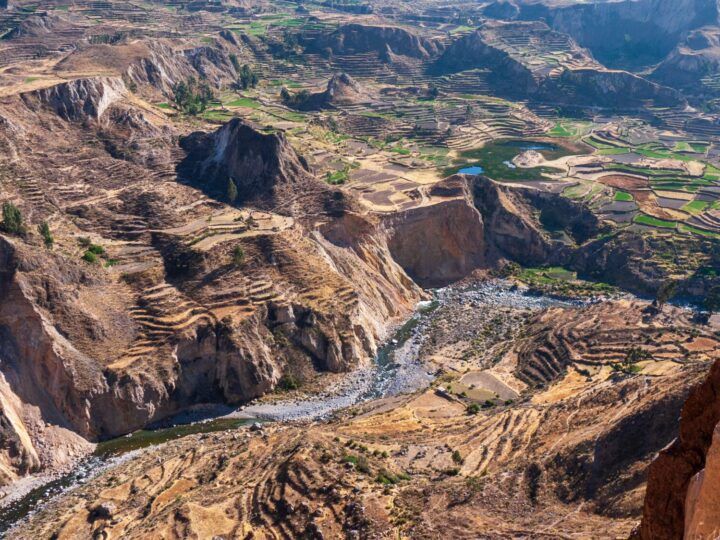
Here’s how to hike Peru’s spectacular Colca Canyon.
Click to navigate this article:
Preparing to hike the Colca Canyon
Before we begin, it’s worth understanding a little more about treks in the Colca Canyon. While the going here is tough, it’s very rewarding, although you’ll definitely want to be prepared before you leave.
1. How long does it take to visit the Colca Canyon?
It really depends on how much time you have and how you’d like to explore the canyon. Most travellers choose to do the two-day Colca Canyon hike – one night in the oasis – which involves an early morning bus from Arequipa on day one. Alternatively, the three-day/two-night trek gives you a chance to explore more of the canyon’s epic scenery.
With that said, you can also do the one-day hike without an overnight stay in the oasis. This option is, of course, one of the most challenging as you don’t have much time to rest and day tours start at 4am from Arequipa.
For inexperienced and beginner hikers, we recommend signing up with a Colca Canyon private tour if a one-day trip is what you prefer.
A private guide will arrange your transport and meals and ensure you don’t get behind schedule and drop you back at your accommodation in Arequipa at the end of a long but .
Planning Your Trip to Peru?
Save time, stress & money with a customized travel itinerary planned for you by a Peru expert
What previous clients have said:
Going to a new and exciting place is an adventure AND has its challenges. Being able to carve out an in-depth plan with someone that has been there and whom you can trust was extremely helpful. We felt comfortable embarking on a six-week backpacking trip with kids ages 8 and 11 with Steph on our team. Her expertise and ability to hear what we wanted gave us a great jumping point for planning. Her advice and wide array of options also allowed us to be flexible. It also gave us peace of mind knowing that we had someone we could call if our plans went awry. Every one of Steph’s recommendations panned out to be incredible pieces of our trips and we would highly recommend her!
2. Where does the trek into the Colca Canyon start?
The Colca Canyon trek does not have a specific starting point, as there are a variety of different routes and trailheads, depending on how far you wish to hike (see our Colca Canyon map above for more details).
However, the common starting points are located in Cabanaconde. The most popular one is located north of Plaza de Armas , which leads straight to Sangalle.
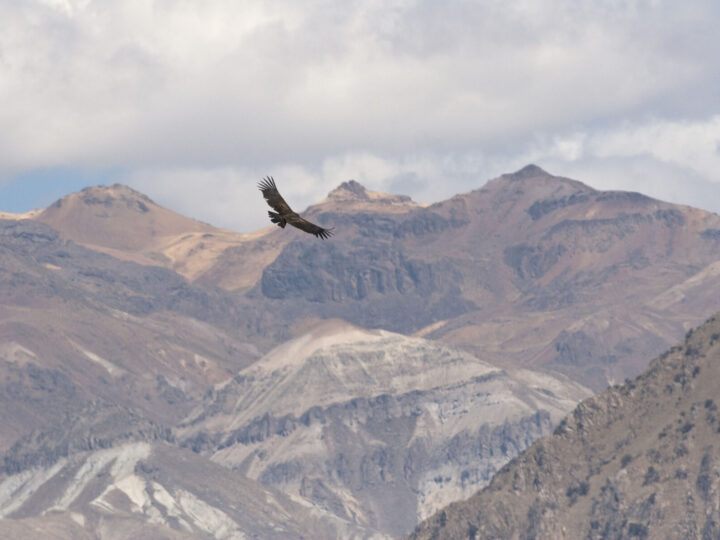
Another starting point in Cabanaconde is located west of the Plaza de Armas. This one leads to Llahuar, through the western loop of the oasis. The other starting point, Mirador de San Miguel, is located a 30-minute walk from the town.
3. When is the best time to do the Colca Canyon trek?
April and May are the best months to visit the Colca Canyon as the valley turns green following the seasonal rains but the mountains are still capped with snow.
That said, the Colca Canyon weather is generally warm and dry all year long – except for January through March when it rains almost every day. Because of the elevation, nights can be cold, especially if it’s been cloudy during the day.
Low pollution levels in the desert region mean a clear night sky. If you can time your trip, visit during the new moon in April or May. The views at night are majestic!
To know more about Peru and its weather conditions, read our guide on the best time to visit Peru next.
4. How fit do I need to be?
Overall, the Colca Canyon trek is challenging, whichever path you choose. Even though the hike down may be easy, you still need to hike your way out of the canyon, and, with Sangalle sitting at 2,100 metres of elevation and Cabanaconde at 3,300 metres, you’re facing the effects of altitude, too.
Another thing to consider is that it’s a high desert region where the sun is pretty intense, and there are not many trees to offer shade. Moreover, the paths are mostly dusty with small, loose rocks, which is physically demanding.
You don’t need to be super fit to do the Colca Canyon hike. But it’s definitely not for a first-timer or anyone with mobility issues. Since there’s no place to spend the nights other than in Cabanaconde or in the villages within the canyon, once you start your hike, there’s no stopping. So, good cardio, strong legs, and a sense of determination are a must.
5. How much does it cost to hike in the Colca Canyon?
If you travel on your own and without taking an organised Colca Canyon tour, the hike itself is free. All you need to budget for is transport, food, and accommodation.
On a non-guided three-day/two-night hike, you can exect to spend around $150 USD for two people in a double room. This cost includes a private room (one night each in Llahuar and Sangalle), colectivo fares from and to Arequipa, plus meals at the lodgings.
Signing up with tours may cost less as they put you up in dorm accommodation, while prices of Colca Canyon private tours vary – from $30 USD to $100 USD per person per day – depending on what the operator provides.
6. Do I need to take a tour or can I hike the Colca Canyon treks alone?
Not necessarily. With our Colca Canyon map, you can choose the route you like and hike without a tour or a guide. Besides, the locals are helpful when you ask them for directions. With that said, joining one helps avoid any unpleasant surprises such as missing the last bus!
Colca Canyon tour options
The most common options to trek the Colca Canyon are one-day, two-day, and three-day/two-nights trips. The Colca Canyon day trip will take you straight to Sangalle in the oasis, where you can have a short lunch break before going back up to Cabanaconde. If this is what you prefer, it’s best to have a guide with you.
With a guide, you’ll stay on track, which is important to make sure you get back safely and on time. Besides, you’ll have everything prearranged for you in the oasis.
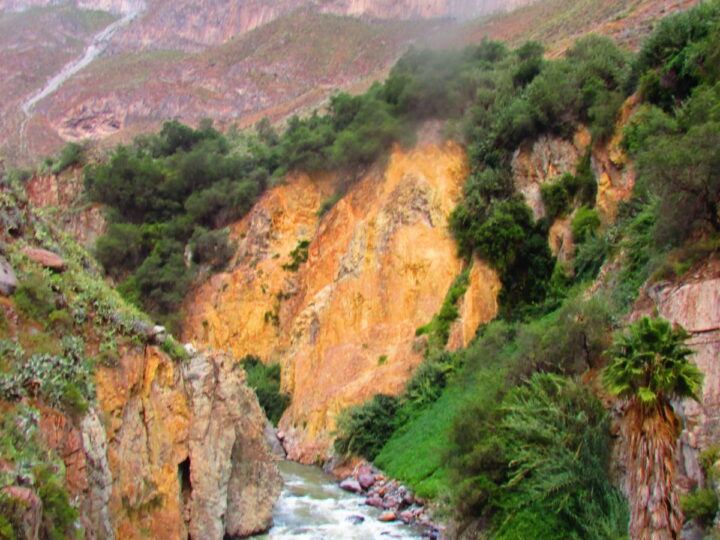
Remember that Sangalle is not really a town as such, more of a spot to rest in the oasis. Even though it’s often visited by tourists, there are no restaurants or shops with walk-in services. Instead, you tend to request and eat all of your meals at your accommodation, so if you’re hiking for just the day, you might struggle to find somewhere to eat.
Paying for a guided tour is a good choice if you’re on a day trip as your meal will be ready, made according to your preferences!
Colca Canyon packing list
The weather in the Colca Canyon makes it a little tricky when it comes to what to pack and what to wear.
Though the temperature in the oasis stays around 15 o C (59 o F) during the day, it’s pretty hot in Cabanaconde, especially when you hike under the sun. So, wear something you can sweat in, but bring a jacket or an extra layer in case the sun decides to hide behind the cloud.
- Sunblock and a hat. The sun can be pretty intense even at seven o’clock in the morning! Put on sunblock before your hike and keep your head protected under a wide-brimmed hat.
- Insect repellent. Especially in the oasis, there will be insects wherever you go. Protect yourself with insect repellent that lasts a long time, so you don’t have to constantly stop to re-apply. Something like Sawyer’s insect repellent is great; put it on right before your hike, and it will protect you for up to eight hours.
- A trekking pole. Hiking down thousands of metres of the Colca Canyon elevation towards the oasis can be challenging. A trekking pole (or even a pair of them) helps prevent you from losing your balance and slipping down.
- A raincoat. Even if it’s not the rainy season (December through March), there’s still a chance of drizzle. We recommend Patagonia’s Storm 10 (find it on Backcountry | Patagonia | Amazon ), a lightweight, highly waterproof, and durable raincoat, or the North Face Alta Vista Jacket ( Amazon | REI ), which is significantly cheaper but offers good weather protection.
- One litre of water for every three hours of your hike (and more for the climb!). Having a sip of water every now and then during your trek is vital. The intense sun combined with the dryness of the high desert region means more effort is required to stay hydrated. Note that you cannot drink the tap water in the Colca Canyon and the water in the river is likely contaminated by mining waste. The only chance you’ll have to restock is to buy bottled water at your lodging or small shops you’ll find in the villages.
- Snacks. Some parts of the trek, especially between Cabanaconde and Llahuar, have no shops in between. To stop you running on empty, pack protein bars, energy drinks, and other types of sustenance that help curb your hunger while providing you extra energy.
- Warm clothes. Even though it’s not winter, nights in the oasis can get below freezing. Pack a jacket and nice warm socks to help you sleep better. You’ll need your zs before a challenging hike the next day!
Colca Canyon hiking routes
Now you’re fully prepared for the trek, it’s time to plan your route. When it comes to choosing your Colca Canyon hiking route, you’ve got a wealth of options.
Typically, you can opt to hike one route into the canyon (to one of the three settlements in the oasis at the bottom) and return the same way, or hike a full loop into and then around around the canyon (taking a circuit that heads east or west).
To help you decide, we’ve focused on three routes which differ according to their difficulty, the majesty of their scenery and the terrain they cross. The durations given are how long we would recommend in order for you to hike comfortable and have time to enjoy some relaxation when you arrive at the oasis towns for the evening.
And if you’re feeling like you need an extra day of rest before embarking on the steep climb out, you can always extend any one of these routes by including an additional night staying at the oasis.
Please note, hiking times have been calculated based on being fit, healthy and having experience of hiking, and they don’t include rest or stop times, so be sure to build these into your hiking plans.
Colca Canyon route maps
To help you understand the different routes, each has been marked onto this map.
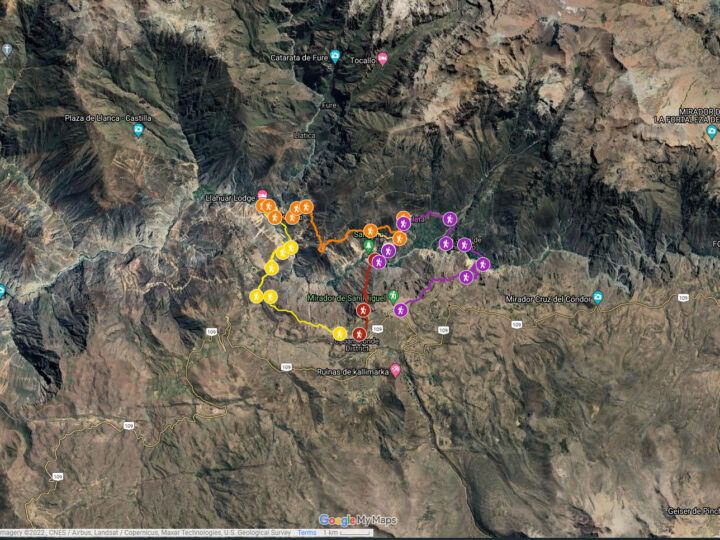
These include the following:
- Red: Cabanaconde – Sangalle – Cabanaconde (one day; 9.2 kilometres; challenging)
- Purple and red: Cabanaconde – San Juan de Chuccho – Sangalle – Cabanaconde (or viceversa) (two days; 17 kilometres; challenging)
- Yellow, orange and red: Cabanaconde – Llahuar – Sangalle – Cabanaconde (or viceversa) (three days; 29.6 kilometres; very challenging).
One-day hike: Cabanaconde – Sangalle – Cabanaconde (Red)
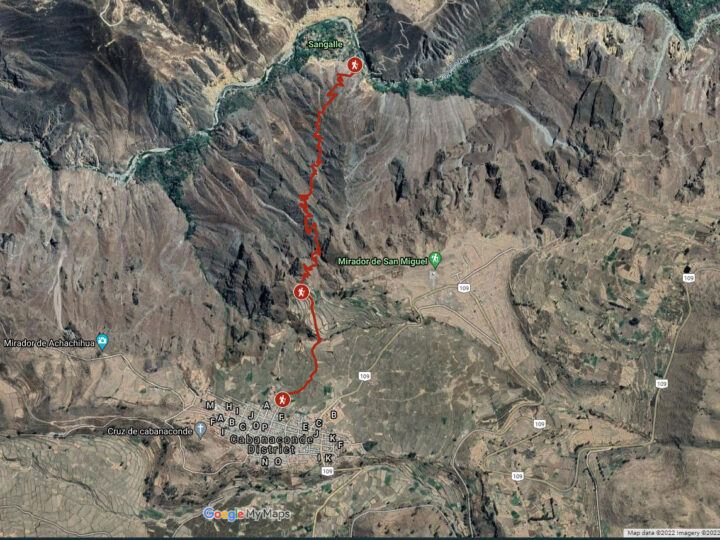
- Duration: 9.2 kilometres (5.7 miles); 7 hours
- Difficulty: Challenging
- Starting point: Cabanaconde (north of Plaza de Armas at the end of GrauStreet. From there, follow the arrows through the local farmland)
- Ending point: The same as the starting point
Only have one day to do the Colca Canyon trek? This is the route for you. The most popular path as it leads directly down into the oasis, it follows an extremely steep and rocky, 4.6-kilometre descent into the depths of the canyon. You’ll need three hours to go down and four hours to hike the same route back out.
To avoid the crowds – and give yourself plenty of time to complete the trek – take the earliest colectivo (at 4am) from Arequipa. You’ll arrive around 8am-9am in Cabanaconde. A better option is to spend the night before in Cabanaconde, which will allow you to start earlier and reach the cool waters of the oasis sooner – giving you more time to relax in Sangalle.
For that, La Casa de Santiago – located right at the trailhead – is an excellent choice of accommodation.
If you’re worried about fitness levels or time and can’t face the hike, there is another option: riding a mule to go back out to Cabanaconde! Rent one for around S/70 (around $17 USD), and, as it leaves Sangalle at five in the morning, you’ll need to arrange the ride with your lodging host the previous day.
Note that it’s still a challenging ride up and out of Colca Canyon, so we don’t recommend it if you’ve never tried non-guided horseback riding before.
Two days and one night: Cabanaconde – San Juan de Chuccho – Sangalle – Cabanaconde (or viceversa)
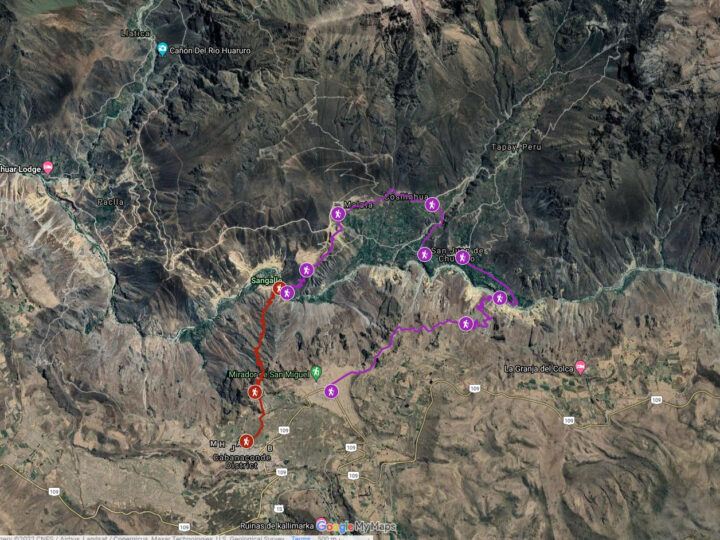
- Duration: 17 kilometres (10.5 miles); two days
- Starting point: Mirador de San Miguel or (30 minutes walking distance from Cabanaconde)
- Ending point: Cabanaconde (north of Plaza de Armas)
Day one: Cabanaconde – San Juan de Chuccho – Sangalle (Purple); 12.5 kilometres (7.8 miles); 7 hours
This loop takes you out east to explore the a more remote part of the canyon compared to the one-day hike itinerary above.
Though it takes more time and effort to get to the oasis, it’s more enjoyable as the views of the canyon are magnificent and you’ve got more time to appreciate them rather spending the entire time watching your footing as you descend.
Day one is the most demanding on this two-day Colca Canyon hike. Unlike the other two routes, the starting point is located around two kilometres outside of Cabanaconde. From there, it’s a winding, seven-kilometre, five-hour path down towards San Juan de Chuccho, a cluster of houses nestled into the canyon’s eastern flank.
Stop here for lunch at one of its small restaurants – although many remain closed due to the pandemic, so bringing a packed lunch is a sensible idea – before continuing your journey to Sangalle.
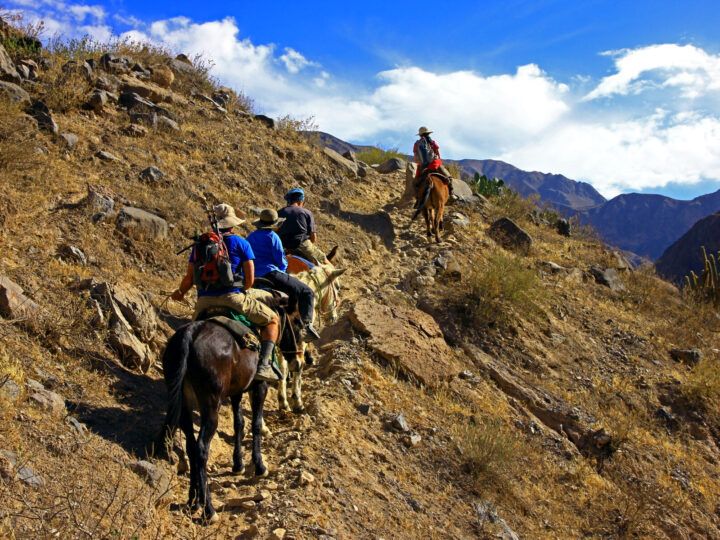
After lunch, it’s a two-hour, 5.5-kilometre trek to reach Sangalle. While Google Maps shows an alternative route across the floor of the canyon straight from San Juan de Chuccho to Sangalle, we didn’t see any visible, safe path.
Instead, it’s best to climb out of the canyon following the marked route through Cosñinhua and Malata, skirt the edge through the two towns, and finally down to Sangalle.
Where to stay: There are four lodging options in Sangalle. With lovely grounds and excellent service, Oasis Paraiso Ecolodge ($40 USD double with private bathroom) is the pick of the bunch.
Day two: Sangalle – Cabanaconde (Red); 4.6 kilometres (2.8 miles); 4 hours
Leave Sangalle early (5 a.m.) to avoid the heat from the sun – and to be back in time to take the bus to Arequipa – as you take on the steep and rocky path out of the canyon. If hiring a mule for the way out, you’ll be starting at this time, too.
Three days and two nights: Cabanaconde – Llahuar – Sangalle – Cabanaconde (or viceversa)
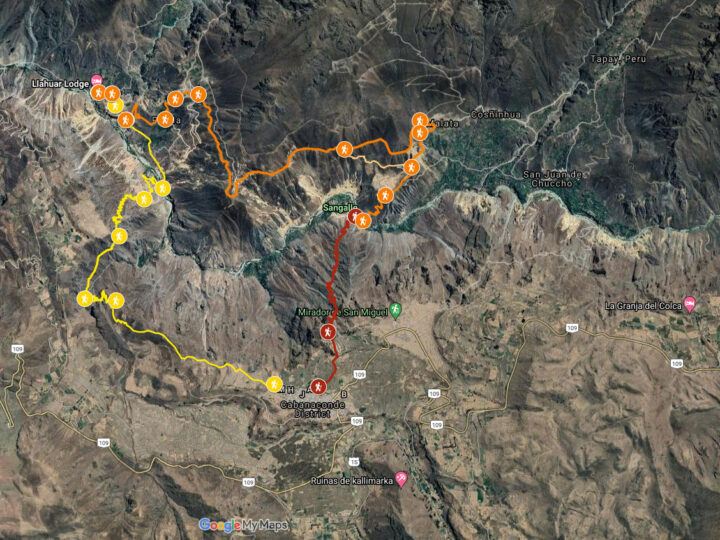
- Duration: 29.6 kilometres (18.4 miles); three days
- Difficulty: Very challenging
- Starting point: Cabanaconde (west of Plaza de Armas). Follow Calle Bolivar west away from the Plaza de Armas in Cabanaconde to its conclusion; you’ll see a bull arena (marked as Plaza de Toros) at the beginning of the path.
This route is our favourite for exploring the Colca Canyon as it takes you around both sides of the gorge, down into one oasis village – Llahuar – and into another – Sangalle – therefore allowing you to see this dramatic canyon from all angles.
Day one: Cabanaconde – Llahuar (Yellow); 12 kilometres (7.5 miles); 5 hours
Start your hike at first light from Cabanaconde. The path will take you through local farmlands towards the edge of the southern side of the canyon. This hike starts gently, giving you the option to admire and take photos of the northern side of the canyon from afar.
After about 30 minutes on this path, you’ll reach your first descent into the canyon. A rocky path descends to a small wooden bridge that connects the southern and the western sides of the canyon. On the other side of the bridge is a flatter, easier route skirting the edge of the trek’s westernmost part. The views during this part of the hike are fantastic!
After skirting the edge of the canyon, you’ll reach the most challenging part of day one: another descent to the oasis on a steep, rocky trail. When on this path, please pay attention to each step on the loose rocks, especially on the steepest parts.
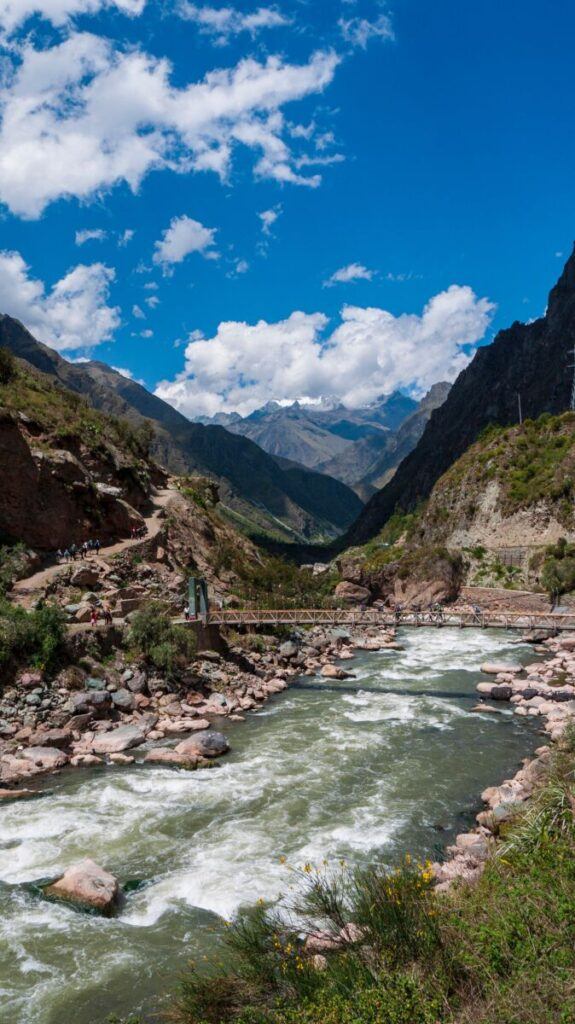
This one-hour-long zig-zag path meets a big road in the end. Follow the road down towards a big bridge that crosses Rio Colca. From there, it’s a bit of a walk uphill until you find an intersection that splits the road into two options: one to Tapay and another to Llahuar. Take the latter to get to a path down – another zig-zaggy one – towards the last bridge you need to cross to get to the hamlet of Llahuar.
Where to stay: There are a couple of lodging options in Llahuar. We stayed in a private room with a shared bathroom at Casa de Virginia ($20 USD double). Breakfast by the river is included. Deliciously hot thermal pools are available for guests to soak their tired legs under the stars.
Day two: Llahuar – Sangalle (Orange); 13 kilometres (8 miles); 5 hours
If you’re a beginner trekker, or a slow walker, leave Llahuar as early as possible on day two, as you’ll be hiking a long distance as you move from one part of the canyon to another. First, return to the intersection you descended to reach Llahuar yesterday, but instead take the lefthand road towards Tapay.
This road skirts the hillside until you arrive in a village called Paclla, where you’ll find a small pathway up the hill heading north out of the village.
If you’re not sure which pathway to take, you can ask for directions to Belen. Note that the locals may direct you to the main road, but we don’t recommend this as the road is too long and not meant for pedestrians. The pathway is more steep and challenging, but it’s significantly shorter than the road.
It’s a steep climb for about an hour until you reach Belen. From here, follow the main road heading southwest out of the village, which follows the edges of the canyon for a number of miles until you see a descending path towards Sangalle.
There are two ways to descend to Sangalle: the first point you’ll encounter – marked with a road sign – is shorter but can be dangerous, especially for tired legs; locals actually stopped us from going down this path. Instead, continue along the road and descend into the village of Malata.
From there, just follow the trail down past a reservoir, across farmland, and finally down a steep, winding path to Sangalle; you’ll find a road sign marking the start of this final descent.
Day three: Sangalle – Cabanaconde (Red)
Leave Sangalle early (5 a.m.) to avoid the heat from the sun – and to be back in time to take the bus to Arequipa – as you take on the steep and rocky path out of the canyon, which should take around four hours. If hiring a mule for the way out, you’ll be starting at this time, too.
Transportation and logistics
Located 220 kilometres away from Arequipa, the Colca Canyon is served by a decent array of public transport. That said, regardless of the route you take, you need to begin your hike early in the day, planning your route to the trailhead (and back to Arequipa) is essential.
Transportation to Cabanaconde from Arequipa
To get to any starting point for hiking into the Colca Canyon from Arequipa, you have three options: on a bus straight to Cabanaconde, on a colectivo (a van) to Chivay (a town 1.5 hours away from Cabanaconde), or signing up with a Colca Canyon tour.
The latter is the most expensive, but they will arrange everything for you, including transport from and to Arequipa. Some even provide a private guide to accompany you on the trek as well – although we don’t believe this to be a necessary expense, as the trail is easy to follow (download Maps.Me and the map for the region before you leave, however, so you have a map and GPS for the duration of your hike).
The bus (S/25 or $6.13 USD) takes six to seven hours from Arequipa’s bus terminal (Terminal Terrestre de Arequipa) to Cabanaconde and can take longer as it stops at every town in between.
Since the pandemic, there’s currently only one company operating the Arequipa-Cabanaconde route: Andalucia. They leave 3 times a day. 1am, 3:30am and 1pm and charge S/25 or $6/50.
An alternative is to take a colectivo (S/20 or $5 USD), which is faster and have a greater frequency, with one leaving every one to 1.5 hours.
Since Covid, there’s only one operator for colectivo : Caminos del Inca . The earliest van leaves at 4 a.m. and the latest at 1 p.m., with one leaving every one to 1.5 hours in between. Though when there’s high demand, they may add more schedules up to 3 p.m. Keep in mind that the colectivo only reaches Chivay. From here, you need to take another colectivo (S/10 or $2.45 USD) to Cabanaconde. The van leaves Chivay at 9am. If you miss it or prefer a more convenient way, taxis are available from Chivay that will take you to Cabanaconde for S/80-100 (around $19-25 USD).
Note that at the time of update, Oct 2023, there has been a fatal accident involving this colectivo operator. We recommend that when you arrive in Arequipa you do some reasearch before booking with a colectivo operator.
If you’re planning to start your hike from the Mirador de San Miguel, ask the colectivo or bus to let you off at the stop, which is located on the road before Cabanaconde. This will save you an hour of walking time.
The transport timetables are below:
Transportation from Cabanaconde to Arequipa
Unless you sign up with Colca Canyon tours, getting back can involve more effort than getting to the Colca Canyon from Arequipa. Basically, you need to take the same transportation to get to the Colca Canyon: on a colectivo from Cabanaconde to Chivay and another colectivo from Chivay to Arequipa, or a bus straight from Cabanaconde to Arequipa (which also stops in Chivay).
Read our Transportation from Arequipa to Cabanaconde section above for more details.
This trip is more challenging because due to the limited number of vehicles operating, you may have to wait up to several hours to get a seat.
And you can’t book the colectivo in advance. If you’d like everything set before your trip, book your seat with the Andalucia bus operator that leaves at 1 p.m. from Cabanaconde. Whichever means of transport you choose, you can access it from the Plaza de Armas.
Looking to do some other hiking while you’re in South America? Don’t miss our guide to hiking the Inca Trail , our article on the 21 best hikes in Peru , or this round-up of the 11 best South America hikes .
Monday 10th of July 2023
Great read. Do you recommend booking a 3D/2N tour online or would it be cheaper/ possible to book the day before in person in Arequipa? Thanks!
Steph Dyson
Wednesday 20th of September 2023
Hi Alana, booking online isn't necessarily more expensive - and it guarantees that the tour is running when you want to do it! Steph

Kate Abroad
Colca Canyon 2 Day Trek: Know Before You Go
Wondering whether to add the Colca Canyon 2 day trek to your Peru itinerary? This article has everything you need to know about the overnight Colca Canyon trek.
We completed the 2 day trek in Colca Canyon in June 2023 and had an amazing time. In fact, it was a highlight of our 3 week Peru itinerary.
However, not everything on our Colca Canyon trip was quite as expected, this Colca Canyon trekking review will explain the differences to help you prepare.
And if you’re not sure whether the trek or tour option is for you, or maybe even the 3 day Colca Canyon trek, then there’s a comparison section at the bottom to help you decide.
Getting to Colca Canyon from Arequipa
Colca Canyon is about a three hour drive (roughly 170km) from Arequipa.
All 2 day Colca Canyon trek companies include transport to and from the canyon, either with pickup at your accommodation in Arequipa or with a central Arequipa meeting point.
If you aren’t staying in central Arequipa, you may need to get yourself into the city to join your trekking group. It’s best to arrange this ahead of time through your accommodation as taxis are hard to find early in the morning.

Colca Canyon condor sighting
One highlight of doing a Colca Canyon trek is the opportunity to see condors, the second largest bird in the world.
These look roughly similar to eagles with a massive wingspan and black and white colouring.
Colca Canyon treks all include a stop at a spot called ‘Condor’s Crossing’ typically on the first day before the hike starts, where you have a high chance of seeing condors in flight.
Your guides can help with pointing out condors in the distance as you typically won’t get up close unless one flies directly overhead.
There are also some guys in condor costumes and a large statue if the real birds aren’t visible.

2 day trek Colca Canyon overview
Here’s what to expect on a 2 day trek in the Colca Canyon. It’s based on our experience of the hike but most companies offer practically identical itineraries.
There isn’t a lot of infrastructure around so everyone visits the same attractions/lookout points and uses the same few cafes and lodges.
Colca Canyon hike day 1
Day 1 of the Colca Canyon hike starts early, like really really early, at around 3:30 am, normally with pickup from your hotel in Arequipa.
You’ll then drive for about 3 hours to have breakfast (one scrambled egg and some dry bread) in Chivay at a very touristy restaurant, before pushing on to Condor’s Crossing at the top of the canyon.
Here you can, most of the time, watch condors soaring over the canyon or perched on rocks on the side of the cliffs. There are also some small stalls for buying souvenirs and snacks.
After that, you’ll head to the starting point of the hike, where you can use bathrooms, store big bags and hire walking poles.
The first section of the hike (around 3 hours) is all downhill, with lots of switchbacks as you drop around 1000m in altitude.
This section can be really hot, even in winter, as it’s in the full sun, but it isn;t particularly difficult.
Once you reach the river at the bottom of the canyon you’ll cross a small bridge and head along flat/undulating terrain for around an hour until you reach the lunch spot.
Lunch is a typical Peruvian meal, usually starting with a soup and then some kind of meat dish. Drinks can be bought but only at exorbitant prices, so its better to buy them at the stalls between the bridge and the cafe.
After lunch it’s another 2-3 hours of undulating walking along the canyon floor util you get to Sangalle where you’ll stay the night. You can then chill out by the pool and rest up for tomorrow.
Dinner is at the lodge and they have a bar onsite too. There are hot showers and wifi at some lodges but you’ll have to pay for the towel and password.

Colca Canyon hike day 2
Day 2 is another super early start, you’ll be walking from around 5-5:30am, before the sun comes up.
For the first hour you’re walking in the dark using torches or phone flashlights until the sun comes up around 6 or 6:30. It’s absolutely freezing at the start but you’ll warm up quick as the walk is straight uphill with endless switchbacks.
The path is steep and rocky which is killer on the legs, especially after a full day walking yesterday, but it helps to have snacks to keep the energy levels up.
Once you reach the top there is a lady selling hot tea, coffee and snacks which are much needed and help you stay warm as the front pack will need to wait for the last of the group to arrive before doing the final 30 minute push to the breakfast stop.
Breakfast is basic again, and in what seems to be a private home, but it’s a good place to rest and regroup after a hard two days.
After that it’s off to the hot springs, one of the highlights of the trip, where you can soak and recuperate in the geothermally heated waters. This is super relaxing and suprisingly doesn’t feel like a tourist trap.
The rest of the trip is mostly driving time as you stop at a few lookouts to see the highest point of the canyon and spot some llamas from afar, before finishing up back in Arequipa.
Lucnh on day 2 is at the same restaurant as breakfast on day 1 and consist of a very overpriced and mediocre buffet.

Colca Canyon mule rides
If you’re not sure whether you’re up to the uphill section of the 2 day Colca Canyon hike then there is another option, you can take a mule (or two)!
Mules can be arranged through your tour company either ahead of time or at the end of day 1 and, when we visited in mid-2023, cost 80 soles per mule.
I say per mule rather than per person because if you weigh over 80kg you’ll need to pay for 2 mules and swap at halfway, it’s not good for the mule to carry a larger weight the whole way up.
Mules are only available on day 2 so you’ll still need to be capable of completing the day 1 hike yourself and also the final 30 minute stretch on day 2 from the top of the canyon to the breakfast spot.
You get an extra hour of sleep if you take the mules as they’re faster climbers than human legs, even then you’ll still catch the rest of your group up before the top.
Mules can be a little scary as they cover narrow tracks and rocky surfaces at speed but they’re safe – or at least that’s what our guide promised!

Colca Canyon accommodation
So, the accommodation in Colca Canyon is…limited. As you’d expect from a remote location at the bottom of a massive canyon.
There are 2-3 ‘resorts’ at Sangalle Oasis which are varying levels of basic.
Ours, the Oasis Ecolodge sucked, to be honest with you. There was no light in the showers, the doors didn’t lock, tons of bugs came in the roof and a stray dog barged into our room at 2 am.
Unfortunately, you don’t get a choice in the matter, the accommodation and the pricier tour gets a slightly better offering but even still it’s not great.

Meals and food in Colca Canyon
Almost all overnight treks in Colca Canyon include some food but the quantity and quality vary.
Our tour, and most options advertised around Arequipa, include breakfast, lunch and dinner on day 1 and breakfast and lunch on day 2. It did not include water and the food was very basic.
Water can be bought from each café and hotel as well as a few random trail-side stalls on day 1.
Other tour groups we met in the canyon did have some water included and nicer quality meals so you can pay for improved service.
One thing to know is that breakfast on day 2 is after you’ve hiked to the top of the canyon, so you’ll probably want to bring your own snacks to eat before the hike.
You can buy food from the supermarkets in Arequipa (there’s one on the main square) and carry it with you.
My Overnight Colca Canyon Trek review
The 2 days we spent in Colca Canyon were a highlight of the Peru trip for me but they were also super challenging and exhausting.
The Colca Canyon 2 day hike is 100% worth doing, the landscape is incredible and the feeling of achievement reaching the top on Day 2 justifies the early start and hard effort.
It’s a part of Peru that not everyone gets to or bothers going to which makes it extra special.
That said, it was not a comfortable experience, the accommodation was pretty terrible and the food was mediocre at best. Plus the altitude makes everything just that bit harder.
If you go in expecting this then it’ll be a lot easier, and bring lots of snacks, water and bug spray to help.

2 day Colca Canyon trek vs Colca Canyon 2 day tour
If you want to do an overnight trip to the Colca Canyon you actually have two choices, a trek or tour.
The 2 day tour is slightly shorter, it starts at 7:30 am, not 3:30 am, and you stay overnight in Chivay rather than the bottom of the canyon but otherwise, the itineraries are very similar.
You can expect a lot of driving on the tour in order to get to all the viewpoints and lookouts so it can still end up pretty exhausting despite the lack of hiking.
If you don’t want to hike, I would actually recommend the 1 day tour rather than the 2 day, as you don’t actually see that much more that’s different/unique for the amount of extra bus time.
Colca Canyon 2 day trek vs Colca Canyon 3 day trek
Alternatively, if you have some extra time you might want to consider the three day Colca Canyon trek.
It’s the same as the two day trek in terms of path and distance but you go slower, staying overnight at the day 1 lunch stop.
This might sound a lot easier but it isn’t really because you still have to do the uphill (day 2) climb in one go which is the hard part, not day 1.
FAQ about trekking Colca Canyon
The best time to do the Colca Canyon trek or tour is in Peru’s dry season from May to August. This is also Southern Hemisphere winter, so you’ll beat the heat but need to pack lots of layers.
The base of the Colca canyon at Sangalle Oasis is 2610m above sea level while the highest point is early 500m. Treks typically start at 3300m, go down to 2610 and back up again.

More Peru Guides
If you’re planning a trip to Peru , then these other articles might help with travel inspiration:
- 3 week Peru itinerary
- Honest Peru Hop review
- How many days to spend in Arequipa
Happy travelling!
South America Travel Resources
- Find the best prices on hotels with flexible cancellation at Booking.com
- Find awesome day tours on Get Your Guide
- Compare prices for bus tickets and book with Bus Bud
- Sort your pesos, soles, reals and other currencies with a Wise multi-currency card
Kate is the founder of Kate Abroad. She has travelled to nearly 40 countries from Austria to Vanuatu, and lived in 3. She's on a mission to empower other Gen Zs and Millenials travel affordably by sharing helpful travel guides, stories and tips to over 200,000 readers.
Similar Posts

Do You Need Hiking Poles for the Inca Trail?
If you’re planning to tackle the Inca Trail then you might be wondering, do you need hiking poles for the Inca Trail? The answer of course is it depends, but…

15 Best Things to Do in Sucre Bolivia in 2024
Wondering about the best things to do in Sucre, Bolivia to fill your time in the White City? This article has you covered with the top Sucre attractions and must-do…

10 Affordable Travel Destinations For Millennials In 2024
If you’re a 20/30 something traveller trying to decide where to book your next holiday without blowing your budget this article has you covered. As a late 20s traveller myself,…

Brutally Honest 2024 Peru Hop Review (+ Bolivia Hop)
Despite the title, this Peru Hop review isn’t intended to trash the company. We travelled with them for nearly a month and had a fantastic trip, sometimes in spite of…

10 Budget-Friendly Holiday Destinations for Gen Z in 2024
Hey, Gen Z adventurers! Looking for your next vacation spot? We’ve got you covered with 10 affordable holiday destinations perfect for Gen Zers. Forget the clichés; travel is about diving…
![colca canyon trek review 3 Week Peru and Bolivia Itinerary [2024 Guide]](https://kateabroad.com/wp-content/uploads/2023/08/IMG_7133-300x225.jpg)
3 Week Peru and Bolivia Itinerary [2024 Guide]
Wondering how to spend 3 weeks in Peru and Bolivia? No worries, this Peru and Bolivia 3 week itinerary has you covered. If you’re looking to get a first taste…

Trekking the Colca Canyon: a Travel Guide
With a depth of about 3300 meters, the Colca Canyon is one of the deepest canyons in the world – twice as deep as the Grand Canyon. Inhabited since pre-Inca times by people of the Collagua and Cabana cultures, the canyon remains vibrant with the indigenous people who still call the Canyon home, and maintain their cultural traditional practices as evidenced by the beautiful stepped terraces called andenes prevalent around the valley. This travel guide will highlight my experience trekking the Colca Canyon on a 2 day guided tour ; but I will also will highlight alternative ways one can visit the canyon from alternate trekking options to easy day tours from Arequipa.

This post includes affiliate links. If you make a purchase via one of these links, I may receive a small percentage at no extra cost to you.
- Review of the 2 day 1 night guided trek of the Colca Canyon
- Is it worth it to do a guided trek?
- Packing list for trekking the Colca Canyon
- Visit the Colca Canyon without any hiking
- Final thoughts on Visiting the Colca Canyon

Review of the 2 day 1 night guided trek of the Colca Canyon:
Day 1: Distance hiked: 15KM. Elevation loss: approximately -1000m
Degree of Difficulty: 8 out of 10
After visiting the beautiful city of Arequipa , I set off on a 2 day 1 night trek of the Colca Canyon . Overall, this is one of the most challenging trekking options you can choose for the Colca Canyon. On day 1 you’ll be picked up between 3am – 3:30am at your hotel in Arequipa, and be taken to the town of Chivay to have breakfast. At 3000m above sea-level you may be already feeling the effects of altitude at this point. You’ll likely have baskets of Coca leaves offered to you at breakfast. The traditional way to take Coca leaves is take 2-3 leaves, roll them up and stick the small roll in your mouth between your cheek and gums – and let the Coca leaves slowly do their work. After breakfast you’ll be taken to the Cruz del Condor viewpoint to watch the condors soar around the canyon on thermal waves. You’ll start the trek around 9am, and descend into the canyon for around 3-4 hours (average hiking time) to the town of San Juan where lunch will be served.

After lunch, you’ll continue descending down into the canyon to the town of Sangalle – where you’ll stay overnight at a beautiful resort at the bottom of the canyon complete with a pool and artificial waterfall that looks like a surreal piece of heaven after a hot day of hiking 15KM in the blazing sun. Dinner is included and accommodations include washrooms and showers.
While the hike on day 1 is net downhill, this can actually be quite challenging for those with knee or joint issues. The trail also has many sections of loose rock or gravel – which combined with the downhill element of the day can also create greater risk of falling.

One of the most challenging elements of day 1 is that most of the hike takes place on a trail with little cover from the blazing hot sun. It’s important to bring at least 2 litres of water. I would strongly recommend bringing a water bladder so you can drink frequently without having to take your pack on and off to do so. Hiking poles will also be very helpful.

Day 2: Distance hiked 8KM. Elevation gain approximately 1000m.
Degree of Difficulty: 9 out of 10.
Day two begins before the sun rises at 5am in the morning. The big feature of day 2 is the roughly 1000 meters of elevation gain that you’ll cover in the morning to the town of Cabanaconde. It will take most hikers roughly 3-4 hours to cover this challenging climb.

One of the beautiful things about day 2 is watching the sun rise over the canyon. The hike starts incredibly early so you can avoid most of the day’s heat before the sun rises. Headlamps would be helpful in the pre-dawn hours. After the hike is complete, your hiking group will be taken to have breakfast in town. The bus will then start driving back to Arequipa. Along the way, the group will stop for a buffet lunch (optional, extra charge – recommended) as well as an optional stop at some hot springs. Entry is 15 sols, highly recommended and well-worth it after such an intense hike.
The bus will also stop at various view points along the way back to Arequipa. Watch out for herds of Vicuna and other wildlife native to the Canyon on the drive back.

Overall, I would recommend the 2 day 1 night Colca Canyon trek for experienced hikers who have had some experience hiking mountainous terrain and can handle hiking at altitudes of 1000 – 2000 meters. If you’re not an experienced hiker but would still like to trek the Colca Canyon – consider doing the 3 day 2 night Colca Canyon Trek – which follows the same route as the 2 day trek, but stops for an additional night in San Juan (the lunch stop for the 2 day trek). The extra day helps to break up the 15KM that is usually covered in just 1 day on the 2 day trek. Day 3 of the 3 day trek is still the same as the last day of the 2 day trek – which involves the 1000m climb from Oasis de Sangalle up to Cabanaconde.

Is it worth it to do a guided trek of the Colca Canyon?
In my opinion, hiking the Colca Canyon on a guided trek is the best way to go. Some people opt to hike in the Colca Canyon on their own – however, their savings is minimal. The two day guided Colca Canyon trek costs approximately $67USD (Spring 2023 prices) and includes 2 breakfasts, 1 lunch and 1 dinner as well as accommodations in the Oasis de Sangalle. You would be hard-pressed to do the trek on your own for less than the cost of a guided tour.
A guided tour also includes a tour guide who knows the route, can point out interesting things to see along the way; and also can get help in case you are unable to hike or get injured. A lot of people underestimate how challenging the trek will be. I would say for every 10 people I talked to about their experience trekking the Colca Canyon, 2-3 people needed additional help – such as hiring a mule to get them out of the canyon, or first aid for injuries. A guide would know how to get you this kind of help quickly. If you were by yourself, this could be a lot more challenging.

Another reason to go with a guided trek, is for way-finding and safety. While the Colca Canyon trek is fairly straightforward, there is not a lot of signage, and it can be quite easy to get lost. Unfortunately, there have been hikers who have disappeared trekking the Colca Canyon on their own.
If you’re considering trekking the Colca Canyon trek, I would strongly recommend going with a guided trek. Not only are there a lot of extras taken care of – such transportation to and from the trail, and getting you to attractions along the way such as the Cruz de Condor, and hot springs after the hike; the guided tour also is a much safer option for roughly the same price as what it would likely cost you to trek on your own.

Packing list for trekking the Colca Canyon:
- Sturdy hiking boots ideally with ankle support. I use and love Saloman’s Quest 4D hiking boots ( women / men ) – they are considered some of the best in the market.
- 20 – 30L hiking backpack. The Osprey Talon is one of the best hiking backpacks on the market. If you’re traveling light, consider this ultralight expandable 20L-30L backpack with lightweight back support and hip and chest straps – it also comes with a rain cover, is waterbladder compatible, and only weighs 1lbs.
- Hiking poles I use these tri-fold hiking poles that can fit into my daypack when not in use.
- 2L water bladder (highly recommended so you don’t have to reach back or take off your backpack to get a drink of water. You’ll want to hydrate often given the conditions.
- Headlamp – for the evenings and for trekking in the pre-dawn hours. I prefer using a rechargeable headlamp to avoid disposable batteries.
- Power bank. I used this one on various multiday hikes including 6 days on Kilimanjaro. Avoid powerbanks over 20000mAh for trips involving air-travel.
- Sunscreen. I love using La Roche Posay SPF 50 for Kids a super-powerful sunscreen that’s also gentler on my sensitive skin.
- Insect repellent – for the evenings. I prefer Icardin-based repellents – just as effective as Deet, but much safer.
- Brimmed hat or ballcap – very important to keep the blazing sun off your face
- Flip-flops or hiking sandals for showering and post-hike
- 2-3 T-shirts (depending on whether you do the 2 day trek or 3 day trek). I love Icebreaker Merino t-shirts ( women / men )– as they dry quickly and resist odors even after multiple wears.
- 1 pair shorts (for hiking in the sun on day 1 – it will be super-hot)
- Lightweight towel
- Bar shampoo – I use this as my everything soap.
- 1-2 pairs of hiking socks. I use Icebreaker Merino socks ( women / men ), as they have a lifetime guarantee . If your socks ever develop holes, just send open a claim online with some photos, and Icebreaker will send you a giftcard for the value of the socks!
- 1 pair of convertible hiking pants ( men / women ) – useful for the climb back to Cabanaconde on the last day when it will likely be quite cool before the sun rises, but it will get quite warm once your body warms up from the climb and the sun starts to come out.
- 1 long sleeve shirt (for the evening)
- 1 hoody or mid-layer – if you’re hiking in the cooler months, you might need an extra layer to keep the chill off I the evenings
- 1 rainshell (just in case it rains, but it is also helpful for keeping the wind off in the evening, and also in the pre-dawn hiking hours. Consider these ultralight packable jackets ( women / men )
- Toque/beenie – in the predawn hours it will be chilly – it is useful to have a warm hat
- Silk sleep sack – the accommodations on the hike are lovely but they are rustic – I greatly appreciated having my silk sleep sack.
- $100 – $200USD in cash. You’ll likely not need this much cash, but it’s good to have this amount handy in case you need to hire a mule. You’ll also need some cash buy snacks and water along the way.

Visit the Colca Canyon without any Hiking:
If you’re not a hiker, there are many options for visiting the Colca Canyon without any hiking. There are both day trips and even multi-day tours of the Colca Canyon available that will not require any hiking. This well-reviewed day trip from Arequipa takes you to many points of interest in and around the Colca Canyon, including many of the stops visited on the Colca Canyon trek such as the Cruz del Condor, Abra Patapampa, the Salinas y Aguada Blanca National Reserve and the hot springs. There are even multi-day non-hiking sight-seeing tours that can be done from Arequipa. Such as this well-reviewed 2 day 1 night sightseeing tour – which again, visits many of the points of interest and attractions that you would see on the 2 day Colca Canyon trek.

Final thoughts on trekking the Colca Canyon:
Trekking the Colca Canyon is a beautiful and challenging experience. Along the way you’ll see immense natural beauty along with settlements of indigenous peoples who have lived in harmony with nature in the Canyon since time immemorial. Whether you’re up for a challenging 2 or 3 day trek down and back up this deep canyon; or you prefer to just do a day trip by bus with very little hiking – the Colca Canyon is an incredible destination that will leave a deep impression on your memories of Peru.
Share this:
Leave a comment cancel reply.
Your email address will not be published. Required fields are marked *
Save my name, email, and website in this browser for the next time I comment.
Notify me of follow-up comments by email.
Notify me of new posts by email.
Discover more from Live, Wander, Play
Subscribe now to keep reading and get access to the full archive.
Type your email…
Continue reading
Colca Canyon Trek: Routes, Trail Info, and Tips

Colca Canyon ( Cañon del Colca in Spanish) is the world’s second deepest canyon, famous for its beautiful terraced hillsides and flying condors . But you have only half-experienced the highlights of this region in Peru if you don’t plan a Colca Canyon trek.
The trails in Colca may not pass as many stone ruins as the Inca Trail to Machu Picchu, but the region makes up for it with stunning scenery and natural hot springs. In general, the further you walk, the fewer people you’ll share the trails within and around Colca Canyon.
Choose your base in Cabanaconde, a town on the canyon rim, and depart on one of the trails leading down into Colca Canyon. Alternatively, the town of Chivay in the upper Colca Valley is a convenient spot to plan day hikes to Andean villages surrounded by terraced hillsides.
Treks in Colca Canyon Day Hikes (in Colca Valley) Trail Information Colca Canyon Tour Vs Colca Canyon Trek Tips for Trekking Without a Guide Packing Essentials Start Planning
Treks in Colca Canyon
The town of Cabanaconde is only 8 mi (13 km) past the iconic Colca Canyon condor viewing platform, or Mirador Cruz del Condor , and a must-visit spot for trekkers. In Cabanaconde, you can take walking trails that connect villages and natural attractions in Colca Canyon.
Colca Canyon is not just one defined trekking loop or path , unlike other treks in Peru . The map below indicates popular trail routes (in black) connecting villages within the canyon. There are several treks to choose from, and below are a few two and three-day options. Longer routes take you to further spots such as Huaruro waterfall and Tapay village.

Colca Canyon Trek Map by Peru For Less

Colca Canyon Trek 2 Days: Short and Sweet
Recommended if you are short on time but would still like to trek into the canyon
Route: Cabanaconde > Sangalle Oasis > Cabanaconde Overnight: Sangalle Distance: about 5 mi (8 km) roundtrip
The well-trodden trail to the oasis known as Sangalle is a very popular Colca Canyon 2 day trek. Basic bungalows, campgrounds, and even pools for swimming make Sangalle a comfortable and popular village to spend the night. Plus, if you are trekking without a guide, there are places to buy cooked meals and extra water.

Escape to the canyon oasis of Sangalle. Photo by Sander Lenaerts on Unsplash .
Reaching the oasis takes about two hours descending on foot while ascending the steep trail back to the canyon rim can take anywhere from two to three hours (or more depending on your level of fitness and acclimation).
Arequipa Tours:
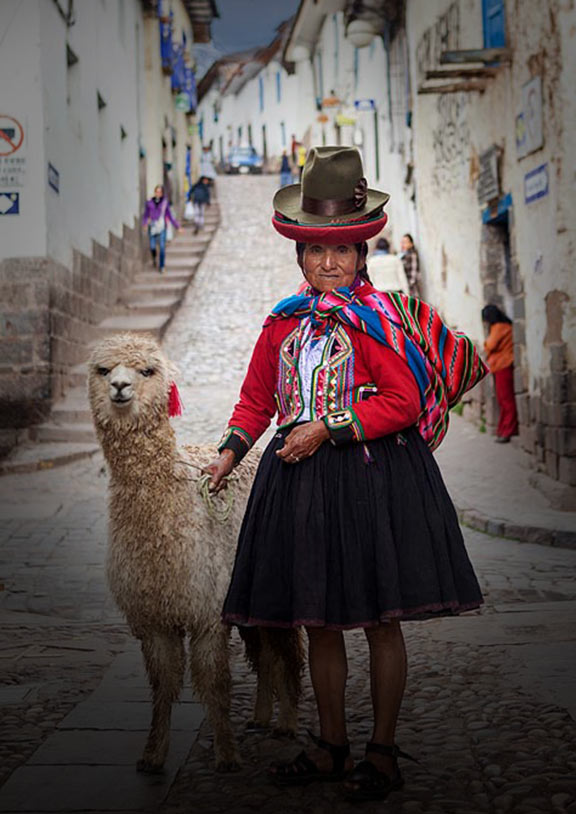
Colca Canyon Trek 3 Days: Popular Route
Recommended for an extended stay in Colca Canyon
Route: Cabanaconde > San Juan de Chuccho > Sangalle Oasis > Cabanaconde Overnight: San Juan de Chuccho (night 1), Sangalle (night 2) Distance: about 12 mi (20 km) total
Set out on a trekking loop into the eastern part of Colca Canyon and spend the night in the villages of San Juan de Chuccho and Sangalle. Averaging between four to five hours of walking each day, this three-day trip isn’t too strenuous if you walk at a steady pace.

The village San Juan de Chuccho from high across the river. Photo (modified for size) by Monty VanderBilt/Flickr .
From the trailhead, not far outside Cabanaconde, the trail begins fairly even and transitions to switchbacks along the steeper descent to the canyon floor. The small village of San Juan de Chuccho sits along the Colca River and is not accessible by car. Guesthouse accommodations are limited and minimalist, but usually include a bed (dorm or private) and meals.
The next day, continue onwards to Sangalle. Pass through the village of Cosñirhua along the way and buy extra water and snack foods (fruit, chips, etc). The sparse vegetation on the trail transitions to greener vegetation and palm trees the closer you get to the Sangalle oasis for the second night.

Save your energy for the steep climb out of the canyon on the third and final day of the trek. Mules are available to hire if you need help and are included with some guided tours.
Colca Canyon Trek 3 Days: A Challenge
Recommended if you are in good shape
Route: Cabanaconde > Llahuar > San Juan de Chuccho > Cabanaconde Overnight: Llahuar (night 1), San Juan de Chuccho (night 2) Distance: about 19 mi (30 km)
This trekking loop takes you into the canyon to the village of Llahuar in the west to San Juan de Chuccho in the east. Sangalle is not part of this itinerary, allowing you to bypass the crowds and party-goers that sometimes occupy the oasis.

All trails go to beauty in Colca Canyon. Photo by free range jace/Flickr .
All Colca Canyon treks begin with a grueling descent into the canyon floor. The walk from Cabanaconde to the tiny community of Llahuar takes around four to five hours and covers 6.5 mi (10.5 km). Accommodation in Llahuar is limited to only a handful of options. Llahuar Lodge is cozy and offers guests access to three thermal pools down by the river where you can soak sore muscles. From Llahuar, you can visit Huaruro Waterfall.
On the second day, wake up early and begin with a 2-hour ascent up to Mirador de Apacheta and continue past even more impressive scenery passing through the village of Paclla and onward to San Juan de Chuccho for the night.

Make sure to enjoy the views along your Colca Canyon trek. Photo by free range jace/Flickr .
The ascent from San Juan de Chuccho out of the canyon to the San Miguel trailhead on the final day is exhausting – this is the second deepest canyon in the world after all! From there, continue about 15 minutes along level terrain back to Cabanaconde.
Day Hikes in Colca Valley
The town of Chivay is the main transit point for travelers in Colca Valley. Chivay is also easily accessible from Arequipa and a logical base for hikers. Trail options are varied and can suit any level, provided you’re already well acclimatized to the elevation.
If arriving late in the day, save your energy for a longer hike the following morning and enjoy a short 2-mi (3-km) walk to the town’s well-known La Calera hot springs. Entrance is 15 soles and you can bathe in one of the thermal pools ranging from warm to unbearably hot.

Rejuvenate with a dip in the thermal pools of La Calera. Original photo by Peru For Less.
Set up base in a hotel or hostel in Chivay offering basic services – hot water, cable TV, and breakfast. Alternatively, reserve a room at a top-ranked Colca Canyon hotel a short distance outside of town for a more memorable stay. Chivay has a healthy scattering of restaurants serving a range of food, from quick snacks to full hearty meals of local specialties, which will set you up well for a day or two of hard hiking.
Village-to-Village Hike
Set out on a self-guided hike after breakfast and enjoy a 4.5 mi (7 km) walk from Chivay to the attractive village of Coporaque . Begin by strolling out of town along the road to La Calera, but cut left (along Av. Polonia) and cross Puente Inca (Inca Bridge) over the Colca River. Continue along the view-embellished road, passing fertile fields and views of distant snowy peaks to Coporaque. Here, you can visit some small pre-Inca ruins and find a pleasant river-side spot to stop and catch your breath.
Then, rather than retracing the same route back, follow the path downhill about 3 mi (5 km) to the neighboring village of Yanque , around 5 mi (8 km) from Chivay. You can either walk back from here or catch a bus or taxi back to town.
Yanque to Uyo Uyo Ruins Hike
Uyo Uyo is an ancient village built by the Collagua group and later inhabited by the Incas. The remaining stone structures of the archaeological site are set against the natural beauty of the valley. From Yanque, cross the river and continue walking there along a country road. The hike to Uyo Uyo from Yanque Plaza is roughly 6 miles (10 km) roundtrip. Departing from Colca Lodge , it’s a shorter walk to Uyo Uyo and a nice way to spend a free morning or afternoon.

A local goes about life in Colca Canyon. Original photo by Peru For Less.
Traveler Tip: If you prefer, there are also guided short walks around Colca, which are ideal for acclimatization. Contact our experts and ask what options are best suited for your custom itinerary.
Trail Information
Colca canyon elevation.
The entire Colca region is on a high elevation plateau. For this reason, a few days of acclimatization before anything more energetic than a short walk is recommended.
Trekking destinations from Cabanaconde into Colca Canyon are lower in elevation, albeit far above sea level.
Cabanaconde – 10,760 ft (3,280 m) Sangalle Oasis – 7,050 ft (2,150 m) San Juan de Chuccho – 7,280 ft (2,220 m) Llahuar – 6,630 ft (2,020 m)
Hikes in the Colca Valley are at slightly higher elevations:
Chivay – 11,800 ft (3,600 m) Yanque – 11,155 ft (3,400 m)
Colca Canyon is one of the deepest canyons in the world, and the third is nearby Cotahuasi Canyon . The deepest point of Colca Canyon is roughly 13,648 ft (4,160 m) near the Huambo district in Peru’s province of Caylloma. The elevation of Arequipa , Peru is 7,661ft (2,335 m) and some trekkers may prefer to acclimatize there instead of going straight to Colca Canyon.
Colca Canyon Trek Difficulty
Your walking pace and the route you choose to walk through Colca Canyon are among the variables that contribute to the difficulty level. Climbing out of the canyon is steep and made more challenging with the high elevation, leaving even a fit person gasping for air at some point. Sections of the trail are also steep, so be sure to walk to the inside of the trail.
Remember to spend a few days adjusting to the Colca Canyon elevation before your trek and spread your outdoor adventure over a few days if you can. Drink plenty of water, start your days early to beat midday heat, and consider hiring a local to ride their donkey if you’re fatigued.
Colca Canyon Weather
Similar to other high elevation destinations in Peru, Colca Canyon experiences a dry season during winter and a rainy season during the summer. Weather transitions are gradual between seasons.
The dry season is from May to November. Daytime temperatures are around 65°F (18°C) and get hotter in direct sunlight. At night, it dips to a crisp 25°F (4°C) without cloud coverage.

The rainy off-season brings beautiful greenery to Colca Canyon. Photos by Michelle Talsma/ Travel Advisor at Peru For Less.
The wet season is from January to March. The temperature is slightly cooler at around 60°F (16°C) during the day, but nights are typically warmer than dry season months with an average temperature of 45°F (7°C).
Best Time to Trek
The dry season from May to November is the best time for a trek in Colca Canyon. With clear skies and plenty of sunshine, bringing protection from the sun (wide brim hat, glasses, and sunscreen with high SPF) is important at such a high elevation.
However, though the wet season brings muddy trails, the canyon scenery is beautifully green.
Canyon Lodge or Camping
Villages within the canyon are great spots to fill up on water, snacks, and cooked meals. Sangalle, San Juan de Chuccho, Llahuar, and a few other villages host simple lodging that is a great alternative if you prefer not to camp. Additionally, there are numerous campsites to pitch your tent in and around canyon villages and natural attractions.
Colca Canyon Tourist Ticket
Colca Canyon is set within a vast natural park. The entrance costs 70 soles (about $20) for a boleto turistico (tourist ticket).
Colca Canyon Tour Vs Colca Canyon Trek
Typical guided tour.
You can plan a full day Colca Canyon tour from Arequipa, or extend your visit with an overnight at a hotel. Whichever option you choose, popular tour stops in the Colca Valley include La Calera hot springs near Chivay; a visit to the colonial town plaza of Yanque; and admiring the scenic terraced hillsides. Then, tours head west to narrower sections of Colca Canyon as far as Mirador Cruz del Condor to watch soaring Andean condors. From here, tour-goers can glimpse into the canyon depths but don’t venture into Colca Canyon.
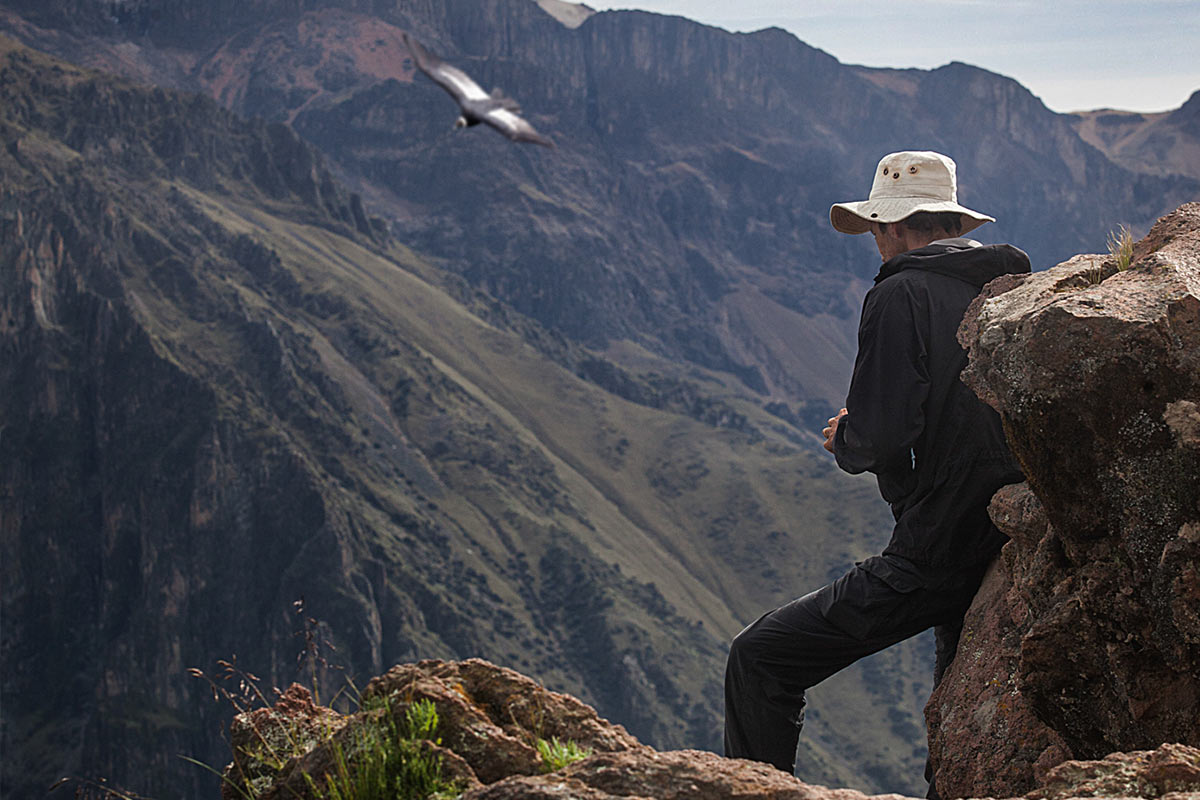
Andean condors are always a highlight of Colca Canyon, trekking or not. Original photo by Peru For Less.
Trekking Highlights
A Colca Canyon trek, on the other hand, is a genuine way to experience the stunning beauty and small rural villages that have endured for centuries within the depths of the canyon. And with some luck, you may also spot Andean condors.
In Peru, it isn’t always convenient or possible to trek independently (such as on the Inca Trail or through the Amazon Rainforest ). Colca Canyon, however, is a wonderful place to venture on foot with the option to go with a guide or on your own. For more planning information, contact our team of experts to include a Colca Canyon trek and other regional attractions into your custom itinerary to Peru.
If you know you are going to Colca Canyon without a guide, then scroll down and read our tips for independent trekkers in the next section.
Tips for Trekking Without a Guide
A self-guided Colca Canyon hike is an adventure and a great option for saving money. The following are a few helpful tips to plan a fun and safe trek into Colca Canyon.
Plan your route. Trekking options from Cabanconde are plentiful and readily available. Purchase a map of the area and plan a Colca Canyon trekking adventure. Informal advice and information are also available from hotel staff and fellow hikers within the canyon. In general, don’t attempt a long trek alone unless you have the necessary equipment, skills, and prior experience. Check out our Packing Essentials section below.
Pick up outdoor gear in Arequipa . Trekkers that need equipment rentals, sportswear, maps, and any other instruction are best served in Arequipa, before heading into Colca Canyon.
Stay hydrated. The high elevation and strong sun in Colca Canyon make it important to stay hydrated. You can buy bottled water in Sangalle, San Juan de Chuccho, and other villages along the way. It’s also handy to have water purification to cut down on plastic usage.
Choose where to spend the night. There are numerous campsites. Outside of the villages and towns themselves, there are no services whatsoever so be sure to bring everything you’ll need. Additionally, there are simple lodges in some villages where you can spend the night instead if you prefer to travel lighter without overnight sleeping gear. It’s possible to book your stay online at a few canyon lodges.
Bring enough cash. There are not ATMs in Cabanaconde or any of the small villages on the walking circuits inside Colca Canyon. As such, plan and take out enough money in Arequipa before heading to Colca Canyon or in Chivay. Factor into your budget, sufficient Peruvian soles for transport, tourist ticket, food, water, lodging (if not camping), and other expenses.
Carry your boleto turistico in an easily-access spot in your backpack. Park officials may ask to see it at one of the various checkpoints in Colca Canyon.
Trekking Tours:
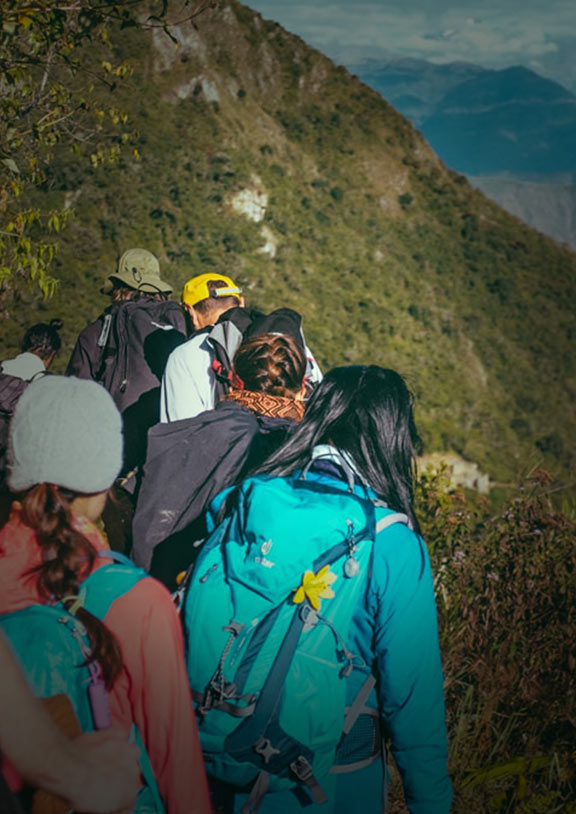
Packing Essentials
Here are items of outdoor clothing and equipment for your Colca Canyon trek:
- Sturdy hiking shoes with good traction. Colca Canyon isn’t flat and sections of trails are gravel.
- Don’t forget a warm jacket , along with activewear, socks, and toiletries. Temperatures drop at night (~25°F, or4°C), especially during the dry season when hiking conditions are best. Planning a Colca trek during the rainy season? Then, don’t forget a rain jacket and other waterproof gear.
- Remember a bathing suit if you plan to enjoy the hot springs in the Colca region – before, during, or after your trek.
- Trekking poles aren’t required but highly recommended for extra balance along steep sections of trail.
- Comfortable backpack to carry your camera, water, and other outdoor essentials.
- Bring sun protection : a wide brim hat, sunglasses, and sunscreen.
- Have plenty of cash . There is not an ATM in Cabanaconde or any of the smaller villages within Colca Canyon. Read about money in Peru .
- Carry a reusable water bottle or water bladder backpack, like a Camelbak, to stay hydrated during your outdoor adventure.
- Apply bug spray if you notice pesky mosquitos around the river in Colca Canyon.

Set off on an exciting trekking adventure in Colca Canyon. Photo by free range jace/Flickr .
Start Planning
A guided or independent Colca Canyon trek is a great addition to your exploration of the world’s second deepest canyon. If you haven’t already read our Colca Canyon Travel Guide , it goes hand-in-hand with planning a trekking adventure and includes helpful information like how to get from Arequipa to Colca Canyon, so be sure to check it out.
Most Peru trekking experiences are focused around Cusco , Machu Picchu , and the Inca Trail but the country has a lot more to offer, and one of the finest and most rewarding alternatives is a trek in the Colca Canyon region near Arequipa. Contact our team and discuss the best way to fit a trek in Colca Canyon, Peru to your custom itinerary.
*Article was updated in July 2020.
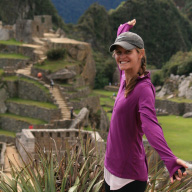
Britt is a California native who now calls Peru home. She is a traveler with a passion for all things outdoors, scuba diving, and capturing memories with her camera.
Tags: Colca Canyon , Colca Canyon Trek
Related posts:

Where to See Condors in Peru
Explore the best places to see condors in Peru including the magnificent Colca Canyon in Arequipa, the world’s second deepest canyon and one of Peru’s most popular destinations.
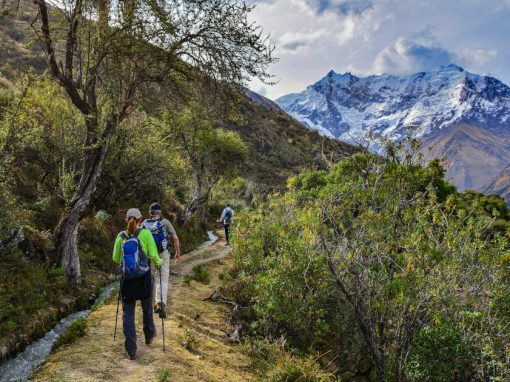
27 Best Treks in Peru: Hiking in the Andes and Beyond
Check out our list of the top 27 best treks in Peru, with hikes like Ausangate, Rainbow Mountain, Laguna 69, Inca Trail, Kuelap, Huayna Picchu and more.

Start Planning!
Explore all our best-selling packages
See All Packages
Book With Confidence
We're flexible! Postpone your tour with zero cost up to 10 days prior to departure.
The following preferences are optional , but will help enhance your trip's customization.
Are you interested in visiting the best restaurants in Latin America?
Book with confidence
We're flexible! Postpone your tour with zero cost up to 10 days prior to arrival with open dates
( Optional. You may choose more than one)
TIP: Tell us the destinations you have in mind.
- Tour Packages
- Machu Picchu
- Amazon Rainforest
- Galapagos Islands
- Sacred Valley
- Lake Titicaca
- 5000+ Reviews
- Travel Guides
- Work With Us
- Responsible Travel
Rely on our expert services to customize a unique experience. Comfortable hotels, tours, and all transportation. 24/7 in-trip support.
Our Peru For Less Travel Blog is a living library of travel information, knowledge, and advice from a group of travel loving experts who live, work, eat, and breathe all things in South America.
"Our tours are Fully Customizable and leave 365 days a year!"
- Destinations
1-817-230-4971
Sales & travel support

The Colca Canyon Trek in Peru: the ultimate travel guide
This post is about my experience on the Colca Canyon trek in Peru and how to choose the best Colca Canyon tour.
The Colca Canyon is one of the world’s deepest canyons, even deeper than the Grand Canyon in some areas. The dramatic landscapes, towering cliffs, and lush valleys make it one of the most beautiful treks in Peru.
The Colca Canyon trek is not easy. The altitude and the steep climb in and out of the canyon make it a challenge. However, it is one of the best things to do in Peru, offering stunning views and the chance to see the majestic Andean Condor. One of the largest birds in the world.
The Colca Canyon trek is also a cultural experience with traditional villages home to indigenous communities. Along the trek, you’ll have the chance to interact with local communities that have preserved their traditional ways of life for generations. You can learn about their farming practices, unique customs, and ancient traditions.

Colca Canyon Trek Tours
There are a variety of Colca Canyon tours available in Arequipa, but they differ in quality and activities. From one day tours that do not include the Colca Canyon trek to 3 day tours that include two nights inside the canyon.
In this post I will share my own experience on the Colca Canyon trek and some advice to consider when booking your Colca Canyon tour. Is the colca canyon trek necessary? How many days do I need for the Colca Canyon trek? Can I do the Colca Canyon trek on my own?
I hope this post helps you in choosing the right Colca canyon tour or to do the Colca Canyon trek on your own.
Colca Canyon Trek Experience
I was sweating and my knees were shaking. The bridge, where the rest of the group was waiting for me, was still far below. It was warm and there was no cloud in sight for some relief from the strong sun. My only comfort was that my loyal guide, that I just met a couple of hours ago, remained by my side.
I could have known that the Colca Canyon trek was not going to be easy. The Colca canyon is one of the deepest canyons in the world. In fact, in some places it is twice as deep as the more famous Grand canyon.
Altitude sickness on the Colca Canyon trek
A combination of altitude sickness with a stomach bug made me one of the slowest hikers that day. The night before I was still running up and down to the toilet. I was thinking about cancelling my tour, but I was stubborn.
I put my alarm clock at 3 AM ignoring the protesting sounds of my tummy. Luckily I felt better when I woke up. Despite the early hour, Arequipa’s youth was out and about. Young girls and boys stumbled out of bars and discotheques to find their way home. Taxis were waiting eagerly for business while our bus had to maneuver itself through the small streets of Arequipa.
It was a 3 hour drive to the Colca Canyon right through a National Reserve. The highest point reaches an altitude of almost 5000 meters. Most of my travel companions continued their sleep, but I was looking outside. As the sun was rising I discovered a bare landscape. All I could see were some shrubs and the occasional group of lama’s.
Chivay and the Condors
We had a quick breakfast in Chivay, our first town in the Colca Canyon. The next stop was the Cruz del Condor, the viewpoint where you can see the Condors flying through the canyon. These majestic birds are the reason for our early departure from Arequipa. Condors are most active between 8 and 9 AM.
Our tour only gave us 15 minutes. I was sad we were given such little time, but my body already started to feel the effects of the altitude. We were now above 3500 meters and I felt light headed and tired.
Hiking to San Juan de Chollo
After the Condors we were rushed to the starting point of our Colca Canyon trek. With a light headache we started the hike into the canyon. It was a 4 hour steep descent to the bottom. I was exhausted when we finally arrived at our homestay in San Juan de Chollo.
It was a hard day and I was slightly worried for the coming two days. I knew that getting out of the canyon means I will have to climb the same distance up that I went down today.
Life in the Colca Canyon
The next day we had an early wakeup call by a small earthquake. I was still a bit shaken from the experience when we started our trek to the next town. Today was much easier, because we were now hiking through the canyon rather than going down or up.
As we passed several villages our guide explained how life is changing since they have a connection with the road. There was a lot of construction going on and simple huts were transformed into concrete houses. For us tourists, these visual transformations may take away part of the natural beauty of the area, but for the local people it means better access to education and healthcare.
The Colca Canyon Oasis
That night we slept in the Oasis, a tourist resort with a pool where all tourgroups gather. It was a huge contrast with our lodge from the previous night that felt more like a homestay. This place is only for tourists and will give you more insight in the lives of backpackers than the local culture.
The Oasis is at the bottom of the steep road out of the Colca canyon. The next day we had another early start to reach the top around sunrise. It was a tough climb and I did not make it before sunrise. However, I felt I did a good job getting there within 3 hours.
Sightseeing in the Colca Canyon
The rest of the day was a somewhat touristic tour past several sites on our way back to Arequipa. After my hike in the canyon, it felt a bit unnecessary, but it was nevertheless fun.
In Yanque we visited a beautiful old church where ladies allowed you to take pictures with their lama’s.We also stopped at some viewpoints, but they could not beat the views on the Colca Canyon trek itself. It was a tough hike, but for me the best way to get to know the Colca Canyon.
What is the Colca Canyon trek?
The Colca Canyon is one of the most beautiful areas in Peru famed for its colourful and traditional towns and for its wildlife. There are over 100 species of birds including the giant Andean condor that you can see flying by at the Condor del Cruz.
The Colca Canyon is also one of the deepest canyons in the world. It is, in some places twice as deep as the Grand Canyon. The Colca Canyon trek is the challenging hike in and out of this canyon. For many this is one of the highlights of their trip to Peru.
The Colca Canyon trek Route
Cabanaconda is the starting point of the Colca Canyon trek. There are several trekking route options, but they all start with a steep walk down to the bottom of the canyon and end with another steep hike out of the canyon.
The western loop (27 km): If you take the western loop you come across the villages of Lahuar, Belen and the Oasis (Sangalle).
The eastern loop (22 km): If you take the eastern loop you come across the villages of San Juan de Chollo, Malata and the Oasis (Sangalle)
Full loop (31 km): The full loop combines the eastern and western loops, going through the villages of Lahuar, Belen, Malata and San Juan de Chollo
Most trekking routes can be done in 2 days with an overnight stay in one of the villages. However, the trek is challenging and I would recommend to take at least 3 days for the Colca Canyon trek. This way you will have more time to appreciate the villages you walk through without being completely exhausted.
How to choose your Colca Canyon tour?
The first thing you have to choose is whether you want to visit the Colca Canyon independently or with a tour through a travel agency and whether you want to include the Colca Canyon trek or not.
Is the Colca Canyon trek necessary?
The Colca Canyon trek is spectacular and if in any way, you are able to do this hike, you should without doubt. However, if you are physically not able to do the Colca Canyon trek, there are enough interesting villages to visit that you can reach by car to explore this area.
In my opinion the towns on top of the Colca Canyon were a bit set up for tourists, but it will still give you an insight into the unique culture of the Colca Canyon. Most tourgroups will stop for less than an hour in the villages so if you have more time and travel by public transport it is easy to have a more authentic experience.
Is a Colca Canyon tour necessary?
You do not need a tour through a travel agency to visit the Colca Canyon including the Colca Canyon trek. The trail is well marked and with a bit of planning, it is possible to do the trek on your own. This will give you much more freedom and flexibility to explore this region at your own pace.
However, you do need enough time and patience and you will probably not be able to visit all the places that are included in the tours. Public transport between the towns on top of the Colca Canyon are infrequent and you need to know the bus times beforehand. For example, Cruz del Condor and Yanque have very limited connections with public transport.
If you have limited time I can therefore recommend you to take a tour. If you are adventurous and have enough time (at least 3 – 4 days) you can very well do it on your own.
How to travel to the Colca Canyon independently?
From Arequipa there are frequent buses to Chivay and even a few buses directly to Cabanaconda where you need to go to start the Colca Canyon trek. From Chivay there are 4 buses per day to Cabanaconde.
If you are coming from or continuing your journey to Cusco or Lake Titicaca check my tour Peru bus (Puno).
In the canyon accommodation is available in the villages Chivay, Cabanaconda, Lahuar, Belen, San Juan de Chollo, Cosnirhua, Malata and the Oasis (Sangalle). If you already know your Colca Canyon route, it is best to book accomodation online. You can also arrive on the spot, but in high season places may be fully booked.
Chivay : for a budget option choose Rumi Wasi , for more comfort the beautiful Casa Andina
Cabanaconda : for a budget option choose Homestay Pachamama , for more comfort Hotel Kuntur Wasi.
Malata (Tapay) : for a budget option choose Posada Gloria , for more comfort Colibri Lodge
The advantages of a Colca Canyon tour?
In Arequipa there is no shortage of travel agencies offering tours to the Colca Canyon that include the Colca Canyon trek. The tours are good value (50$ – 60$) and doing it yourself will probably be more expensive.
Furthermore, it saves you a lot of time and the tours include different stops along the way. Although touristy, some of the viewing points were very beautiful.
How many days?
You can choose between a 1 or 2 day tour by van without the Colca Canyon trek or a 2 to 3 day tour including the Colca Canyon trek. Most tours start at 3 AM to ensure you can see the condors in action at 8 AM.
The 1 and 2 day tours by van will stop at some viewpoints and villages on top of the canyon such as Chivay, Yanque and Cabanaconda. The Colca Canyon trek will offer you a much more intimate experience.
The Colca Canyon trek is not an easy hike and therefore I would definitely recommend you to take the 3 day tour rather than the 2 day tour. The route is the same so having 3 days makes it much more easier. Really, I don’t think I would have been able to walk in and out of the canyon in 2 days.
Another reason is that the 3 day tours stop in San Juan de Chollo for the night, which I thought was a nice village. The 2 day tours stay only at the touristy Oasis.
Colca Canyon Tour options
1 day tour by van (without the trek) : only recommended if you are really short on time. It will be a very long day (starting at 3 AM) and most of it is travelling from Arequipa to the Colca Canyon and back with some brief stops at Cruz del Condor and other touristy towns on top of the Canyon.
2 day tour by van (without the trek) : Recommended for those that prefer not to do the Colca Canyon trek, but still want to get a good sense of the villages on top of the canyon. Another advantage of the 2 day tour is that you avoid the early start of 3 AM. Because you are sleeping at Colca Canyon you will get to see the Cruz del Condor the next morning.
2 day Colca Canyon trek: If you only have 2 days and you are fit enough, this is an option, but your first day will be very long. Starting at 3 Am and hiking all the way from Cabanaconda down into the canyon through San Juan de Chollo and then the Oasis in a single day.
3 day Colca Canyon trek : This is the best option in my opinion. You do the same route as the 2 day Colca Canyon trek, but you stay in both San Juan de Chollo and the Oasis (Sangalle). This allows you more time in the villages in the canyon and makes the trek more easygoing.
Where should I book my Colca Canyon tour?
In Arequipa there are a lot of travel agencies and as I have experience with only one agency it would be hard to recommend one over the other.
Do your homework and read some reviews. Prices and quality differs, so compare the offers of several travel agencies and check carefully what they do or do not include.
I booked my tour through Peru Hop and also visited Ica with them. You can read about my experience with Peru Hop and about my experiences in Paracas in my post on things to do in Paracas .
Safety on the Colca Canyon trek
The colca canyon trek is absolutely safe whether you do it on your own or with a Colca Canyon tour. There are just two things to keep in mind
Altitude sickness in the Colca Canyon
The Colca Canyon tour brings you to high altitudes. Chivay is at 3632 meters where altitude sickness is a risk.
It is hard to predict who will suffer. Mild symptoms may include being tired and more easily out of breath. More severe symptoms of high altitude sickness are headache, dizziness, trouble sleeping, breathing problems, loss of appetite, nausea and vomiting.
Local remedies include drinking coca tea, chewing on coca leaves or using something called agua de florida. Whether they are really effective is up to debate.
What does help prevent altitude sickness is acclimatization. You need to give your body enough time to adjust to the height. This starts in Arequipa that is at an altitude of 2325 meters. Spend at least one or two days in Arequipa before you head to the Colca Canyon.
Diamox is a medicine that might help your body to acclimatize, but will not cure altitude sickness once you have severe symptoms. In that case, the only remedy is to go down to a lower altitude as soon as possible.
Severe symptoms indicate you are developing high altitude cerebral edema (HACE) or high altitude pulmonary edema (HAPE). Both conditions are fatal if you do not get to a lower altitude on time.
Heat stroke
The sun is strong in the Colca Canyon and during the trek there is not a lot of shade. Bring something to protect your head, sunscreen and enough water to prevent sunburn and a heatstroke.

Sustainable travel in the Colca Canyon
The Andean region, including the Colca Canyon is affected by climate change that has a huge impact on the local people. The indigenous communities in Peru, have faced historical discrimination and challenges related to their land rights and cultural preservation. Climate change is now another challenge to their way of life.
The Colca Canyon sees more tourists every year. While Tourism is a welcome source of income for the local community it can also have negative consequences. Traveling sustainably in the Colca Canyon, involves conscious choices that minimize your environmental impact in these remote and pristine ecosystems.
Stay in small scale sustainable hotels : It is better to stay in locally-owned guesthouses or homestays to support the local economy directly. These accommodations often have a more positive impact on the environment compared to large hotels. I can recommend staying in a homestay for an authentic cultural experience. You might want to bring a small book with pictures of your family to break the ice.
You can try to look for guesthouses or homestays that prioritizes sustainable practices. That said, environmental awareness is still low. It’s up to you to use water sparsely, turn off lights, air conditioning, and heating when leaving your accommodation.
Leave no Trace principle : When hiking the Colca Canyon trek, stick to designated trails to protect the fragile ecosystems. Straying off the marked paths can cause soil erosion and damage to plant life. If you are lucky enough to spot wildlife, observe quietly from a distance to prevent disruption to their habitats and help maintain their natural behaviors.
I encourage you to take all your trash back with you and dispose of it responsibly. In other words, leave no trace of your visit. Even better is when you bring something to pick up any of the trash that other people left behind.
To avoid single-use plastics, invest in reusable items. For example, you can bring your own water bottle with a filter that you can refill at your accomodation. At last, use biodegradable and eco-friendly personal care products to minimize pollution of water sources.
Respect the culture : Besides environmental concerns it is also important to respect the culture. Peru is a multicultural country home to a number of indigenous groups. Therefore, learn about the local customs and traditions beforehand and be mindful of your behavior.
People will appreciate it, if you dress modestly, especially at religious sites. Learning a few basic phrases in Spanish, can go a long way in building meaningful connections and to learn more about the local culture. Not everybody is happy to have their picture taken. When in doubt, ask permission.
Disclaimer : This post about hiking the Colca Canyon trek in Peru contains affiliate links. If you buy any service through any of my links, I will get a small commission at no extra cost to you. These earnings help me to keep Backpack Adventures alive! Thanks for your support!

11 thoughts on “The Colca Canyon Trek in Peru: the ultimate travel guide”
This sounds like an amazing experience and looks like a beautiful place. I had no idea Colca Canyon is twice as deep as the Grand Canyon and the part about being woken up by a small earthquake.. WOW!
Woooowwww…. I’m debating how much of Peru I would do for my South America trip end of this year. Undoubtedly I would still be debating right up to the trip itself haha. Definitely will keep this for later though. The condors is what did it for me! And, I’m not sure what my level of fitness is relative to other backpackers so it’s good to know, uh… what happens if you’re not as fast as the others… 😀
First of all thank you for this blog .it helped me a lot to plan my colca canyon trek
So sad we missed this when we were in Peru – looks incredible! I definitely don’t miss being at altitude though, that was the toughest part of travelling in South America for us.
Great read Ellis, I’ve not walked/hiked in a high altitude area but I can imagine it must be really tough on your body – i’m really impressed you managed to get up at 3am despite not feeling well!! This part of the world looks beautiful and I’ll definitely be taking your tips into consideration if I visit Peru one day 🙂 Ellie
Wow that looks like an amazing experience! Loving your photos. I’m so looking forward to South America and finding some interesting activities like this to do. Great info for how to get there too 🙂
Great post & photos! I just did an article on ten amazing places in Peru that are not Machu Picchu — this was one of them. Hope to see it in person some day.
Great snaps!! … Good that you managed the travel and hike inspite the altitude sickness and the tummy bug issue. Also good to see these villages as you hike the Colca canyon. Colca canyon is indeed very deep if its twice as deep as the Grand canyon!! Loved those birds too Condors flying about!!
This canyon seems like a great idea! Hiking there would be a dream come true!
Great read Ellis, I’ve not walked/hiked in a high altitude area but I can imagine it must be really tough on your body – i’m really impressed you managed to get up at 3am despite not feeling well!! This part of the world looks beautiful and I’ll definitely be taking your tips , loved it <3
Appreciating the time and effort you put into your website and in depth information you offer. Awesome places to explore. I would like to suggest it to my friends so that we can plan a trip and take a time for ourselves in this busy schedule. Keep posting such wonderful places. Thanks a lot!
Leave a Reply Cancel reply
Your email address will not be published. Required fields are marked *
- Kale by LyraThemes.com.
Thrilling 2 Day Colca Canyon Trek | What to Expect
Take a trip through Peru’s Colca Canyon, one of the deepest canyons in the world, and find yourself in an oasis over 3,000 meters down. This adventure takes you through challenging terrains, offering breathtaking views, traditional villages, and the chance to witness majestic Andean condors in their natural surroundings.
IMHO – the guided trek was worth it despite some things falling behind expectations.
In this article, I’m giving you a rundown of why you should do the Colca Canyon tour, the logistical questions you may have, and my personal experience doing the tour.
Let’s get started!
Why do the Colca Canyon Tour?
If trying out new experiences is not enough to budge you to do this tour, here are some reasons why you should at least consider it.
1. Witness the Flight of Condors
Imagine standing at the canyon’s rim, captivated by the awe-inspiring dance of Andean condors. These magnificent birds, with wingspans reaching up to 3 meters, are a living testament to the grandeur of nature. It was a dramatic scene to witness, that I can spend over an hour just watching them soar through the skies. We were fortunate to spot at least 15 condors when we were there.
2. See and Stay at a Natural Oasis IRL
Descending into the canyon, we encountered Sangalle, an oasis at the canyon’s base. The oasis reminded me of the hanging gardens of Babylon. earthly Eden, boasts vibrant plant life, crystal-clear pools, and an otherworldly tranquility. It offers a serene contrast to the arid landscapes we had hiked earlier. The oasis, also known as the “Green Valley,” is a welcome surprise, providing a peaceful retreat. Unfortunately, the accommodations we had that night did not live up to expectations.
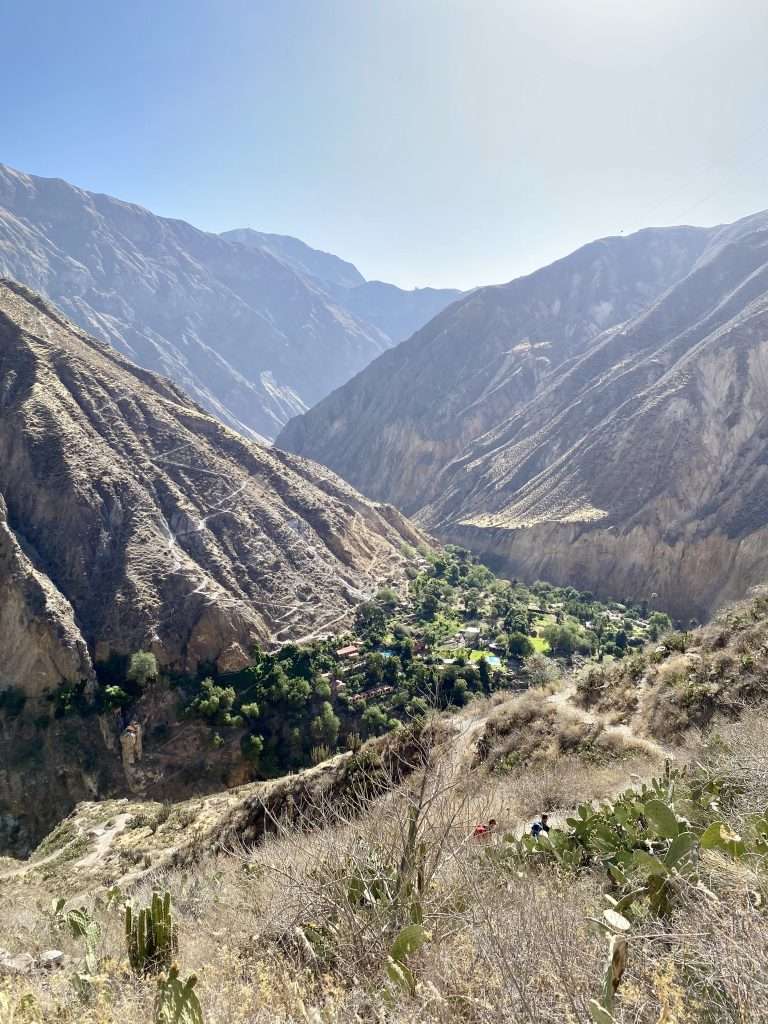
3. Geological wonder deeper than the Grand Canyon
Colca Canyon’s claim to fame goes beyond its sheer depth—it surpasses the renowned Grand Canyon in the United States. The canyon reaches a depth of over 3,270 meters, dwarfing the Grand Canyon’s lowest point at approximately 1,857 meters. This staggering depth provides not only a geological marvel but it is also the homeland of the Colca people, with traditions dating back centuries.
4. Be physically and mentally challenged
The Colca Canyon trek takes you to a variety of altitudes that is both a physical and mental challenge to even the fittest hikers. Starting at an elevation of around 3,350–3,400 meters, the trek meanders through diverse landscapes, from rocky terrains to verdant valleys, before descending to the oasis at 2,250 meters. The altitude fluctuations, ranging from 1,000 to 4,000 meters above sea level, shows the canyon’s geological diversity over its extensive 70-kilometer stretch. If you’re looking to get your steps in and want to also test your willpower, the Colca Canyon trek is a tour you should consider doing.
🔗 Related : 10 Best Hostels in Arequipa Peru
Is the Colca Canyon Tour worth it?
Trekking through the Colca Canyon became a standout experience during my trip to Peru, and here’s why. First and foremost, witnessing the flight of the condors was nothing short of dramatic. Spending over an hour watching these majestic birds gracefully soar through the skies was a spectacle to remember. Counting ourselves fortunate, we spotted at least 15 condors during our time there.
Adding to the allure was the oasis nestled at the bottom of the Colca Canyon. It exceeded my expectations, resembling what I’d envision the Hanging Gardens of Babylon to be. The photos I took, however, fall short of capturing the profound contrast between the dry, barren path and the vibrant, bountiful oasis that lies beyond.
Now, let’s talk about the hike itself. The descent into the canyon may lull you into a false sense of ease, but be prepared for the unexpected challenge as you ascend to the top on the final day. Keep in mind that Colca Canyon is among the world’s deepest canyons, so it’s no casual stroll. Having a set of hiking poles would have been beneficial on this journey.
So my honest opinion? The 2-day hike is unquestionably worth it—despite the exhausting hike, the sight of condors and the sense of accomplishment upon reaching the top on Day 2 justifies the early starts and hard effort. This part of Peru is not frequented by everyone, adding an extra layer of specialness.
When is the best time to do the trek?
The best time to do the Colca Canyon trek is during the dry season, which spans from May to October. Within this timeframe, June to September are often considered optimal.
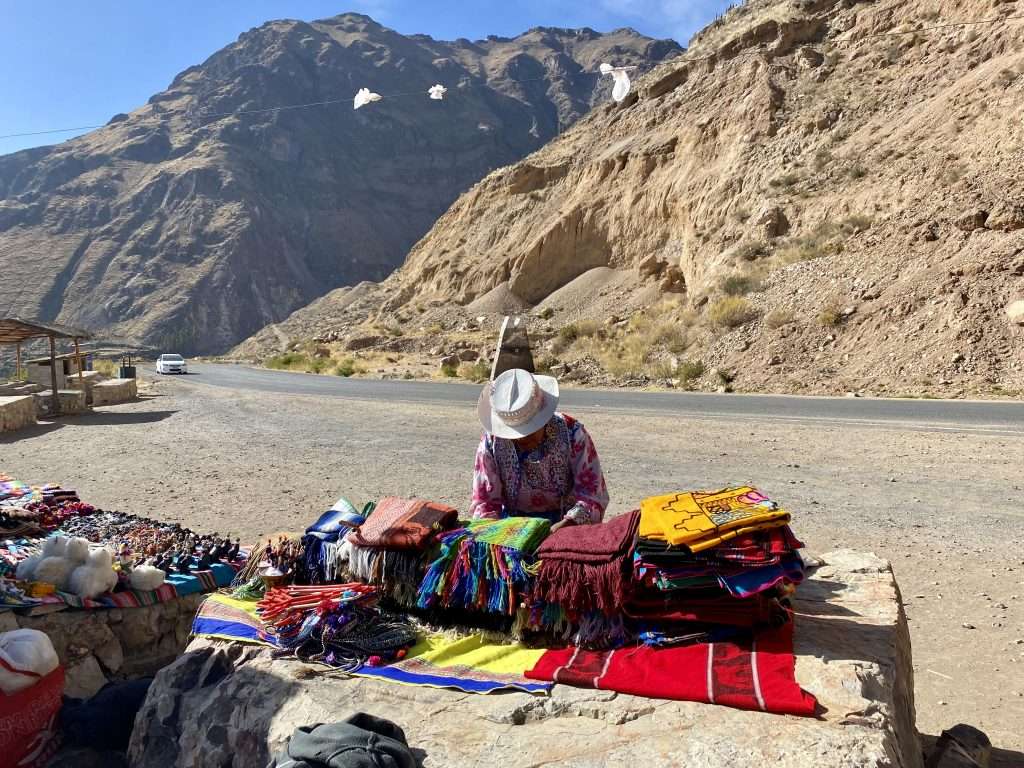
The temperatures will be milder in these months, especially during the day, making it conducive for both the ascent and descent. Additionally, the dry season coincides with the Andean summer, offering better visibility for enjoying the stunning landscapes and, of course, the flight of the condors.
It’s worth noting that while the dry season is popular, the Colca Canyon can be visited year-round. However, the wet season, from November to April, brings heavier rainfall, making trails slippery and potentially more challenging. Regardless of the chosen time, it’s advisable to check local weather forecasts and trail conditions for a smoother and more enjoyable trekking experience.
Colca Canyon Hike Options
Full Day Tour of Colca Canyon This full-day adventure begins at the early hour of 3 am and concludes by 6 pm. It’s the favored choice for those looking to experience the canyon without committing multiple days and taking the long hike.
Ideal for a day trip from Arequipa, it condenses the highlights of the 2 and 3-day tours, incorporating additional attractions without the need for extensive hiking.
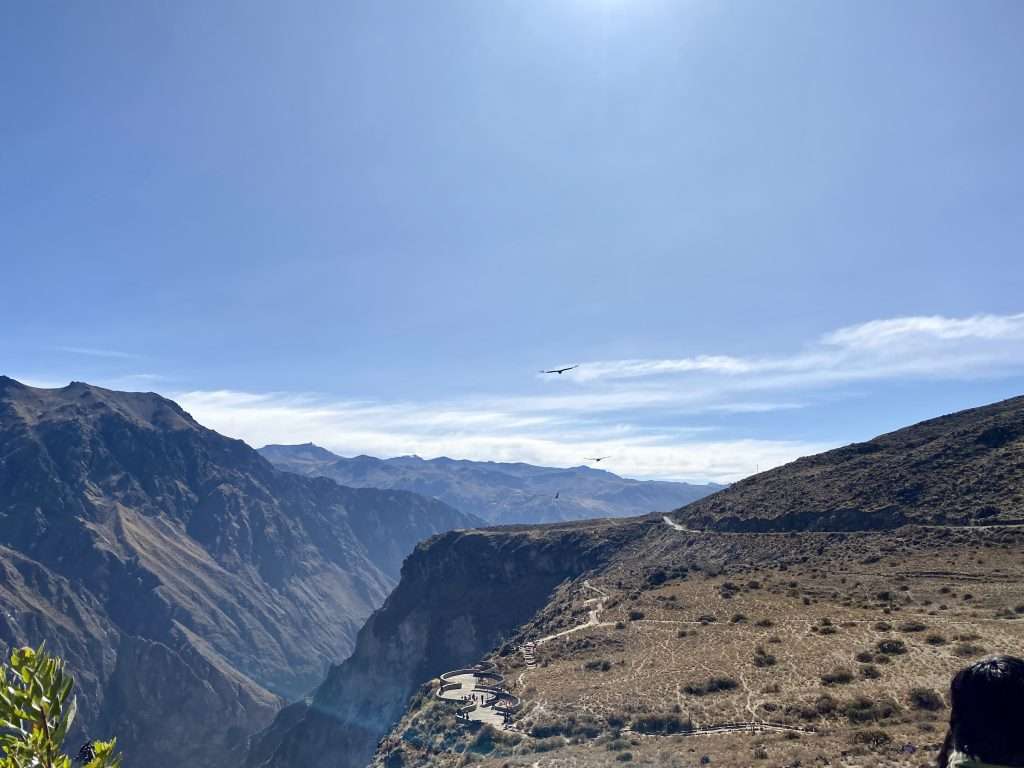
The sightseeing tour includes Chivay Town, viewpoints of the valley terrace, Mirador and Cross of the Condor, Cactaceae Forest (Pinchollo), Viewpoint and Lagoons of Antahuilque, Volcanoes Viewpoint (Patapamapa), a visit to hot springs, and the observation of Andean camelids (llamas, alpacas, and vicuñas).
2-Day, 1-Night Trek Undoubtedly the most popular option, this condenses the highlights of Colca Canyon into a manageable timeframe. It’s for those that want to hike and stay at the oasis. You’ll get majority of the highlights you get on the full day tour plus a stay at the oasis and the the challenging ascent from Oasis de Sangalle up to Cabanaconde.
This trek captures the essence of Colca Canyon in a brief yet worthwhile hike. I’ll talk more about how the experience is in the next section.
3-Day, 2-Night Colca Canyon Trek This extended adventure, spanning three days and two nights, follows the familiar route of the 2-day trek but introduces a strategic overnight stay in San Juan, which is the lunch stop on the 2-day trek.
The additional day serves to break up the 15 km typically covered in just one day on the 2-day trek. Day 3 mirrors the final day of the 2-day trek, involving the challenging 1000m climb from Oasis de Sangalle up to Cabanaconde.
Tailored for those seeking a more relaxed pace due to physical considerations, this slower-paced trek offers a longer stay at the canyon.
Alternatively, enthusiastic and physically fit hikers can extend their hike and go longer than the usual hike although this is usually a DIY or unguided option.
How difficult is the Colca Canyon Trek?
The Colca Canyon Trek is quite tough, no matter which way you go. How hard it is depends on how fit you are, how fast you go, and which path you take. All treks start with a steep walk down into the canyon, but the real tough part is climbing back up because it’s really steep. If you’re on a tour, they can arrange a mule to help you up on the second day.

But if you’re hiking alone, you can ask the places you stay for help finding a ride. If, for some reason, you can’t finish the trek, there are options. In Llahuar town, you can get a ride from the Llahuar lodge to Cabanaconde. The lodge can help with that. And from Sangalle to Cabanaconde, you can get a mule to hike you out of the canyon. The homestays in the oasis can help with that too.
Getting lost is not likely, but if it happens, stay calm. Stop, think, look around, and make a plan. Some villages in the canyon have cell service. If it’s an emergency, you can call the High Mountain Rescue Unit in Chivay at (054) 531-165 for help. So, even though the Colca Canyon Trek is tough, there are ways to handle the challenges and make it through
Can you DIY the Colca Canyon Hike?
Absolutely, you can embark on a do-it-yourself adventure for the Colca Canyon hike. Many independent travelers opt for this approach to tailor the experience to their preferences. To DIY the Colca Canyon hike, start by researching the trail, understanding its difficulties, and planning your route. You can arrange transportation to the trailhead, manage your accommodation, and explore the canyon at your own pace. Ensure you’re well-prepared with maps, essential gear, and information on local support services.
However, with the DIY option, meticulous planning is key. Although the Colca Canyon trek is generally straightforward, lacking extensive signage makes it relatively easy to lose your way. It’s unfortunate but true that there have been instances of hikers going missing while trekking Colca Canyon on their own. During our hike, we encountered posters of a missing hiker who had not yet been found. Therefore, if you opt for the DIY route, it’s strongly recommended to plan your entire journey meticulously to ensure a safe and enjoyable trip to Colca Canyon.
Is it worth to DIY the Colca Canyon hike?
In my view, taking a guided trek is the best way to enjoy the Colca Canyon. Some people choose to go on their own, thinking it saves money. But the truth is, the two-day guided Colca Canyon trek costs about $72, and it includes 2 breakfasts, 1 lunch, 1 dinner, and a stay in the Oasis de Sangalle. Doing the trek by yourself won’t likely be much cheaper than a guided tour. Plus, with a guide, you get someone who knows the way, can show you interesting things, and can get help if you can’t continue or get hurt. The trek can be tougher than expected—during our hike, we saw about 5 mules carrying passengers. A guide can quickly arrange this help. If you’re on your own, it could be much harder. Going with a guided trek is also safer.
So, if you’re thinking about trekking the Colca Canyon, I really suggest going with a guided trek. Besides taking care of extras like transportation and visits to attractions, a guided tour is a safer choice for around the same price as it would cost you to trek by yourself.
Honest Review of the 2 Day, 1 Night Colca Canyon Tour
The day kicked off crazy early at 3:00 am. Got picked up, and we headed to Chivay, arriving at 6:30 am for a breakfast feast of scrambled eggs and bread. Then, we hit the road for a two-hour (42 km) ride to La Cruz del Cóndor. We witnessed the mind-blowing flight of those Andean condors—massive wingspans and all—at a cool 3400 meters above sea level. Counted ourselves lucky to spot at least 12 of these majestic birds.
At around 11am, we reached Mirador de San Miguel, and that’s where the real deal began—the descent. Quick heads up, the downhill part felt like a breeze, but brace yourself for the uphill surprise on the last day. Colca Canyon ain’t your average stroll, and I really wished I had packed a set of hiking poles.
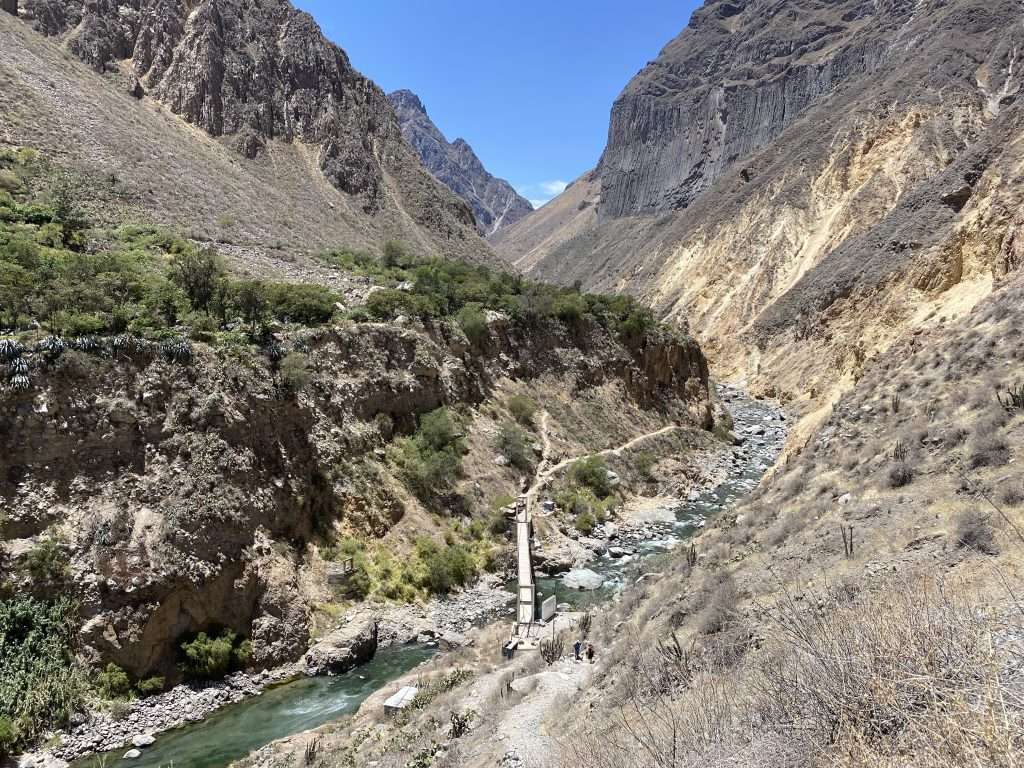
After 3 hours of hiking, we hit the first suspension bridge, took a breather, and trekked to San Juan de Chuccho for lunch, making pit stops in Malata and Cosñirhua. The lunch at Juan de Chuccho was at unassuming restaurant. It looked more like a home than an eatery but the food was good, and that’s all that matters.
Come 5:00 pm, we landed at the oasis—a nice spot with cold-water pools. The path heading to the oasis was dry and barren so you can imagine how easy is it to spot the oasis from afar. With its palm trees and lush greenery, you can easily tell where the destination is.

After sweating it out on a 15 km hike, swimming in the pool was a no-brainer. Thankfully we arrived at a time when there’s still sunshine left.
We had to set the alarm for 5:00 am—ouch! We started the 3 ½ hour ascent in the dark using torches, and let me tell you, it was freezing! The uphill journey was a rocky, leg-burning adventure, especially after a full day of walking the day before. It doesn’t help that breakfast is not served until after the ascent up (don’t ask me why) so the entire hike up was more draining than should be. Now, I like to think I’m a pretty fit hiker, but this trek really gave my legs a workout. Had to take a few pit stops to ease the knee pain.
When we made it to the top, we were greeted by a lady was selling hot tea, coffee, and snacks. I waited for the entire group to catch up before the final 30-minute push to the breakfast spot. Breakfast was basic, in what felt like someone’s home, but it was a great spot to rest and regroup after two intense days.
Around 11:30 am, we hit Yanque for a one-hour soak in the thermal medicinal baths—total recovery mode. Paid 15 sols for entry, and trust me, it was worth every penny after that hardcore hike. Surprisingly, it was super relaxing and didn’t feel like your usual tourist trap. Maybe it was just
After that, we headed to Chivay for lunch, a buffet stop (optional, extra charge – but totally worth it). Post-lunch, we embarked on the journey back to Arequipa with tourist stops in the National Reserve (Mirador de los Volcanes 4910m) to spot some llamas and vicuñas.
So, the Colca Canyon tour—no doubt a challenging adventure, but with breathtaking views and a serious test of your strength. It was totally worth the sore legs!
How far in advance should I book a tour?
Booking your Colca Canyon tour in advance is a smart move to secure your spot, especially during peak seasons. I found that booking it 2-3 days before the tour is sufficient especially that there are plenty of tour operators doing this tour.
How were accommodations?
Our stay at the Oasis Paraiso Ecolodge had its ups and downs. While the huts provided decent beds for a night’s rest, certain aspects fell short of expectations.
The accommodation had two bathroom facilities, but unfortunately, only one was operational. The other, technically open, dispensed dirty water and showed signs of neglect. Within the working facility, most cubicles were out of order, with persistent drainage issues, and the presence of dogs in the area sometimes led to unsanitary conditions.
Now, let’s talk about the meals. The food was basic, bordering on mediocre, making it one of the less impressive aspects of the tour. It’s important to note that you can purchase bottled water or alcohol, but I’d recommend bringing a 2L water bladder and filling it up before the hike to save costs.
It’s also wise to pack some snacks since breakfast is served after the demanding 3-4 hour trek to the top on day 2. Overall, while there were some drawbacks, the accommodation experience was in line with the expectations for the budget, offering a place to rest in the stunning Colca Canyon.
How to prepare
- Acclimatization is Key Before embarking on the Colca Canyon trek, spend a few days in Arequipa (2,335 meters) to acclimate to the altitude. This helps reduce the risk of altitude sickness, which can bring symptoms like headaches, shortness of breath, and nausea. Taking it slow is crucial, and avoiding rapid ascents beyond 500 meters a day is a good rule of thumb.
- Understanding Altitude Sickness Altitude sickness is unpredictable, and its symptoms can vary. While various tips exist to prevent it, the most effective strategy is gradual ascent. For the Colca Canyon trek, which involves a quick ascent to Mirador Cruz del Condor (3,900m) and starting at Cabanaconde (approx. 3,400m), taking at least one rest day in Arequipa is essential.
- Pack Your Own Snacks Be prepared with snacks, especially for the second-day morning hike, as most tour companies do not provide breakfast until after a significant climb. Packing energy-boosting snacks ensures you have the stamina for the trek.
- Explore Beyond the Famous Spots Peru offers more than Machu Picchu . Venture into lesser-known areas and treks like Huchuy Qosqo, Golden Shadow, or Laguna Shallap for a unique Peruvian experience. Thankfully most tours will take you to places beyond Colca Canyon. Maybe you won’t hit them all, but try to.
- Respect the Locals and Environment When exploring the beautiful Colca Canyon, be courteous to the locals in surrounding communities. Avoid littering, preserving the natural beauty of the canyon, and ensuring a positive experience for all visitors.
Must-Have Packing List for the Colca Canyon Trek
Make sure your Colca Canyon adventure is smooth by packing these essentials:
- Hiking Poles You can leave this behind if you have strong knees but I would consider this a must-have for some with knee issues
- 2L Water Bladder Hydration is key, and a 2L water bladder helps you stay replenished throughout the journey.
- Sunscreen Protect your skin from the high-altitude sun exposure with a reliable sunscreen.
- Sunglasses Shield your eyes from the bright sunlight and glare during the trek.
- Bug Spray Fend off insects that might be present in certain areas, ensuring a more comfortable hike.
- Swimming Suit Pack a swimsuit for a refreshing dip in the pools at the oasis.
- Proper Hiking Boots Wear sturdy hiking boots for the varied terrain, providing comfort and ankle support.
- Cash Carry cash for any unforeseen expenses, as card facilities may be limited in remote areas.
- Fleece Jacket Evenings can get cool, especially during the dry season. A fleece jacket keeps you warm and comfortable.
- Toilet Paper An absolute must for restroom needs along the trek.
- Hat Protect yourself from the sun by wearing a hat, ensuring you stay cool.
- Towel While you can rent one, having your towel saves costs and ensures you have a reliable option.
- Light Clothing for the Day, Warm Clothing for the Night Adapt to the temperature variations by bringing both light and warm clothing.
- Medicine for Dizziness and Vomiting These can be handy in case you experience altitude-related discomfort during the trek.
How much does it cost?
The expenses for trekking the Colca Canyon vary based on your choice of guided or independent exploration. Colca Canyon tours can range from $65 to over $200 USD, depending on the duration and starting point of your trek. Additionally, there’s a $20 USD entry fee, not typically included in tour prices. Some other expenses that are not included on tours are:
- Non-Latin: S/. 70.00
- Latin: S/ 40.00
- Peruvians: s/. 20.00
- S/. 38.00
- S/. 15.00
Getting to and from Cabanaconde for the Colca Canyon Trek
The trailhead begins in Cabanaconde, a quaint village on the left bank of the Colca River, among the less-explored areas of Peru.
Transportation Options from Arequipa:
- Guided Tours Two-day Colca Canyon trek companies usually provide transportation, either picking you up from your Arequipa accommodation or meeting at a central location. Ensure prior arrangements if you’re not in central Arequipa.
- Public Bus Public buses (Andalucia, Reyna, Milagros) from Terminal Terrestre in Arequipa go to Cabanaconde, taking about 5.5 hours. Purchase tickets in advance at the terminal.
- Tourist Bus Departing daily from Arequipa at 3 am, this bus option costs $20 per person, inclusive of breakfast, a stop at Cruz del Condor, and Autocolca Tourist Tickets.
- Car Rental Renting a car is the priciest option ($90-120), but it offers flexibility. However, driving in Peru differs, and it’s recommended only if comfortable with chaotic traffic.
- Colectivo Service Colectivo services from Arequipa to Chivay, followed by another colectivo to Cabanaconde, are available. Companies like Transportes Centella and Transportes Caminos del Inca operate these services. It’s a more flexible yet slightly longer journey.
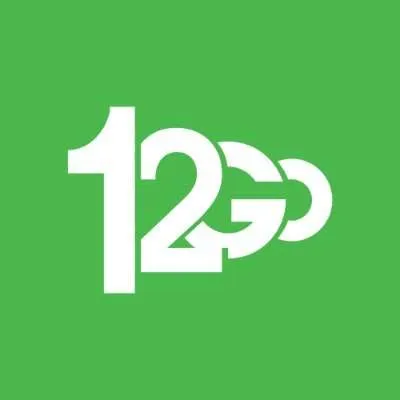
Check the prices here
Return to Arequipa Options:
- Guided Tours These tours removes the hassle of finding a transportation back to Arequipa.
- Bus Buses from Cabanaconde’s Plaza de Armas depart at 6:30 am, 9:30 am, and 1:30 pm, reaching Arequipa in 5–6 hours. Costs around S/26 ($6.50USD).
- Colectivo While less common, colectivos from Cabanaconde to Chivay and further to Arequipa are feasible. The bus to Chivay costs around S/5–10 ($1–2.50USD), followed by a colectivo to Arequipa for around S/20 ($5USD), offering a quicker alternative.
Choose the mode of transport based on your preferences for flexibility, directness, and travel time.
Wrapping Up
Trekking through Colca Canyon was a nice end to my Peru trip, and it’s one trip that you should do if you happen to be in Arequipa.
Whether you go with a guide or on your own, the incredible landscapes, encounters with condors, and the friendliness of the locals make it a trip to remember. The hike is tough but worth it, and the chance to relax in thermal baths adds a special touch.
Exploring the depths of Colca Canyon and enjoying its colorful surroundings turns this journey into not just a physical adventure, but a truly moving experience through one of Peru’s most beautiful places.
Related Posts

Peru is a country with diverse geography and climates, but this does not mean that it has great weather all year round. As a rule of a thumb, the best…
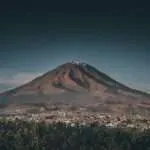
Are you looking for... the best insider tips to explore Arequipa, Peru? In this guide, I'll share my firsthand experiences and expertise, giving you a personal perspective on uncovering the…
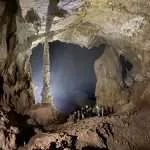
Hang Pygmy was a hike that was not even on my list until I had to move on to Central Vietnam. In Vietnam's breathtaking Phong Nha region, the Hang Pygmy…
Leave a Comment Cancel reply
Save my name, email, and website in this browser for the next time I comment.
Destinations
Remote work.
© Half Digital Nomad
Colca Canyon
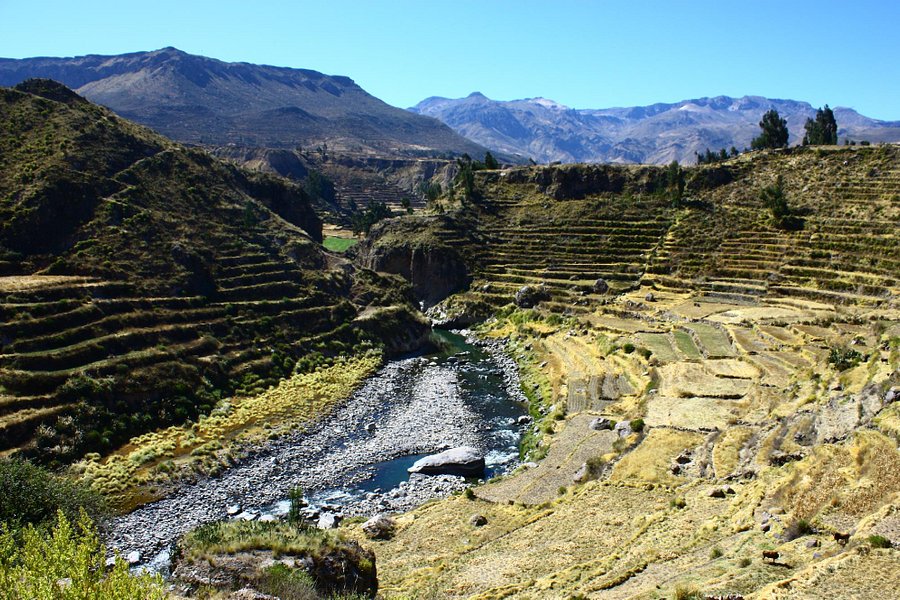
Most Recent: Reviews ordered by most recent publish date in descending order.
Detailed Reviews: Reviews ordered by recency and descriptiveness of user-identified themes such as waiting time, length of visit, general tips, and location information.
Also popular with travellers
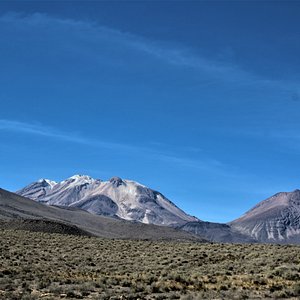
COLCA CANYON: All You Need to Know BEFORE You Go (with Photos)
- 2 Day 1 Night Trek / Colca Canyon (From £91.57)
- Full Day Tour / Colca Canyon (From £41.77)
- Colca Canyon: 2 Day Tour from Arequipa (From £178.32)
- 3 Day 2 Night Trek / Colca Canyon (From £115.66)
- Full Day Tour Including Transfer to Puno / Colca Canyon (From £89.96)
- (5.18 mi) Pachamama
- (5.12 mi) Hotel Kuntur Wassi
- (7.42 mi) Colibri Lodge
- (7.35 mi) La Casa de Roy Colca
- (7.47 mi) Posada Gloria
- (6.82 mi) La Granja Del Colca
- (5.12 mi) Kuntur Wassi
- (5.18 mi) Pachamama Bar- Woodfire Pizzeria
- (5.21 mi) Restaurant at La Posada del Conde
- (5.21 mi) Arum Qurpawasi Hotel & café-bar
Colca Canyon Trek Edgar
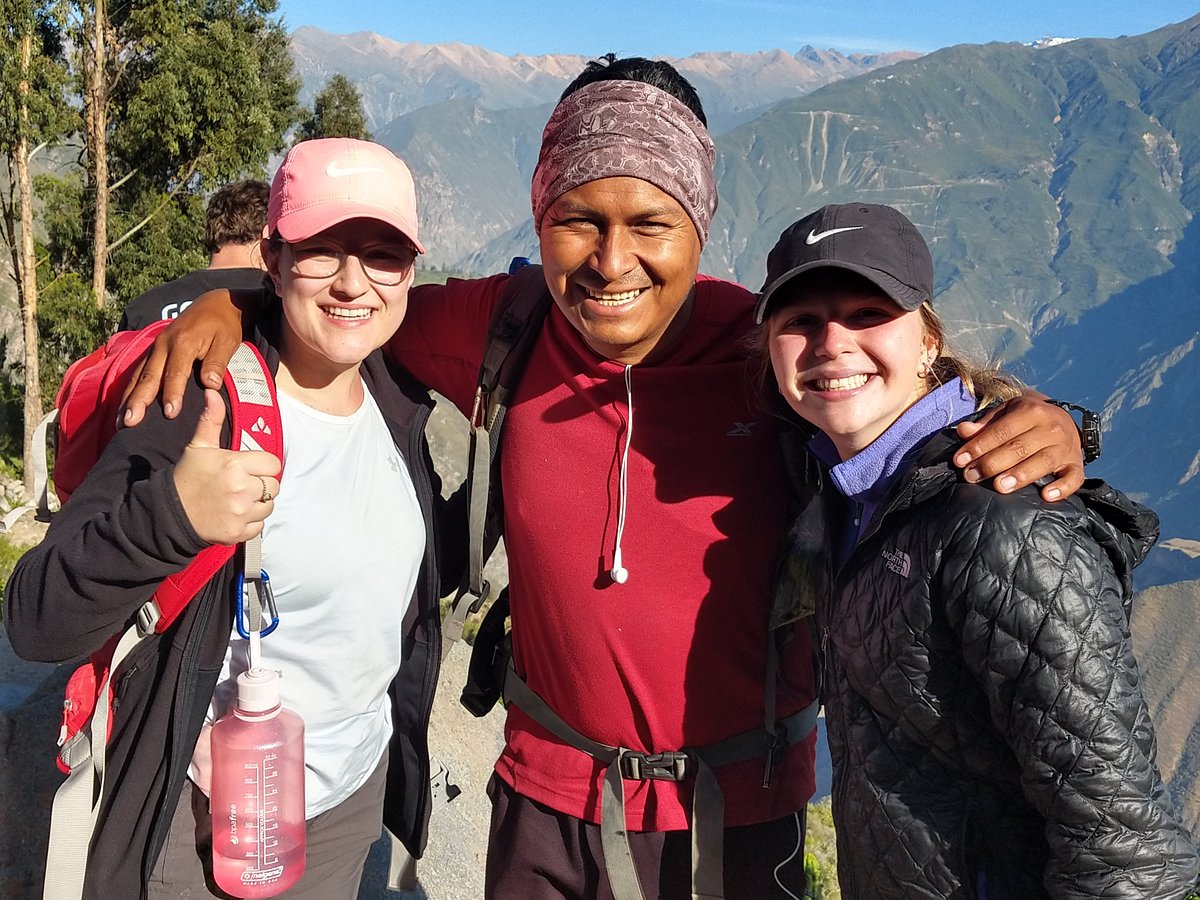
- See all photos
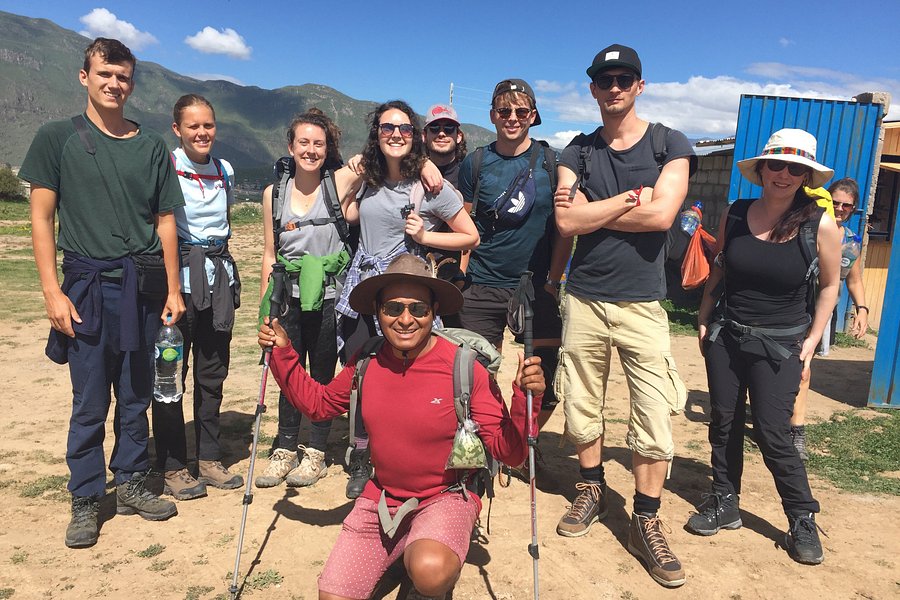
Similar Experiences

Most Recent: Reviews ordered by most recent publish date in descending order.
Detailed Reviews: Reviews ordered by recency and descriptiveness of user-identified themes such as waiting time, length of visit, general tips, and location information.
Colca Canyon Trek Edgar Guide - All You Need to Know BEFORE You Go (2024)
Hike | Arequipa | Peru
3-day colca canyon trek hiking guide (self-guided), text | anninka kraus photography | tobias kraus.

One of our favourite memories of Peru is the three-day/two-night hike into the Colca Canyon – Cañon de Colca in Spanish – one of the world’s deepest canyons. Located 220km northwest of Arequipa, the Colca Canyon is easily accessible (it’s still a long drive from Arequipa) and equally suitable for self-guided hikers and those preferring a guided or group hike experience.
After hiking in the famous Grand Canyon in Arizona just a few months earlier, we weren’t sure whether the much deeper Colca Canyon would measure up in terms of scenery. But it sure does. Like the Grand Canyon, the Colca Canyon is stunningly beautiful, albeit in a slightly different way. Both canyons are arid, but the Colca Canyon seems less so, almost lush by comparison really, as locals still cultivate the stepped terraces, growing corn and avocado.
And whereas the Grand Canyon seems to be this desolate, uninhabited wilderness (there’s only one remaining tribal village in Grand Canyon National Park, inhabited by the Havasupai people), the Colca Canyon is home to several communities allowing hikers an insight into rural Peruvian everyday life.
Hiking in the Colca Canyon is also a different experience from hiking in the Grand Canyon and much more comfortable. Instead of very basic campsites, the Colca Canyon boasts lovely guest houses with hot showers, beautiful home-cooked meals, and thermal baths.
Both canyons did have one thing in common, however, and that was the lack of wildlife. Maybe we were just unlucky because there were actually plenty of alpacas roaming the high plains on the drive to Cabanaconde. But once we started hiking, the only wildlife we saw over the three days was a couple of small birds. If you‘re lucky, though, you might see Andean condors soaring above the canyon. We didn’t, but plenty of people join day tours from Arequipa to two lookout points on the rim of the canyon specifically to see condors.
Contrary to some online accounts we’ve read, we believe hiking the Colca Canyon is pretty straightforward and easily doable self-guided for experienced hikers (if you download gpx files for offline use). You could almost get away with carrying a small day pack actually. Of course, this being a canyon with a 1600m elevation difference between the rim and the canyon floor on day 1, you obviously need to pack some warm clothes. But with comfortable accommodation options available in several places, you’ll hardly need to pack anything else at all. You’ll also frequently pass through small communities as you walk through the canyon along the Rio Colca, with plenty of opportunities to stock up on snacks and drinks.
The only aspect of this hike that might require a little thought and planning is choosing the transport options between Arequipa and Cabanaconde that best fit your needs (see “Where and getting there” in trail details). And don’t forget to download the gpx files of this trek for offline use. There are few trail markers, if any, and navigating the opening stretch, in particular, wasn’t easy, with parts of the trek destroyed by a fire, it appeared.
There are several routes into the canyon, but if you follow this 3-day/2-night circuit itinerary, starting from and finishing in Cabanaconde, you’ll be spending your first night in Llahuar and the second in San Juan de Chuccho. It’s the longest loop you can hike in the canyon, with a total trail distance of 30km. That might not seem like a lot, stretched across 3 days, but there’s a 1000m elevation gain to tackle as well.
Also, with the Colca Canyon located 220km from Arequipa, you need to allow for a 4-6 hour journey to and from the canyon on days 1 and 3 – unless, of course, you stay in Cabanaconde before and after your hike, which I wouldn’t recommend because the scenery inside the canyon is far more special. Gazing up at the sheer rock walls as daylight faded, the light grew softer, and the shadows longer was incredible.
trail info.
Start/End: Cabanaconde (you’ll most likely arrive from and return to Arequipa) Route: Day 1 Cabanaconde – Llahuar Day 2 Llahuar – San Juan de Chuccho Day 3 San Juan de Chuccho – Cabanaconde Distance: 30km total trail distance Time: 3 days (total hiking time incl. small breaks: 10 hours) Difficulty: moderate; but exposed to the weather and steep altitude gain on day 3, from 2395m at the bottom of the canyon to the rim at 3430m. If you hike often, you won’t find this difficult, but someone who doesn’t might struggle with the steep 1000m elevation gain. Options: in addition to this 3-day/2-night Colca Canyon itinerary, there are plenty of other shorter hikes into the canyon. Permits: To hike in the canyon, you apparently need to purchase a 7-day entrance permit for S/.70. We asked at several places in Cabanaconde, but couldn’t find anyone to sell us a permit. Maybe this was because we hiked in low season, I’m not really sure, but we didn’t pass a ranger’s station anywhere either.
1. Laguna 69
Out & back trail | 5-6 hours
2. Santa Cruz Trek
Point-to-point trail | 3 days
3. Inca Trail (guided hike)
Point-to-point trail | 4 days
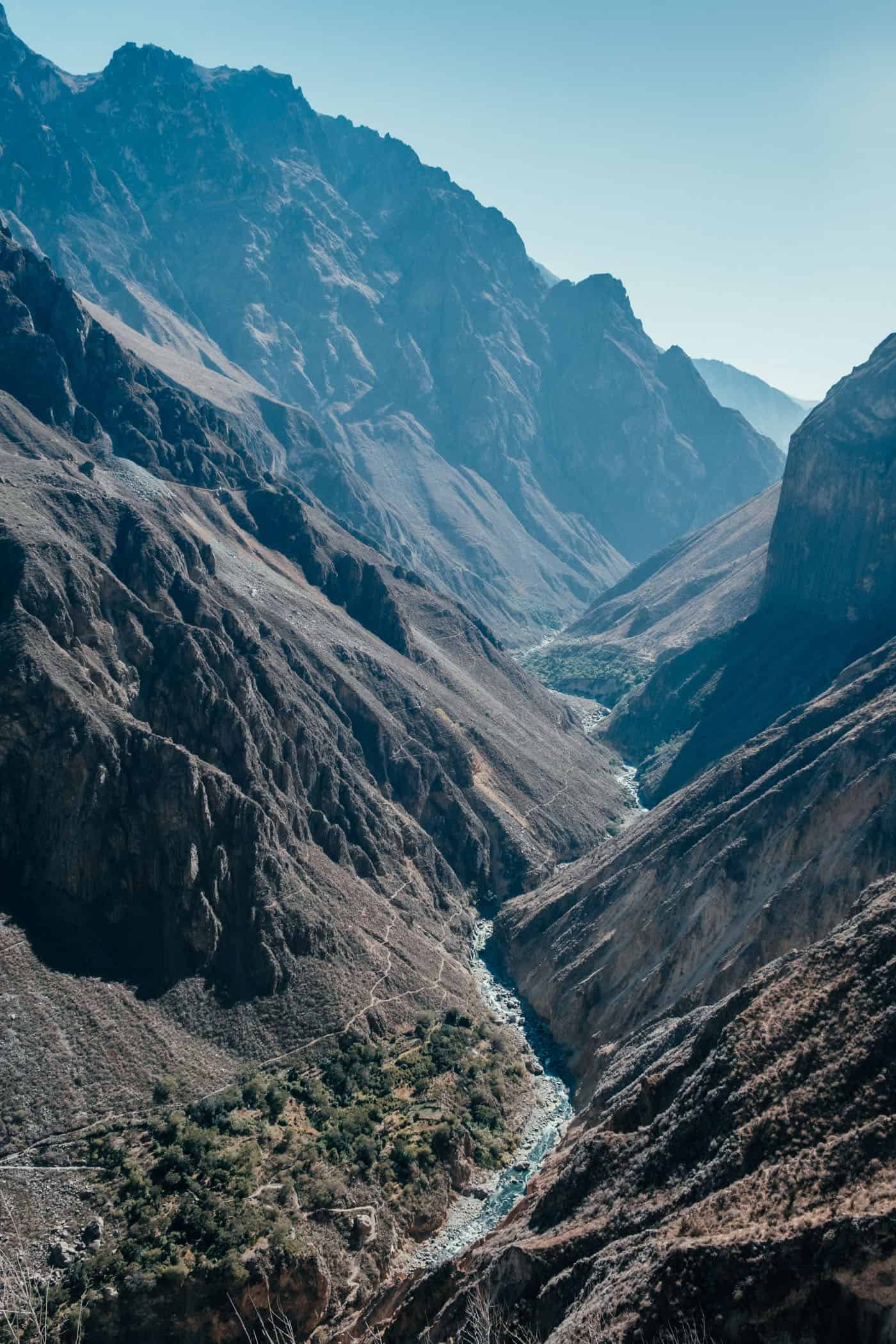
At the very bottom, where the sheer canyon walls meet, the Rio Colca is nestled among lush greenery.
What to expect..
A three-day/two-night hike into one of the world’s deepest canyons
A hike that is equally suitable for self-guided hikers and those preferring a guided or group hike experience
Super comfortable stays in guesthouses with hot showers, beautiful home-cooked meals, and thermal baths
You’ll pass through several local communities, giving you insight into rural Peruvian everyday life
location & trail information.
Where and getting there: Before and after your hike in the Colca Canyon, you’ll probably be staying in Arequipa, 220km from Cabanaconde, which is the start and end point of this hike. To get to Cabanaconde from Arequipa, you can take the bus departing from the Arequipa Bus Terminal or a minivan to Chivay – Transportes Centella, for instance, leaving from Av. Andrés Avelino Cáceres – and then change to a colectivo to Cobanaconde. The same on the way back. We opted for the minivan/colectivo combination because the bus leaves very early and still gets to Cabanaconde late, as it stops at various points along the way. If you take the minivan instead, you can leave at 8 am and still have plenty of time to walk to Llahuar that day. It’s much quicker, and we thought the minivans/colectivos in Chivay were well coordinated. We didn’t have to wait long for one to depart for Cabanaconde or for Arequipa on the way back. Get off the colectivo in the main square – Plaza de Armas – in Cabanaconde and follow the road that runs past Mirador de Achachihua to the starting point of the trek on the outskirts of town. There are very few trail markers at the start of this trek if any, and I doubt we’d have found the trail quickly without using GPS or a map. On day 3, when you climb out of the canyon from San Juan de Chuccho, you’ll meet a road where you need to turn right, towards Cabanaconde. It’s a 20-minute walk on the road into town where colectivos for Chivay depart from the main square.
Where to eat: Breakfast is included in the room price at both hotels we stayed at and was very nice; they also serve dinner (vegetarian option available) and cold drinks; throughout the day, you can stock up on snacks and drinks at small kiosks along the way.
When to go: In the dry season – May to October – when there’s little chance of rain. Nights are colder at that time though and it’s peak season so you might have to book accommodation further in advance. I wouldn’t want to hike this trek in the rainy season, especially the slippery, steep downhill sections, but if that’s when you’re going, taking hiking poles will be useful.
How to prepare: You need to be reasonably fit and well-acclimatized to higher altitudes before attempting to hike to the Colca Canyon Trek. Spending at least 1-2 nights in Arequipa at 2335m will help you acclimatize and make your hike more enjoyable. Book your accommodation online . At Llahuar, there are only two hotels, so you definitely want to book ahead. Take warm clothes, as nights might be cold and swimwear if you think you might want to jump into the hot pools in Llahuar. Take only a small daypack/backpack and leave the rest of your luggage at your hotel in Arequipa.
Cabanaconde - Llahuar
On day 1, you’ll pass through some farmland just outside Cabanaconde with great views from the rim into the canyon, before the trail starts zig-zagging downhill, rather steeply in some places. Taking hiking poles will help on the slippery bits with lots of loose gravel and sand.
Once you’ve reached the canyon floor and crossed a bridge to the other side of the Rio Colca, you’ll soon after arrive in Llahuar. It’s a tiny place with just two hotels, but both serve dinner and have beautiful gardens with fantastic river views.
track details.
Start: Cabanaconde End: Llahuar Distance: 9.6km Time: 3.5 hours Elevation gain: 430m / loss: 1610m (lowest point: 2110m / highest point: 3290m) Difficulty: easy – moderate
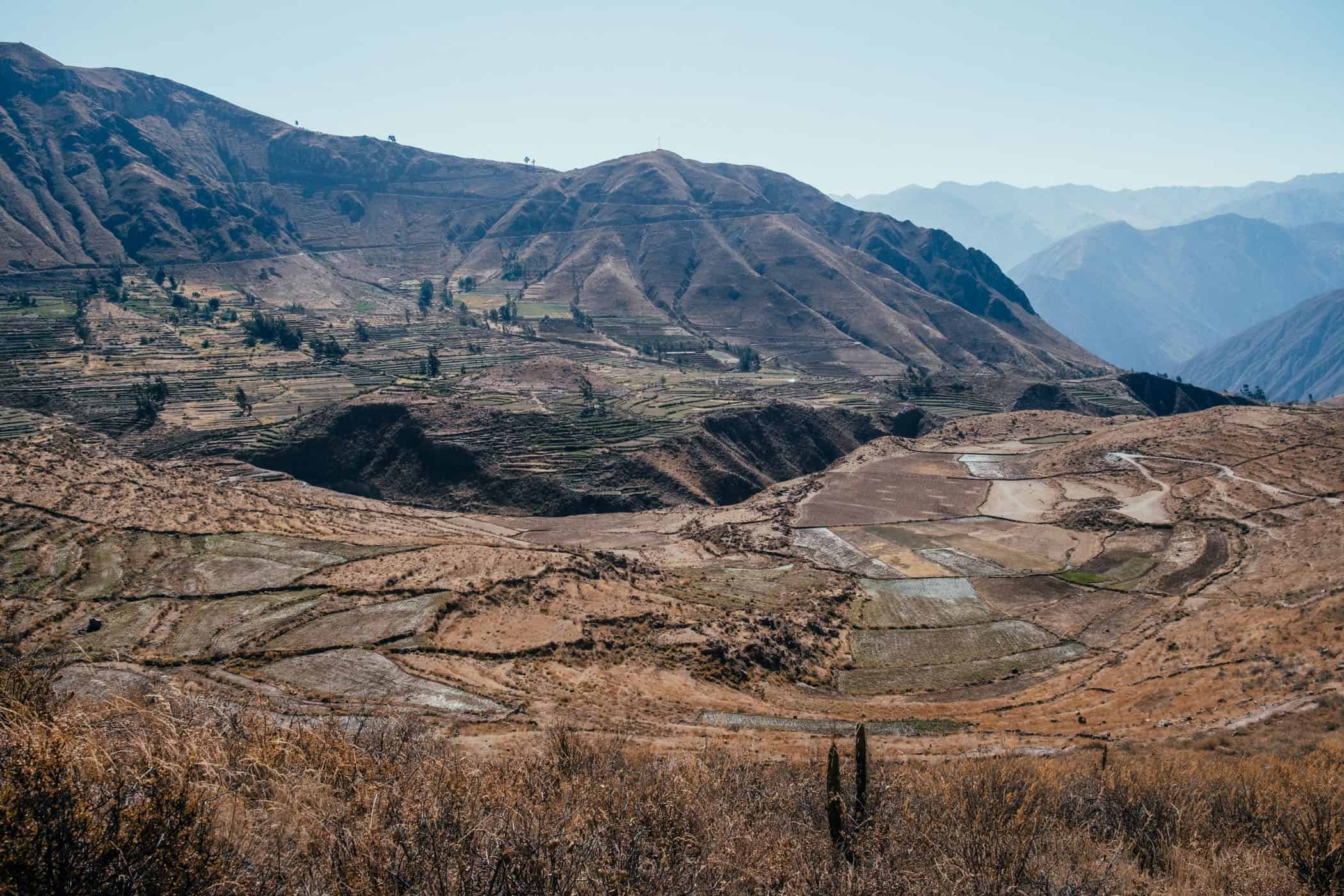
Colca Canyon Trek map - day 1
Llahuar - san juan de chuccho.
Day 2 for us was a lovely, leisurely walk through the canyon. We were in no rush and stopped often to take photos and soak up the views, because it was such a short day hiking.
Even with all the breaks, we arrived in San Juan de Chuccho by noon and spent all afternoon on the balcony sipping mango juice. If you’re keen to cover some extra distance, maybe add a side trip to Sangalle – nicknamed the “Oasis”.
It seems to be the most popular spot inside the canyon with most guided groups spending the night there. We had thought about visiting Sangalle, but then skipped it because the reviews of the hotels there didn’t seem too promising and there’s not much to do unless you stay the night.
Start: Llahuar End: San Juan de Chuccho Distance: 12.3km Time: 4 hours Elevation gain: 840m / loss: 515m (lowest point: 2110m / highest point: 2815m) Difficulty: easy
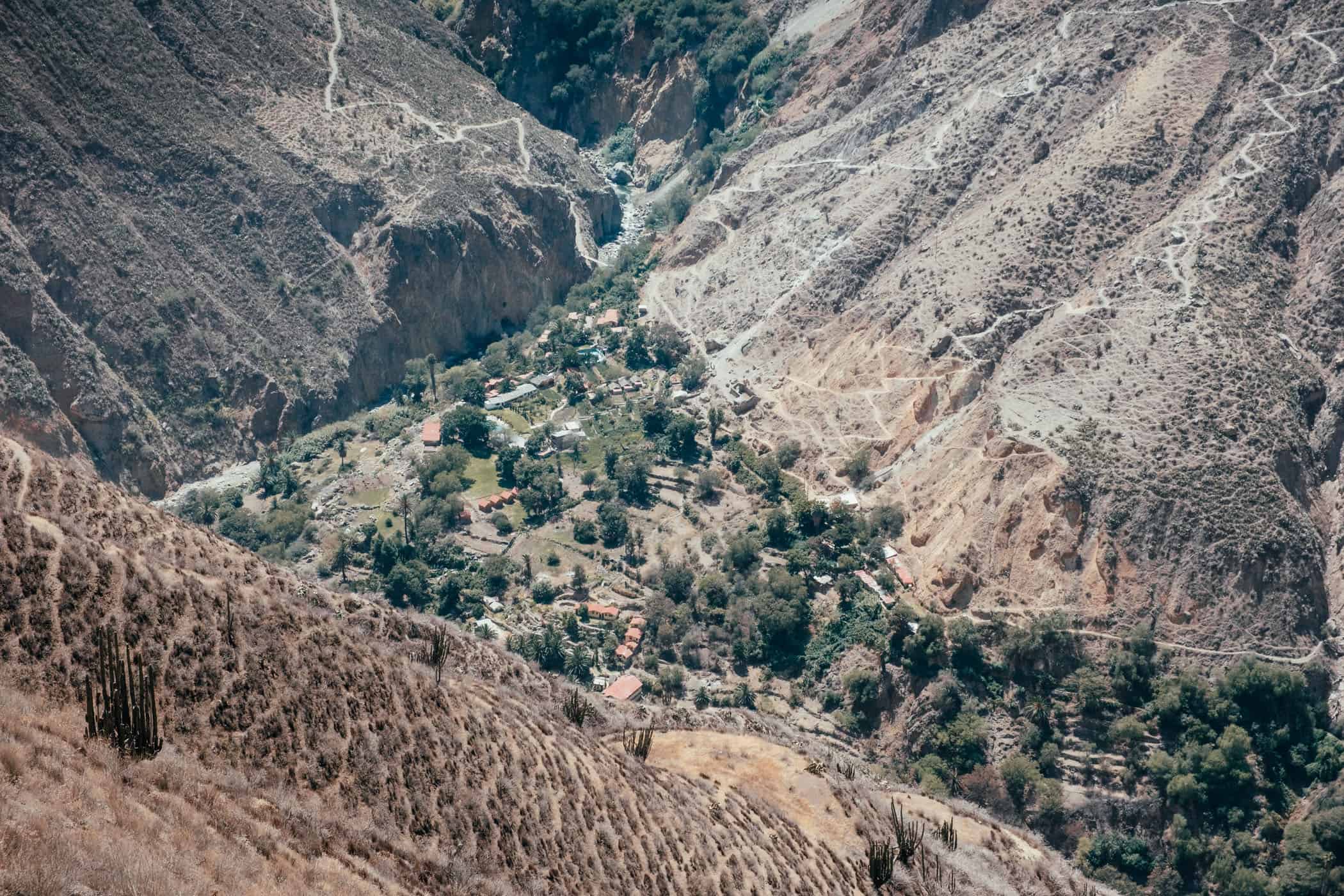
Colca Canyon Trek map - day 2
San juan de chuccho - cabanaconde.
Day 3 is the most physically challenging as the trail gains 1000m in elevation to the rim. There’s not much else to say really – it’s a relentless, steep uphill climb for 2-4 hours, depending on your level of fitness.
The views are still splendid, however, and if you hike regularly and are well-acclimatized to higher altitudes, you won’t find this too challenging. Stock up on all the water you need in San Juan de Chuccho because you won’t be passing any streams on the way up.
Start: San Juan de Chuccho End: Cabanaconde Distance: 7.9km Time: 2.5 hours Elevation gain: 1090m / loss: 215m (lowest point: 2395m / highest point: 3430m) Difficulty: moderate – difficult
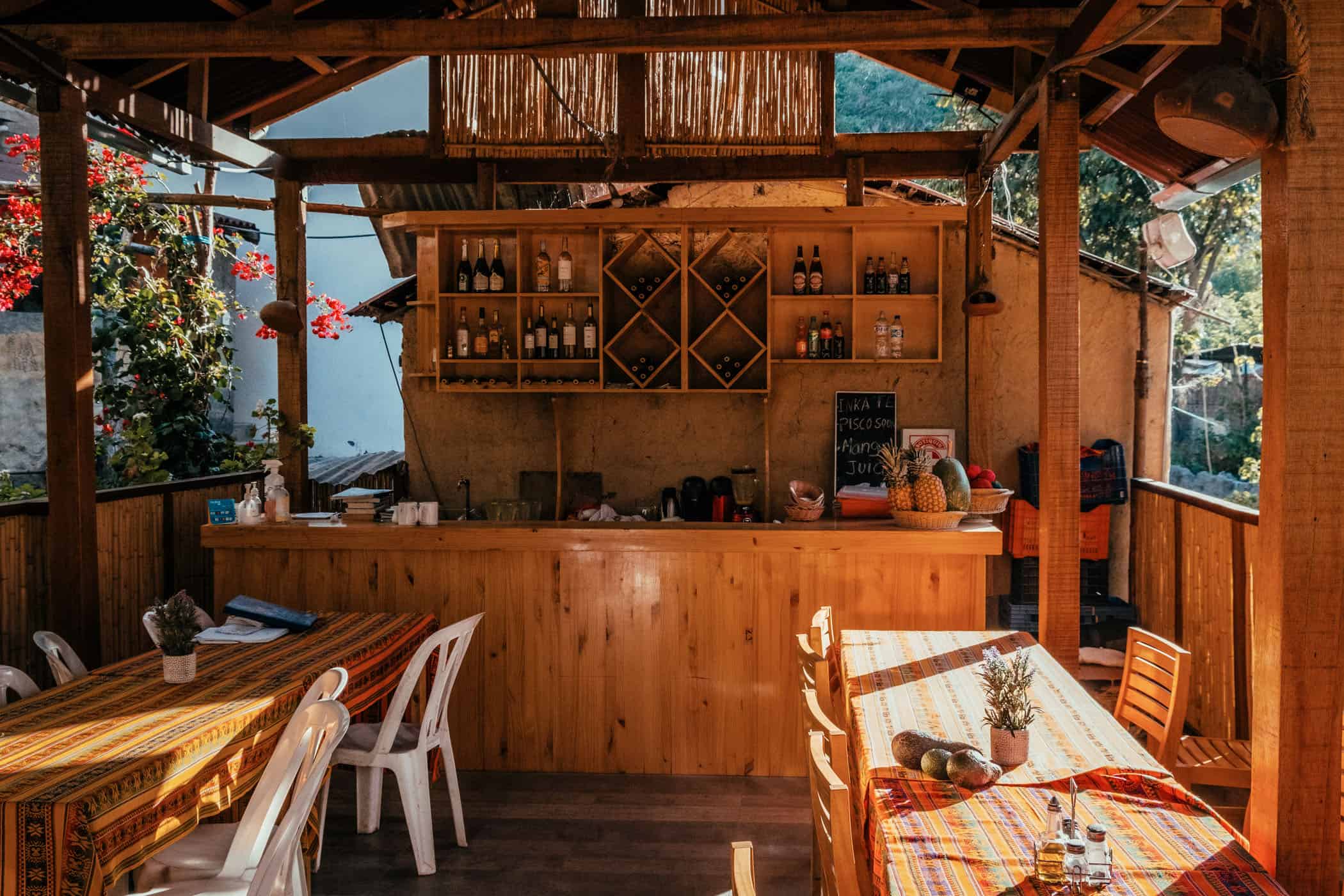
Colca Canyon Trek map - day 3
Visiting denali state park and hiking the curry ridge trail, delicate arch hike in arches national park, devils garden trail with landscape arch (full circuit).

Colca Canyon 2-Day Trek: Guide To Arequipa’s Best Hike
Not sure how to do the Colca Canyon trek? Worry not.
Colca Canyon, the second deepest canyon in the entire world , is one of the best places to visit in Peru. At a depth of 3270m deep, it is twice the depth of the Grand Canyon in the United States. However, most travelers come to Peru strictly for Machu Picchu, completely ignoring the fact that one of Peru’s best hikes is just a bus ride away. Don’t skip Colca Canyon. In our guide, we will give you all the information you need to determine whether hiking Colca Canyon is worth it, where to find tours, what you need to pack, and lastly, our experience doing the 2 day Colca Canyon trek !
Is Colca Canyon Worth Hiking?

Before you take out your credit card or run to the nearest tour agency to book your Colca Canyon hike, is Colca Canyon even worth the visit?
The answer is an unquestionable YES! (That is why I wrote this guide to be fair!)
Hiking Colca Canyon is one of the best things to do in Peru , as it allows you to experience some of the most gorgeous mountainous landscapes of Peru. Its depth, at twice that of Grand Canyon’s, is absolutely unworldly.
Not only that, but hikers can also see the condors with their own eyes, a type of bird that is sacred to the Incans. They believe that condors are messengers of the skies or Heaven.
Hiking Colca Canyon is both a cultural and physical experience that must not be missed in Peru!
Guide To Colca Canyon 2-Day Tour
The map above is the route that all 2 days 1 night Colca Canyon trekking tour takes. It starts close to Cabanaconde, heads down towards San Juan De Chuccho for lunch, then finally to Sangalle Oasis for the first day . On the second day, you return back to Cabanaconde through a different route.
The 3-day 2-night tour also takes the same route, but you stop at Sangalle Oasis on the second day instead of the first.
Trekking Colca Canyon Tour Companies

The 3 days 2 nights Colca Canyon tour stops at all the same places as the 2-day 1-night tour, but the days are much shorter and you will have more chances to enjoy nature in Colca Canyon.
You will still visit Yanque, the hot spinrgs, and the Mirador Cruz del Condor. It is highly recommended if you are a beginner hiker or have a few weeks in Peru !
Want to secure your Colca Canyon tour before you arrive? Here are some tours we recommend:
- Colca Canyon day tour
- Colca Canyon 2 day tour
- Colca Canyon 3 day tour
DIY Your Colca Canyon Trek
We didn’t do the Colca Canyon trek on our own so we can only give an outside point of view. It seems it is fairly easy to DIY as long as you know the routes. The accommodations along the route can be easily booked in advance on booking.com .
However, we recommend having at least some experience with hiking in remote areas, as well as a high level of Spanish because no one will speak English out there. You will also need to brave the unreliable Peruvian public transportation, especially in those regions.
If you are planning on doing the Colca Canyon trek yourself, we recommend that you install offline maps from maps.me and Alltrails.
Colca Canyon Trek Packing List
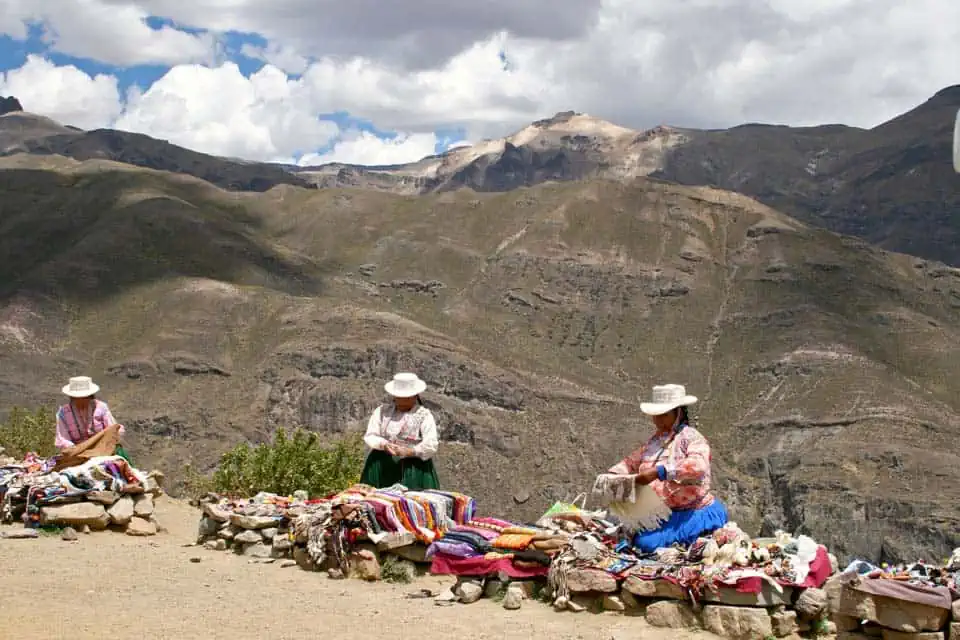
The Colca Canyon hike is not so tough in terms of difficulty (at least that’s what we thought). However, if you are doing the 2 days 1-night trek, you will suffer extreme sunny conditions on the first day and extremely cold conditions on the morning of the second day.
Therefore, I recommend packing some of these essentials:
- Sunscreen – You will be hiking in the sun for about 6 hours in the sun with no shade. Bring one or look like a tomato.
- Toiletries – Make sure you have toilet paper. It is not provided by the accommodation.
- Swimsuit – There is a swimming pool in the Sangalle Oasis where you can swim after your first day of hiking.
- Cash – There are places to buy water and snacks on the hiking trail. Also, there is a 70 soles entrance fee to the Colca Canyon that must be paid in cash.
- Portable Battery – Electricity is shut down in the accommodations after 8 PM. Not sure if that is because we got a cheaper tour or if that’s with every tour company
- Warm clothing – When you are in the valley of the canyon, it can get really cold when the sun is not out.
- Snacks and Water – There are snacks and water for sale along the way but they will be 3 times the normal price.
- Light Portable Travel Camera – One of my favorite portable cameras that gets the job done! You don’t want to miss the photo opportunities at Colca Canyon!
- Hiking Poles – Hiking poles are not only essential to the Colca Canyon trek, but for any hiking in Peru . We recommend you to get a nice quality one if you plan on exploring the mountains in Peru.
Our Experience Hiking Colca Canyon In 2 Days
Day 1 of colca canyon trek: descent to the sangalle oasis.
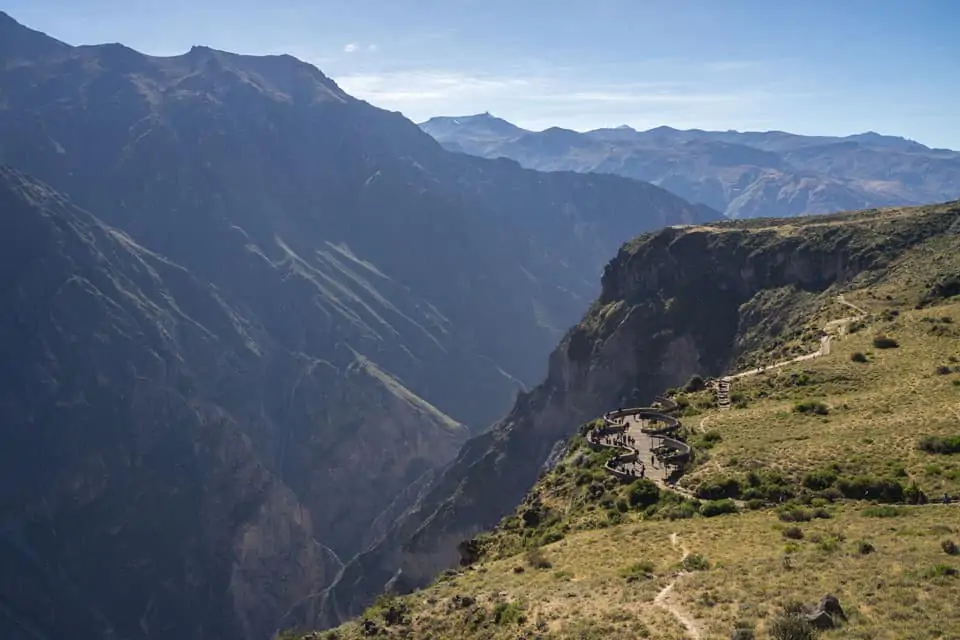
Los Andes Bed & Breakfast is one of the best hostels in Arequipa. Located next to the main plaza (Plaza de Armas), guests can have easy access to the best attractions in Arequipa. The continental breakfast is included. 24-hour reception. The common area is very social to meet other travelers. A great option for backpackers.
Best Luxury Hotel in Arequipa – Katari Hotel At Plaza de Armas
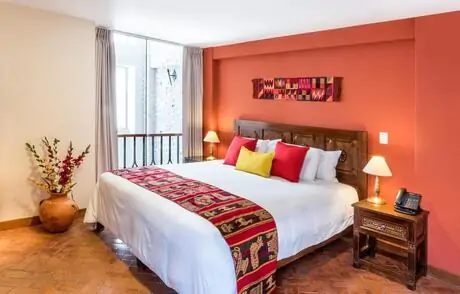
Located in Plaza de Armas right across from the historic cathedral, Katari Hotel is the best place to view the architectural masterpiece. The roof provides a panoramic view of the city that is better than any viewpoint you can find. The rooms are clean, spacious, and well-lit. The breakfast included is phenomenal.
Hiking Colca Canyon FAQs
Can you hike colca canyon without a guide, is the colca canyon hike difficult.
Like this post? Don’t forget to save it on Pinterest!
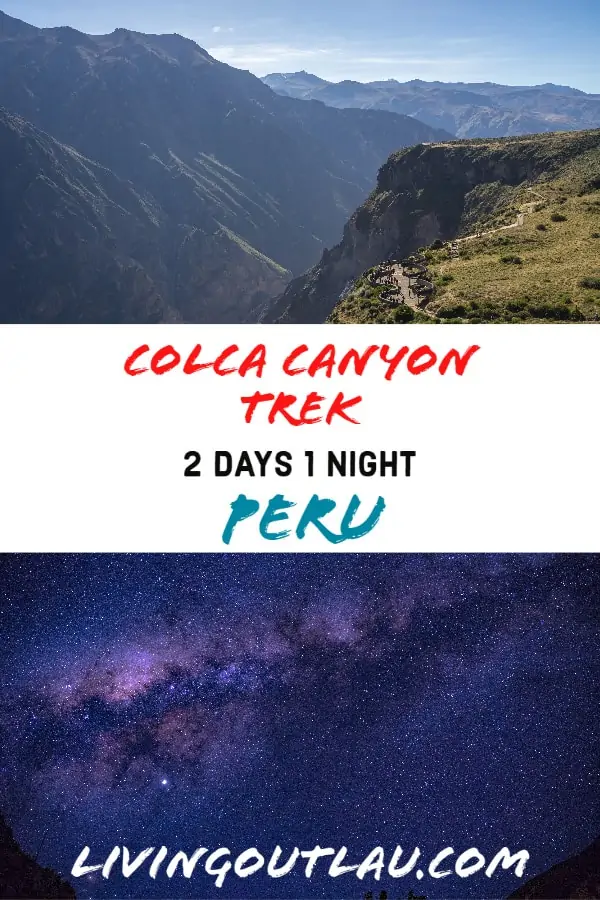
I hope this guide answers all the questions you have about doing the Colca Canyon 2 day trek with a tour company. Colca Canyon was definitely one of the best hikes I have done in Peru. Don’t miss it!
Disclaimer: Some of the links above are affiliate links. That means if you book or make a purchase through the links, we will earn a small commission at no extra cost to you ! The money will help run this site! Thank you !
World Traveler, Travel Blogger, Photographer
LivingOutLau
Sean is the founder of the travel blog, LivingOutLau. He has been to over 30 countries in over 5 years of travel. Every day, he is traveling and sharing his discoveries of the world through exceptional travel guides on his blog!
Leave a Comment Cancel reply

IMAGES
VIDEO
COMMENTS
What Exactly Is The Colca Canyon Trek? Based 130+ miles outside of the beautiful city of Arequipa, the Colca Canyon is, according to who you're talking to, either the world's second deepest canyon or not even Peru's deepest canyon*.Either way, it's pretty bloody deep (3,300 metres at one point), pretty bloody impressive, and is DEFINITELY twice as deep as America's Grand Canyon
What is the Colca Canyon Trek? The Colca Canyon is the 3rd deepest canyon in the world. Arguably. There's apparently a lot of controversy over what exactly constitutes a canyon. It sits about 3-4 hours (driving distance) outside of Peru's white city- Arequipa. This makes the canyon an easy addition to everyone's Peru itinerary.
Colca Canyon Cost. In total our independent 5 day Colca Canyon trek, for 2 people, minus beers (which are of course optional) cost us 556 soles (or 278 soles per person). That's about $80 USD or £63 each. Here's a complete Colca Canyon cost breakdown: Colca Canyon hiking permit which lasts 5 days = 70 soles each.
Move over the Grand Canyon: there's a much more impressive canyon in town. Peru's Colca Canyon is the world's second deepest, measuring in at around 3,400m at its deepest point - twice as deep as the Grand Canyon. Epic it most certainly is, and a hike into the depths of this colossal fissure is a fascinating - and physically ...
To book the 2 day Colca Canyon tour with Arequipa Tour - Operator Peru, simply contact them on Whatsapp (+51 519 596 88125). Otherwise, drop into their office in Arequipa ( Calle Jerusalén 311A, Segundo Piso, Office #6) to find out more information. Also, feel free to check them out on Facebook and Instagram.
My Overnight Colca Canyon Trek review. The 2 days we spent in Colca Canyon were a highlight of the Peru trip for me but they were also super challenging and exhausting. The Colca Canyon 2 day hike is 100% worth doing, the landscape is incredible and the feeling of achievement reaching the top on Day 2 justifies the early start and hard effort.
Final thoughts on Visiting the Colca Canyon; Review of the 2 day 1 night guided trek of the Colca Canyon: Day 1: Distance hiked: 15KM. Elevation loss: approximately -1000m. Degree of Difficulty: 8 out of 10. After visiting the beautiful city of Arequipa, I set off on a 2 day 1 night trek of the Colca Canyon. Overall, this is one of the most ...
Recommended if you are short on time but would still like to trek into the canyon. Route: Cabanaconde > Sangalle Oasis > Cabanaconde. Overnight: Sangalle. Distance: about 5 mi (8 km) roundtrip. The well-trodden trail to the oasis known as Sangalle is a very popular Colca Canyon 2 day trek.
You can choose between a 1 or 2 day tour by van without the Colca Canyon trek or a 2 to 3 day tour including the Colca Canyon trek. Most tours start at 3 AM to ensure you can see the condors in action at 8 AM. The 1 and 2 day tours by van will stop at some viewpoints and villages on top of the canyon such as Chivay, Yanque and Cabanaconda.
Colca Canyon hike day 1. The trek for the first half of day 1 is mostly descent into the Canyon which starts at 3287 metres above sea level. To put this into perspective, the peak of the highest mountain in Great Britain (Ben Nevis) is only 1345. The landscape swallows you up and the blue, green and orange tones of the canyon are striking.
3-Day, 2-Night Colca Canyon Trek This extended adventure, spanning three days and two nights, follows the familiar route of the 2-day trek but introduces a strategic overnight stay in San Juan, which is the lunch stop on the 2-day trek. ... Honest Review of the 2 Day, 1 Night Colca Canyon Tour. Day 1. The day kicked off crazy early at 3:00 am ...
According to Tripadvisor travellers, these are the best ways to experience Colca Canyon: 2 Day 1 Night Trek / Colca Canyon (From £91.57) Full Day Tour / Colca Canyon (From £41.77) Colca Canyon: 2 Day Tour from Arequipa (From £178.32) 3 Day 2 Night Trek / Colca Canyon (From £115.66) Full Day Tour Including Transfer to Puno / Colca Canyon ...
Apr 28, 2024 - Colca Canyon trek is a service managed for Edgar Almiron, who is an experienced trekking guide. He been working in the Colca Canyon for over 12 years and is willing to show travelers the best.
Day 2 Llahuar - San Juan de Chuccho. Day 3 San Juan de Chuccho - Cabanaconde. Distance: 30km total trail distance. Time: 3 days (total hiking time incl. small breaks: 10 hours) Difficulty: moderate; but exposed to the weather and steep altitude gain on day 3, from 2395m at the bottom of the canyon to the rim at 3430m.
Day 2 of Colca Canyon Trek, Uphill to Cabanaconde. At 4:30 AM, we started our hike toward Cabanaconde. Day 1 was all descending, so logically day 2 was all uphill. Sangalle is located at 2,100m above sea level while Cabanaconde is located at 3287m above sea level. In 3-4 hours, we ascended more than 1100 m.
With a rating of 5.0 based on 8 reviews, the Colca Canyon trek has received glowing feedback from adventurers on Viator and Tripadvisor. Travelers have raved about their experience, highlighting the following aspects: Breathtaking Scenery: Reviewers have marveled at the natural beauty of Colca Canyon, often referring to it as a hidden gem. The ...